Trip Experiences of our 14 Day Biblical Israel & Jordan Tour
September 3-16, 2025
Downloads:
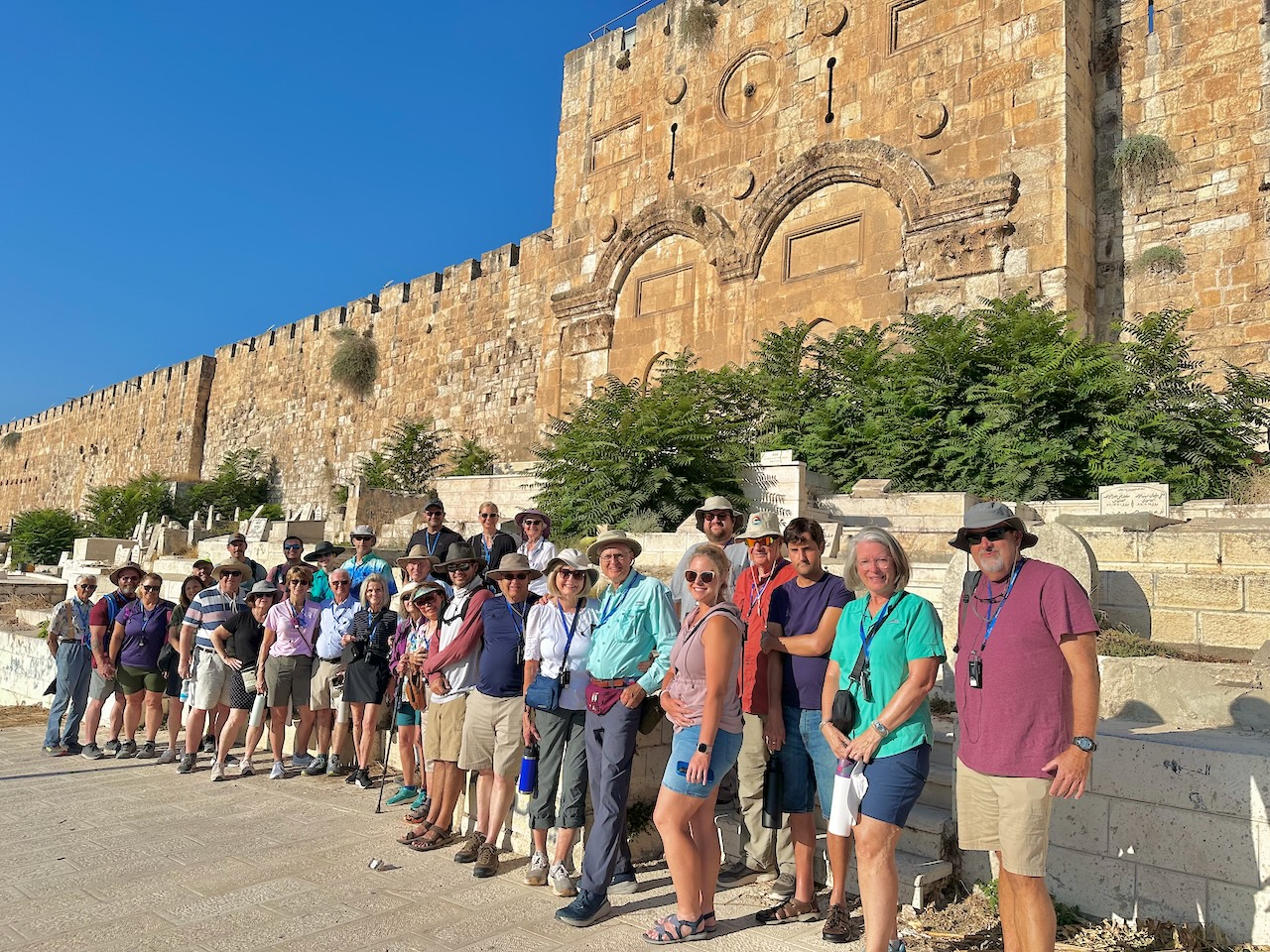
"Life transforming Israel tours & teaching in the context of the land of the Bible"
Group Photos
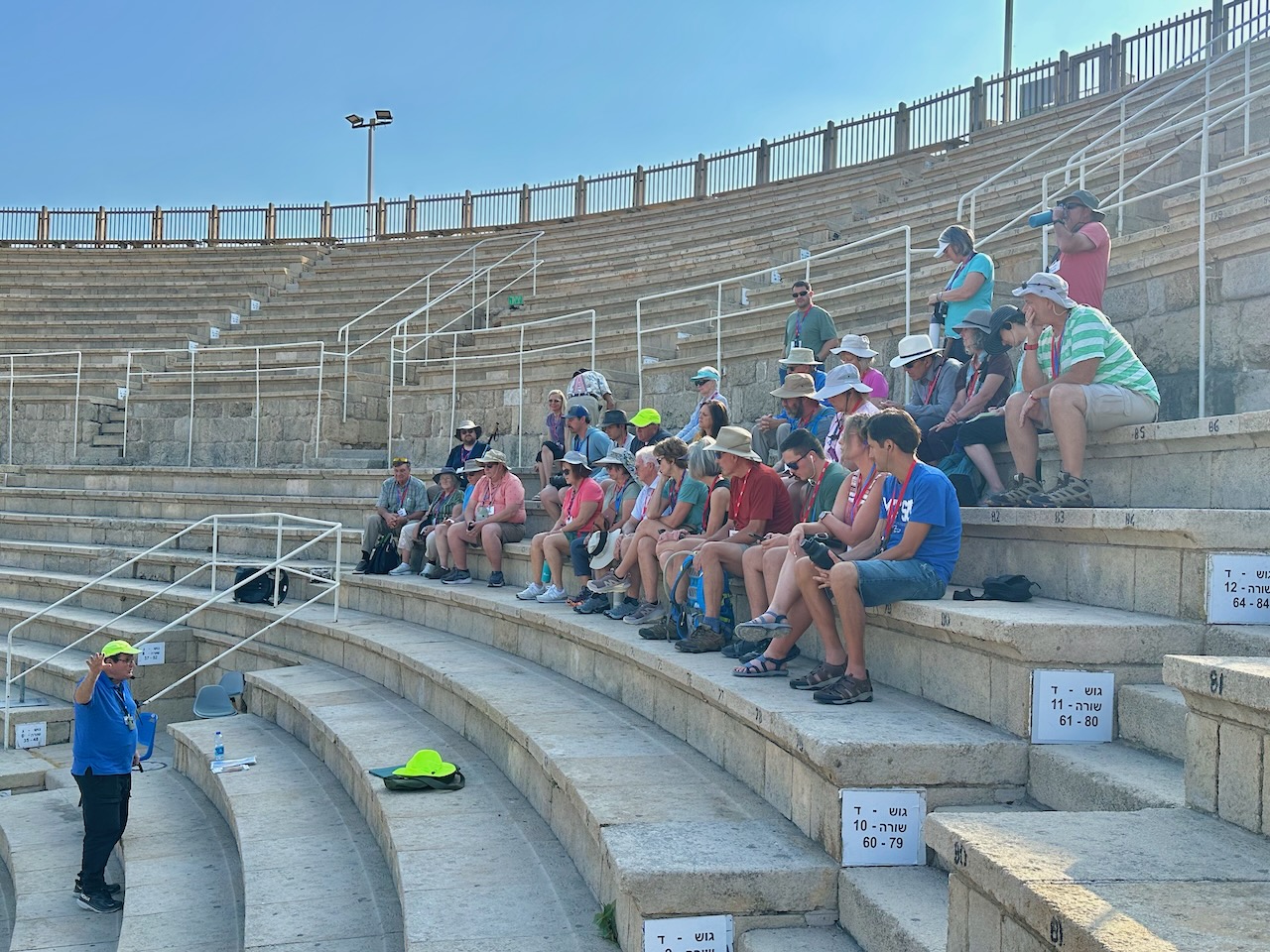
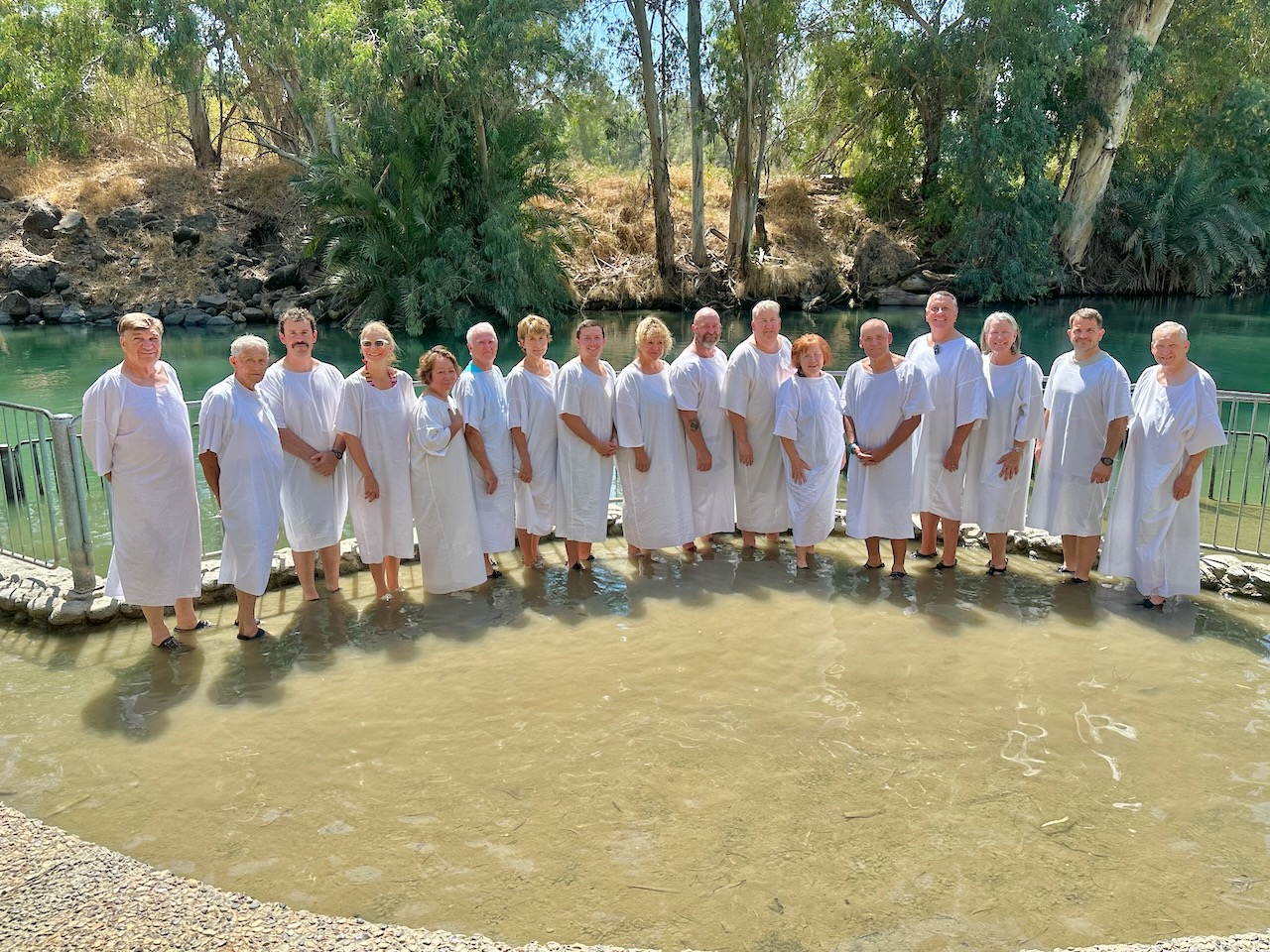
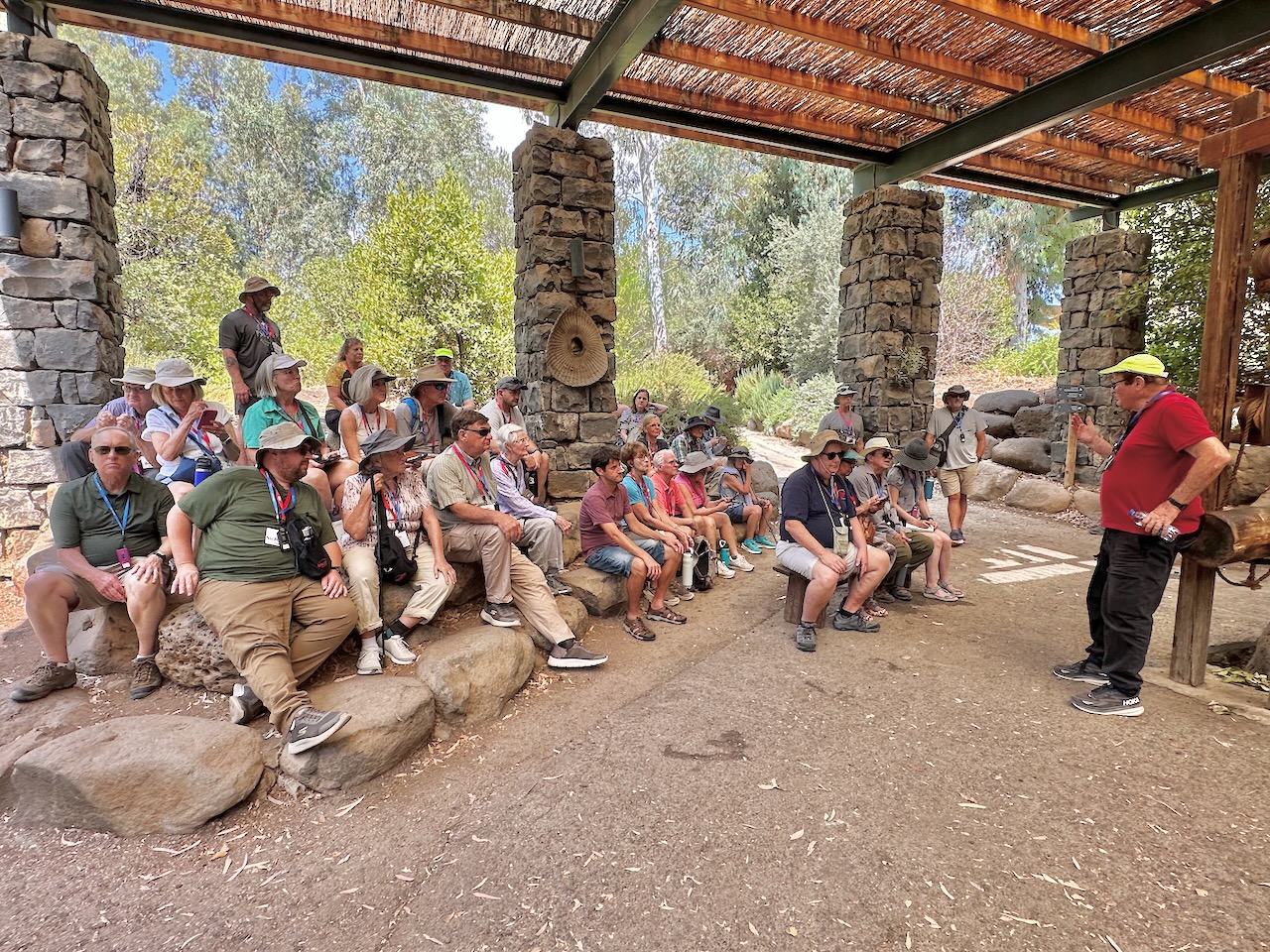
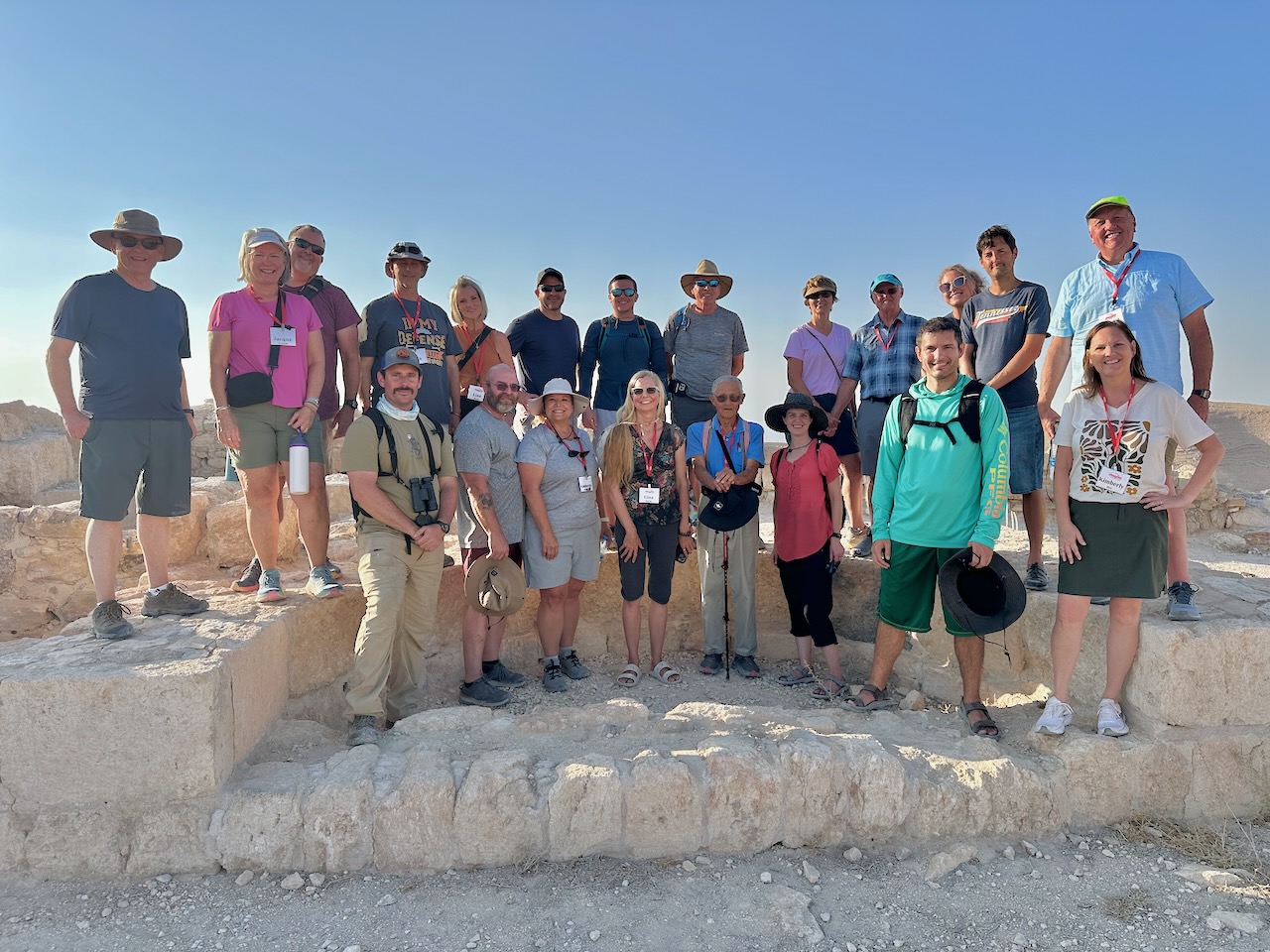

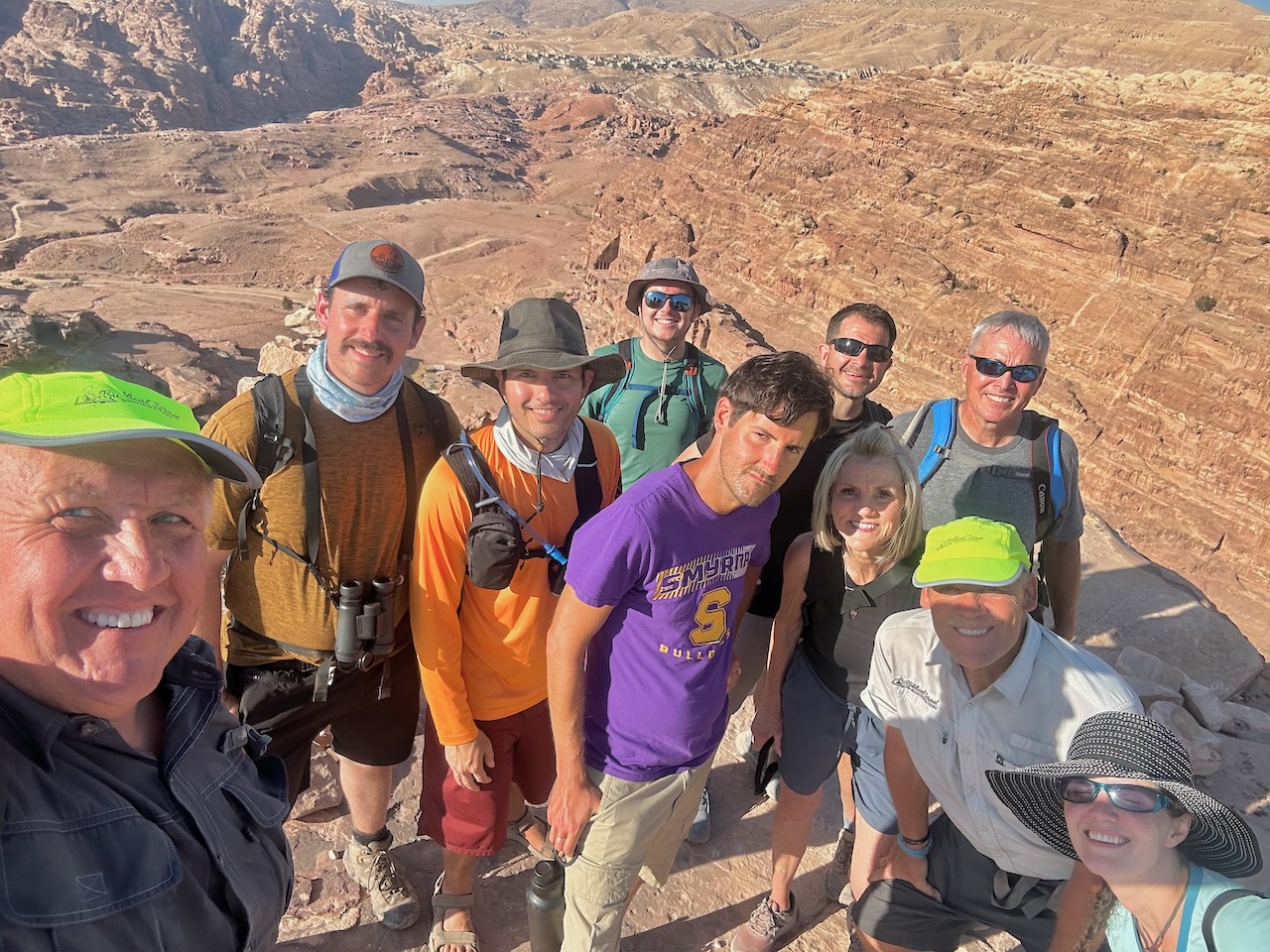
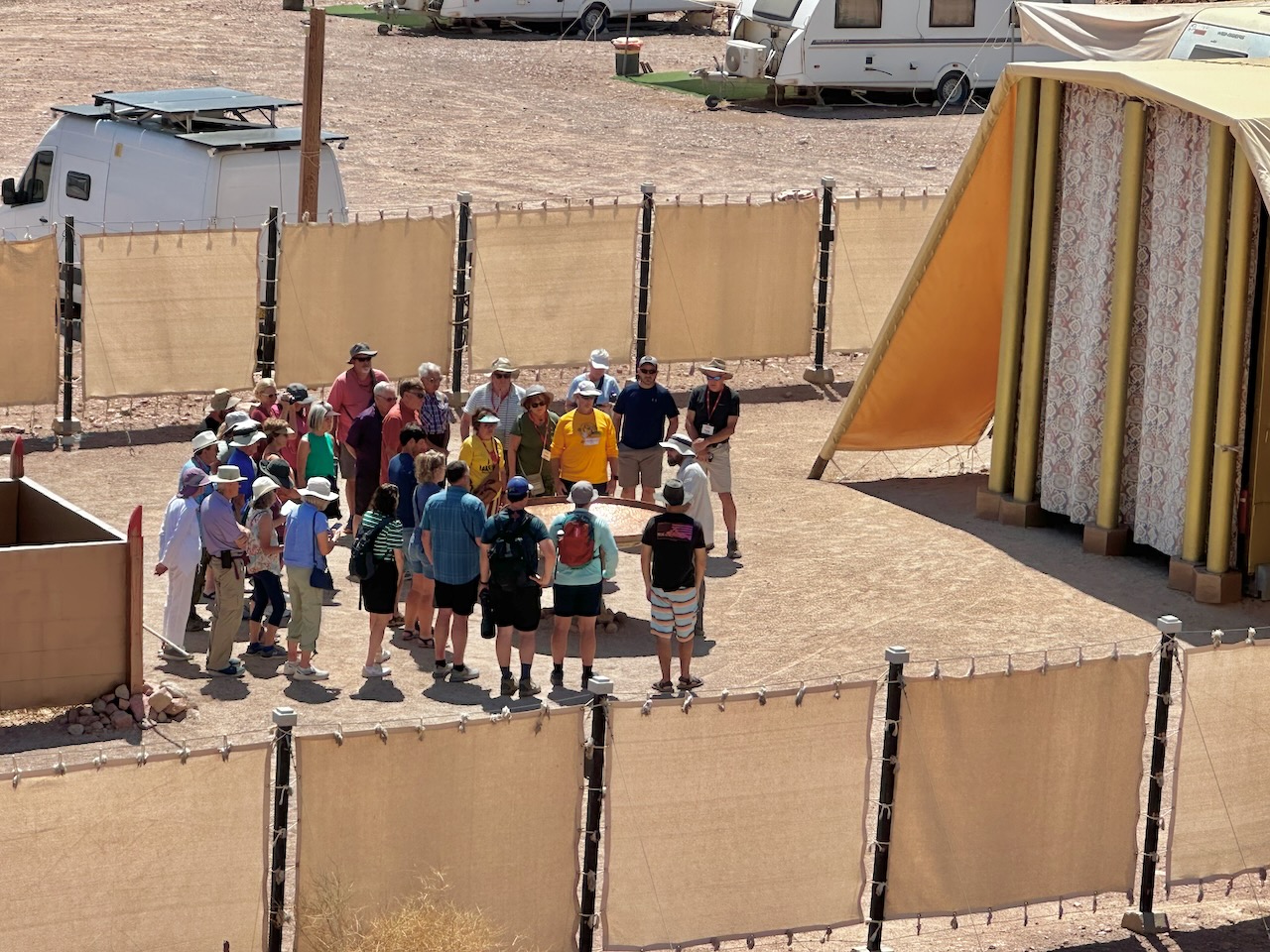
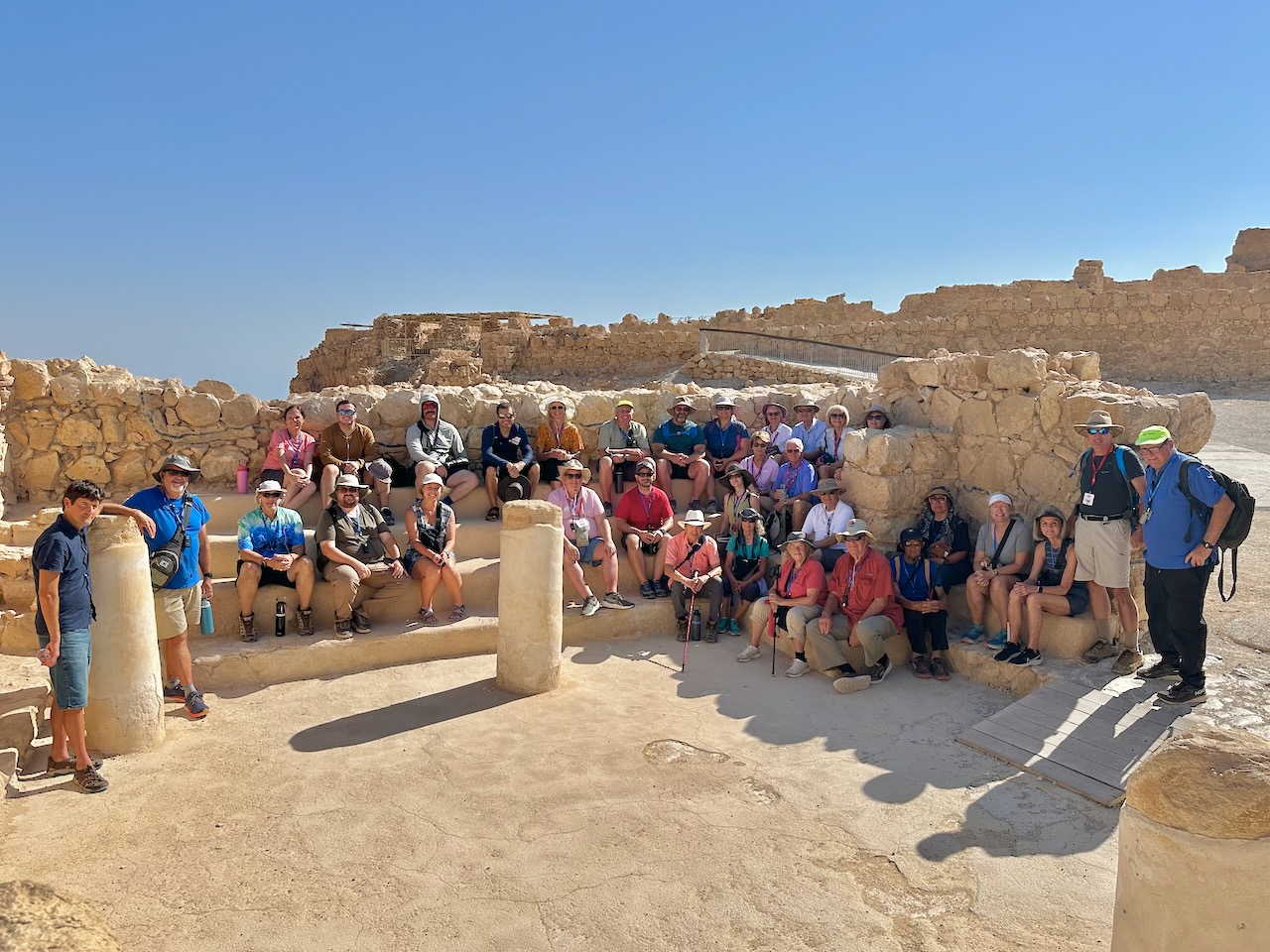
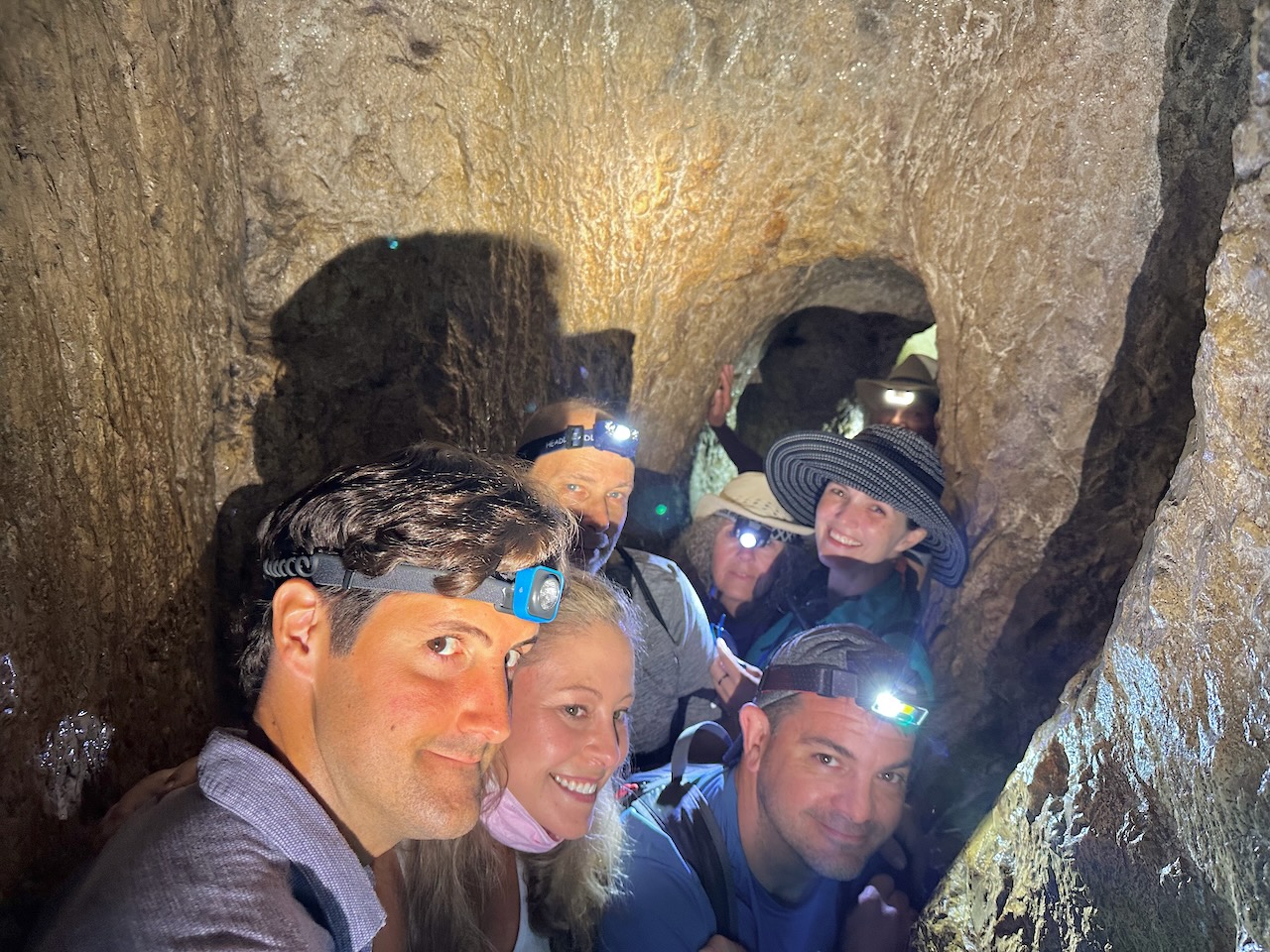
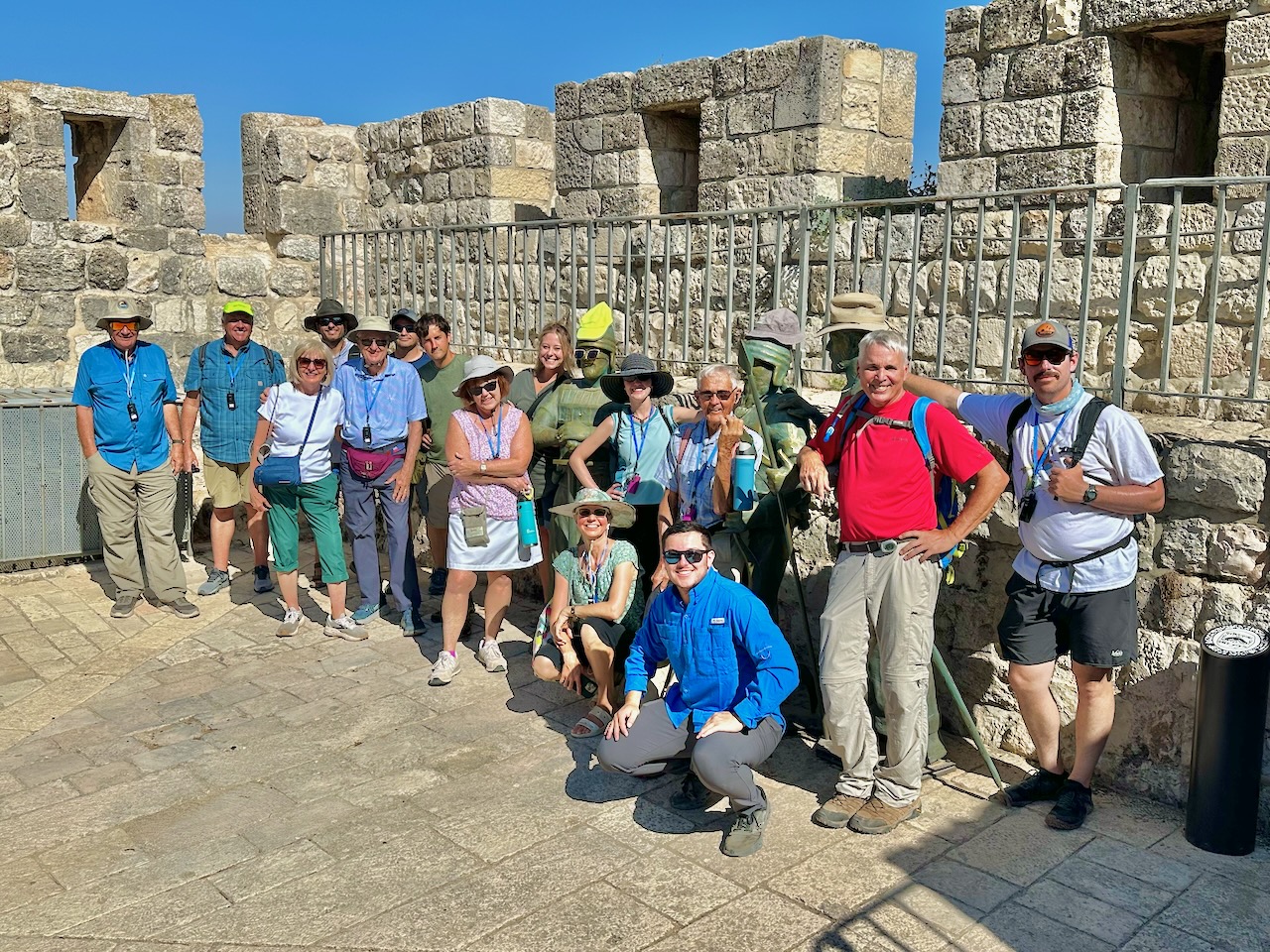
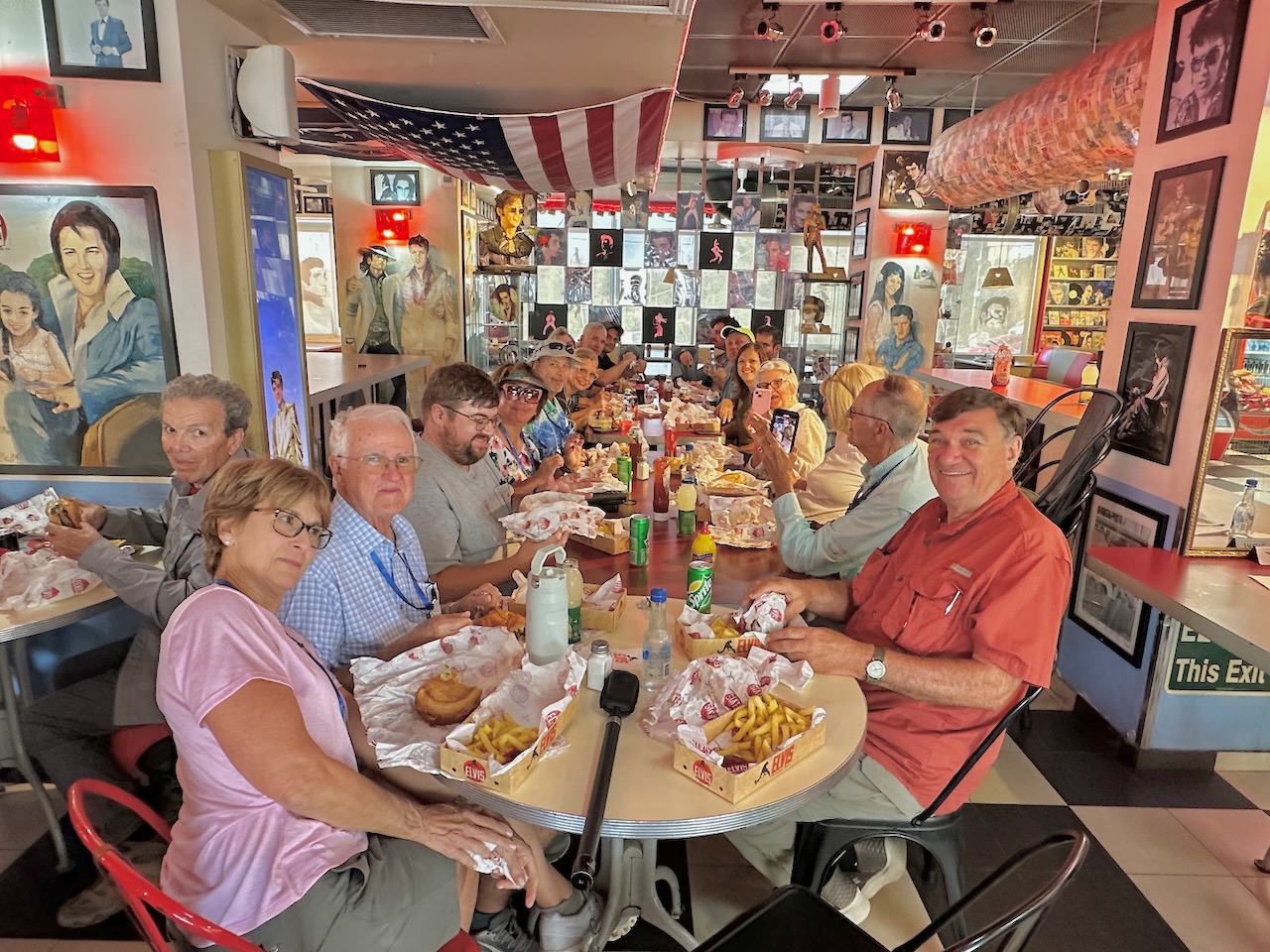
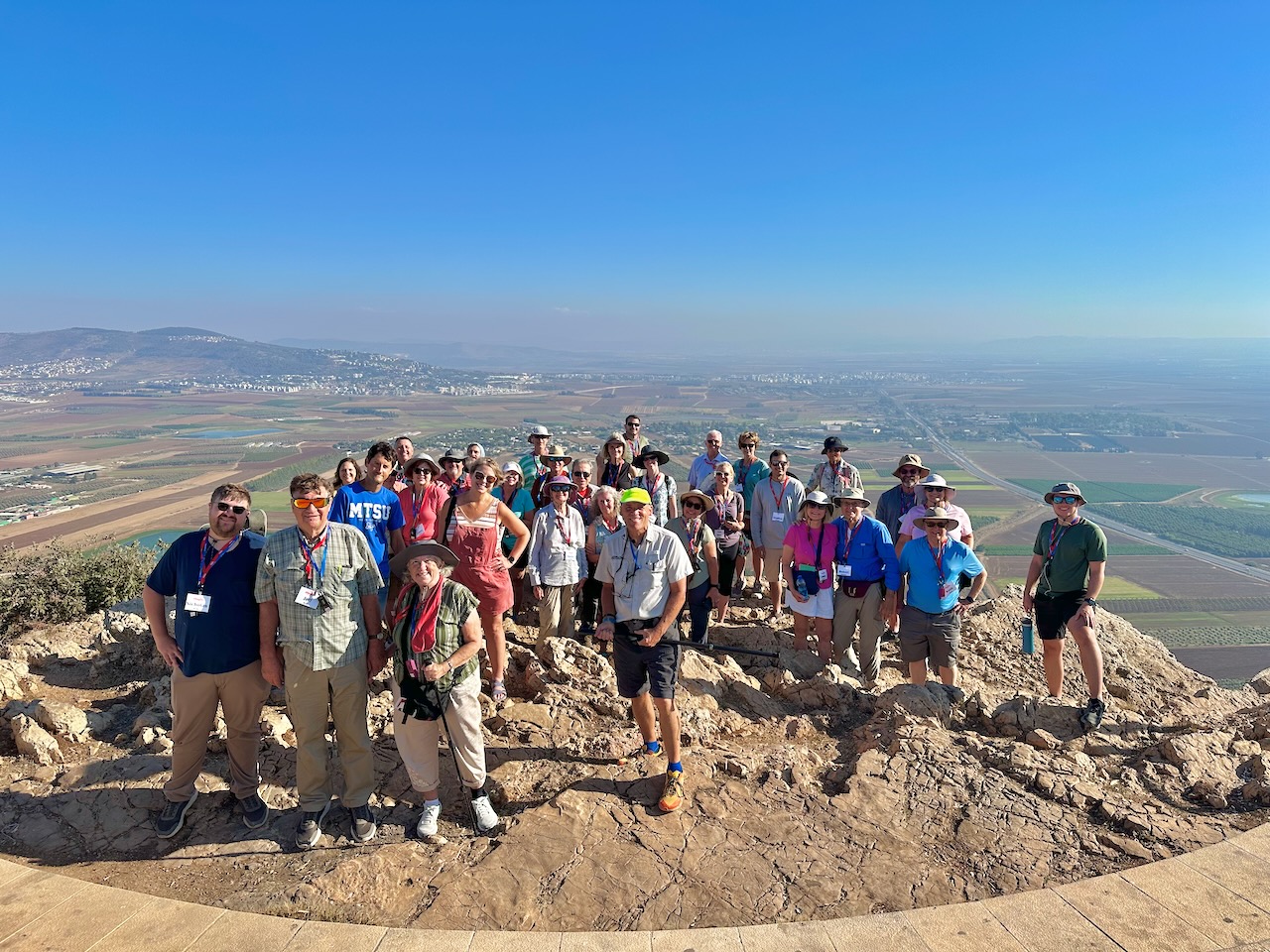
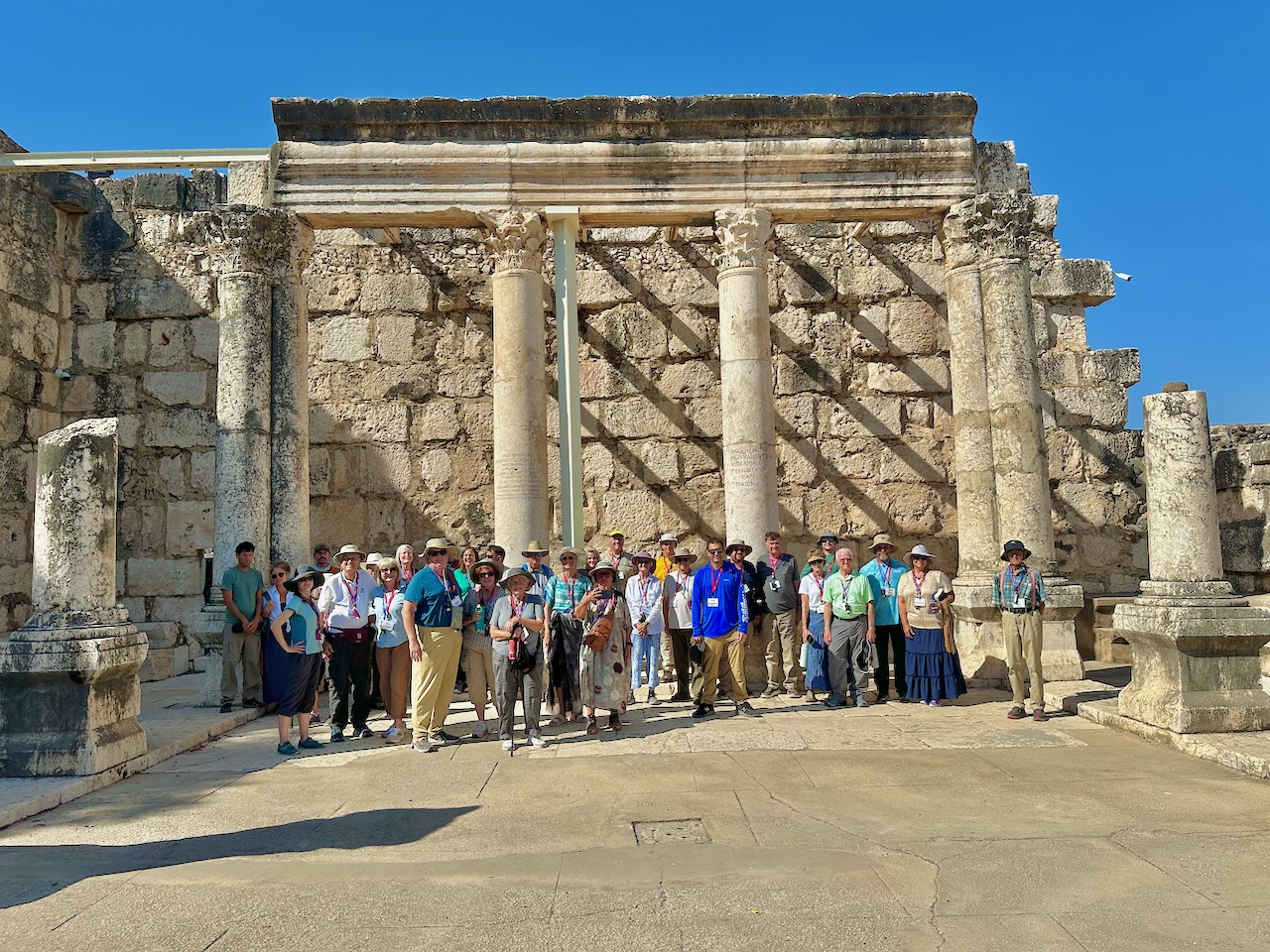

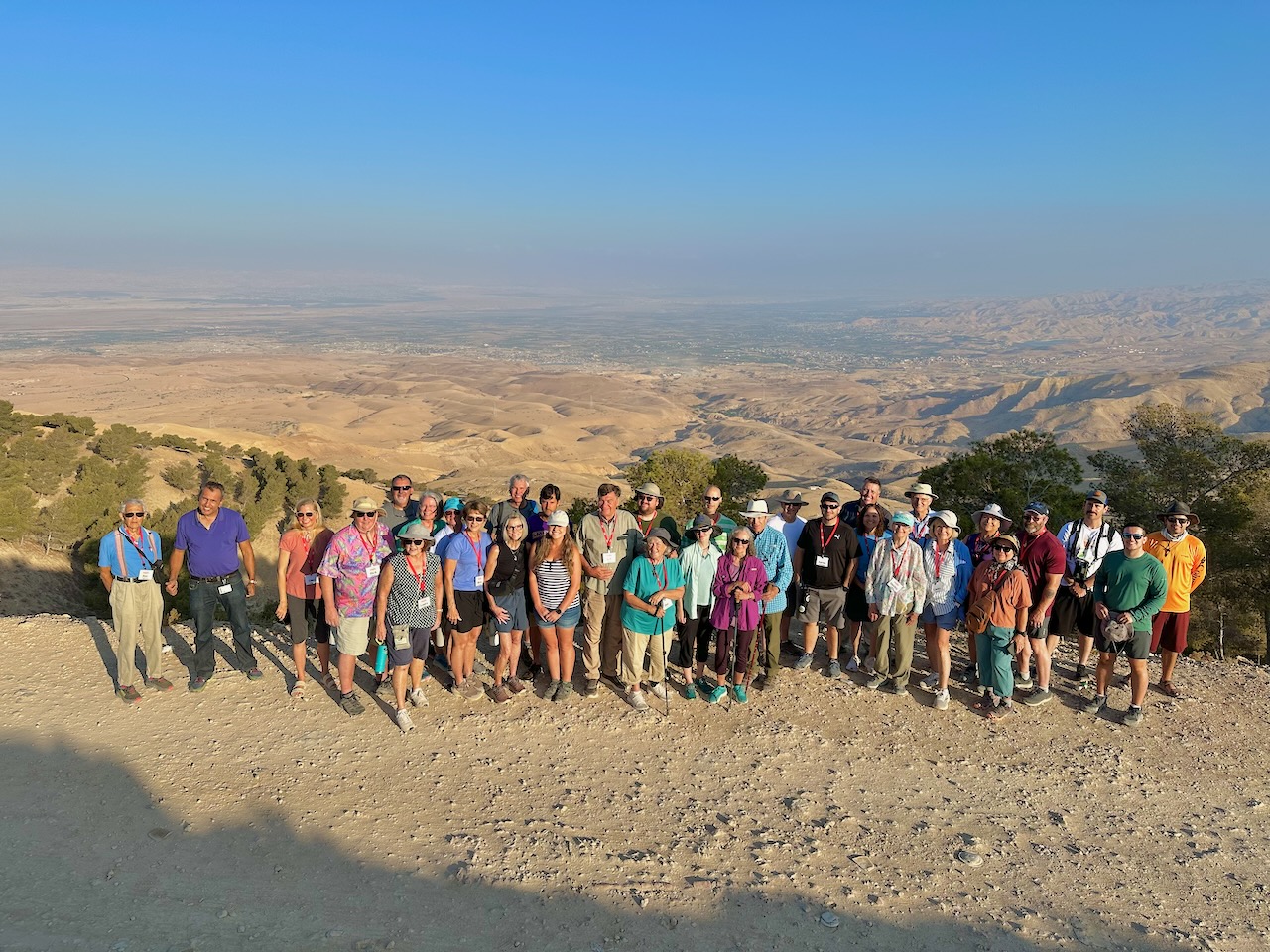
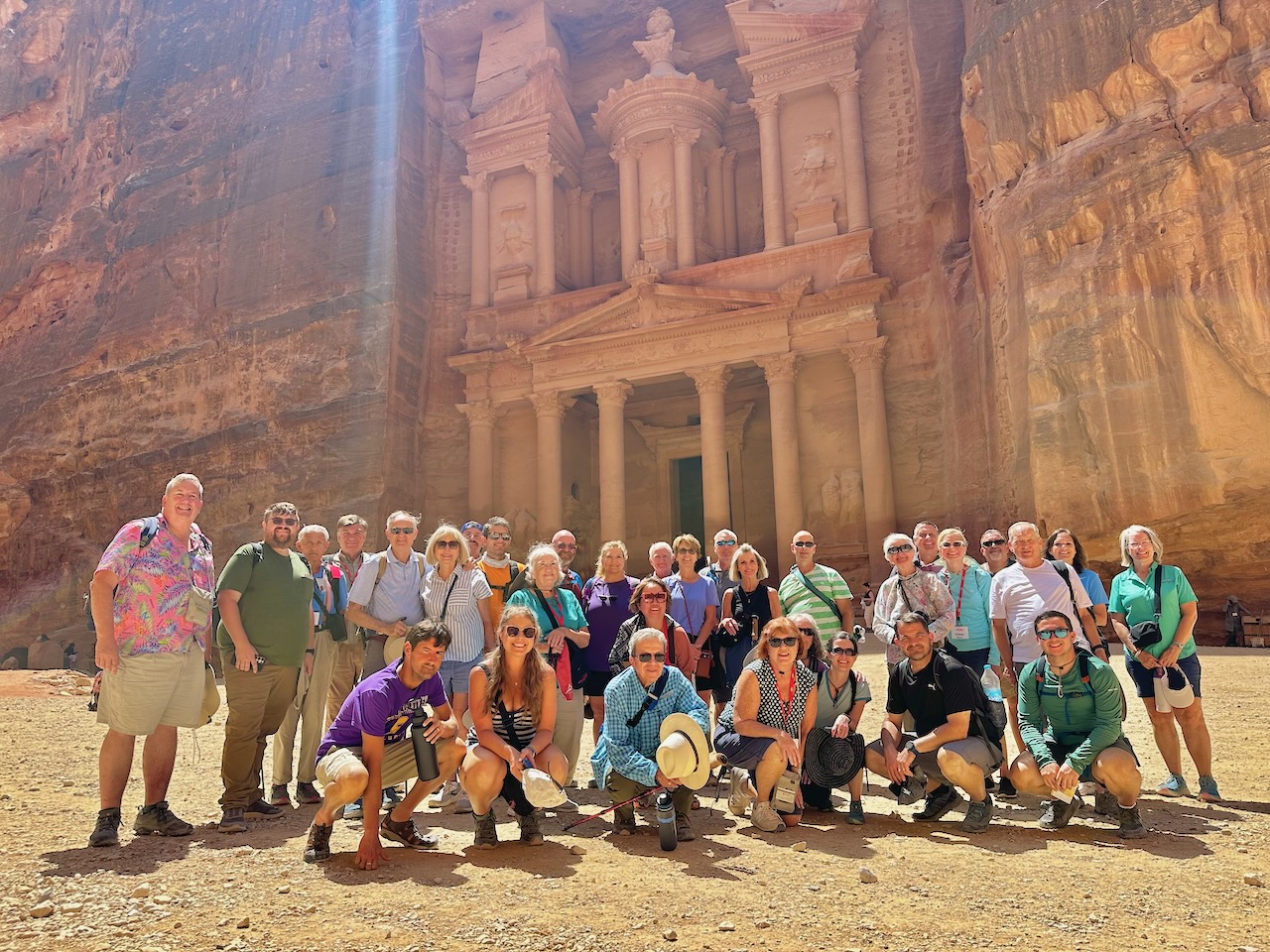
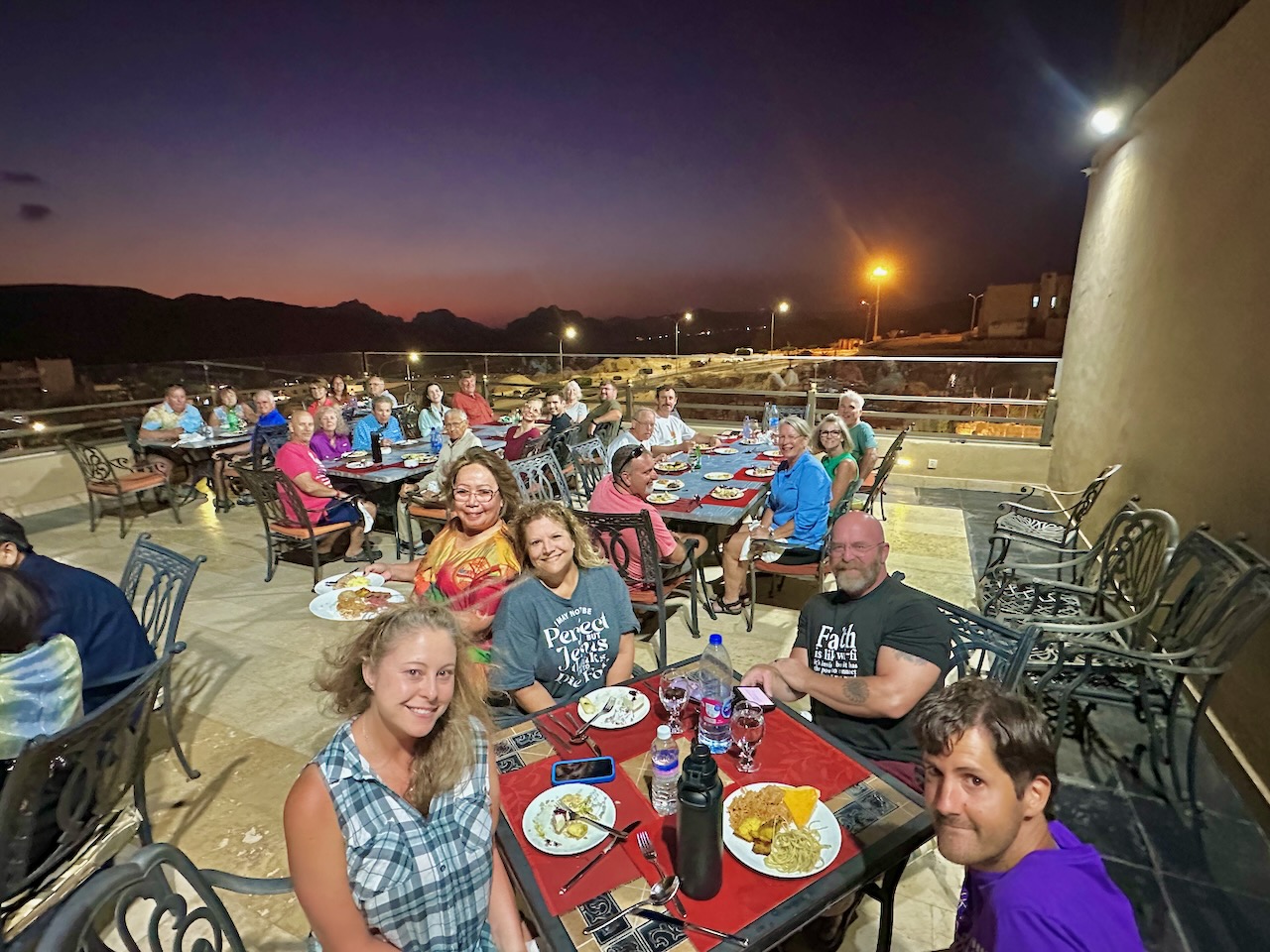
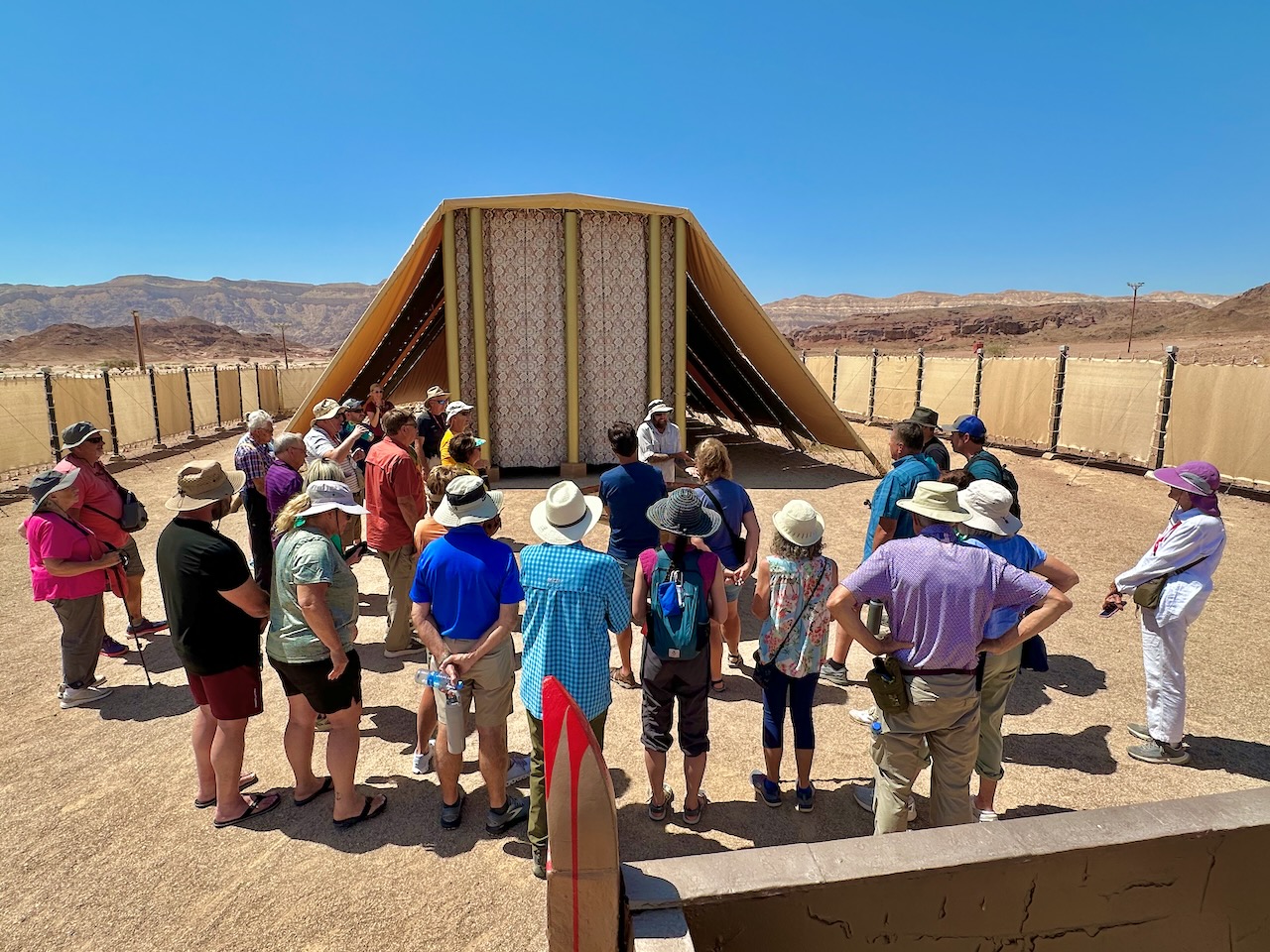
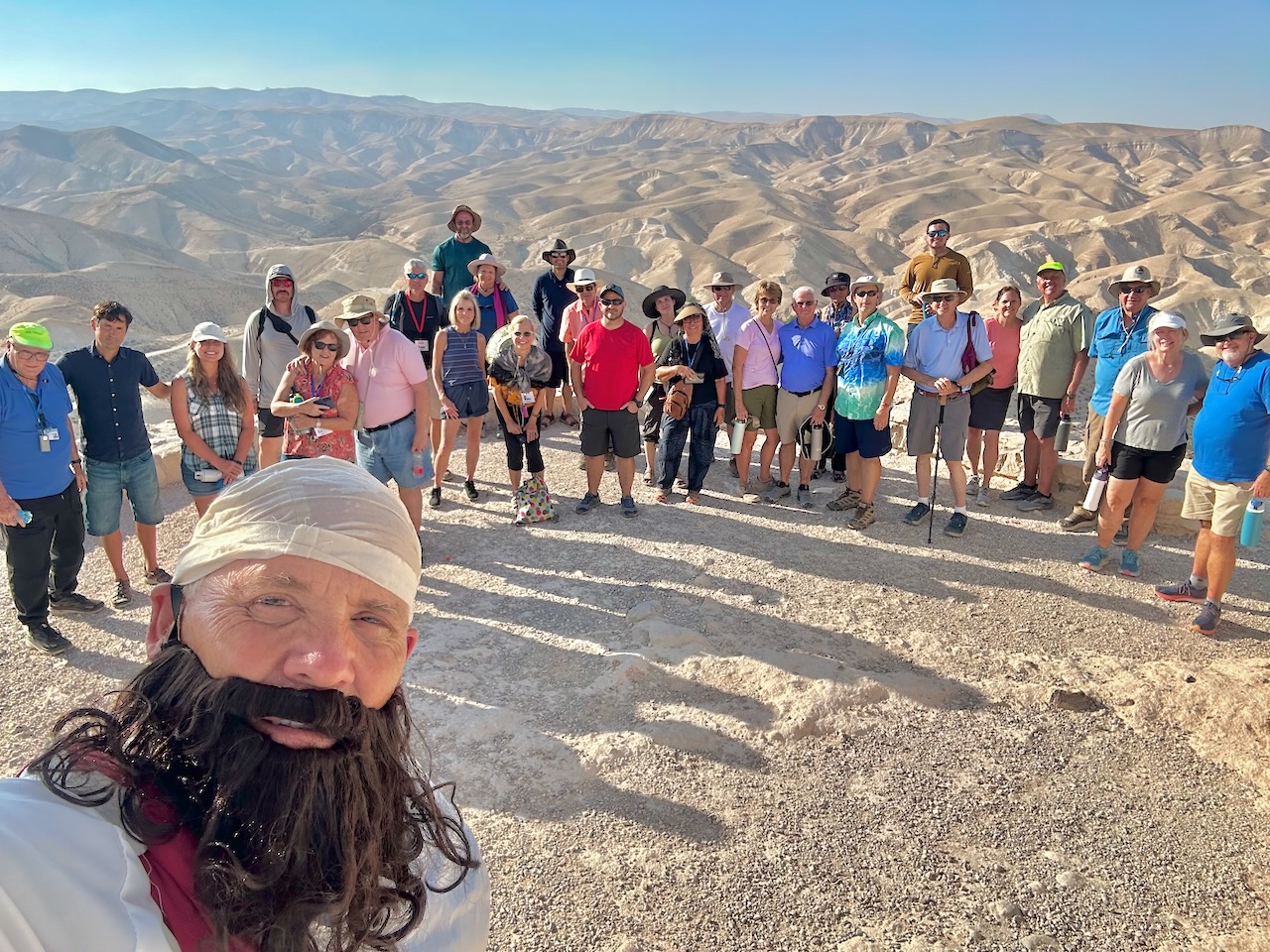



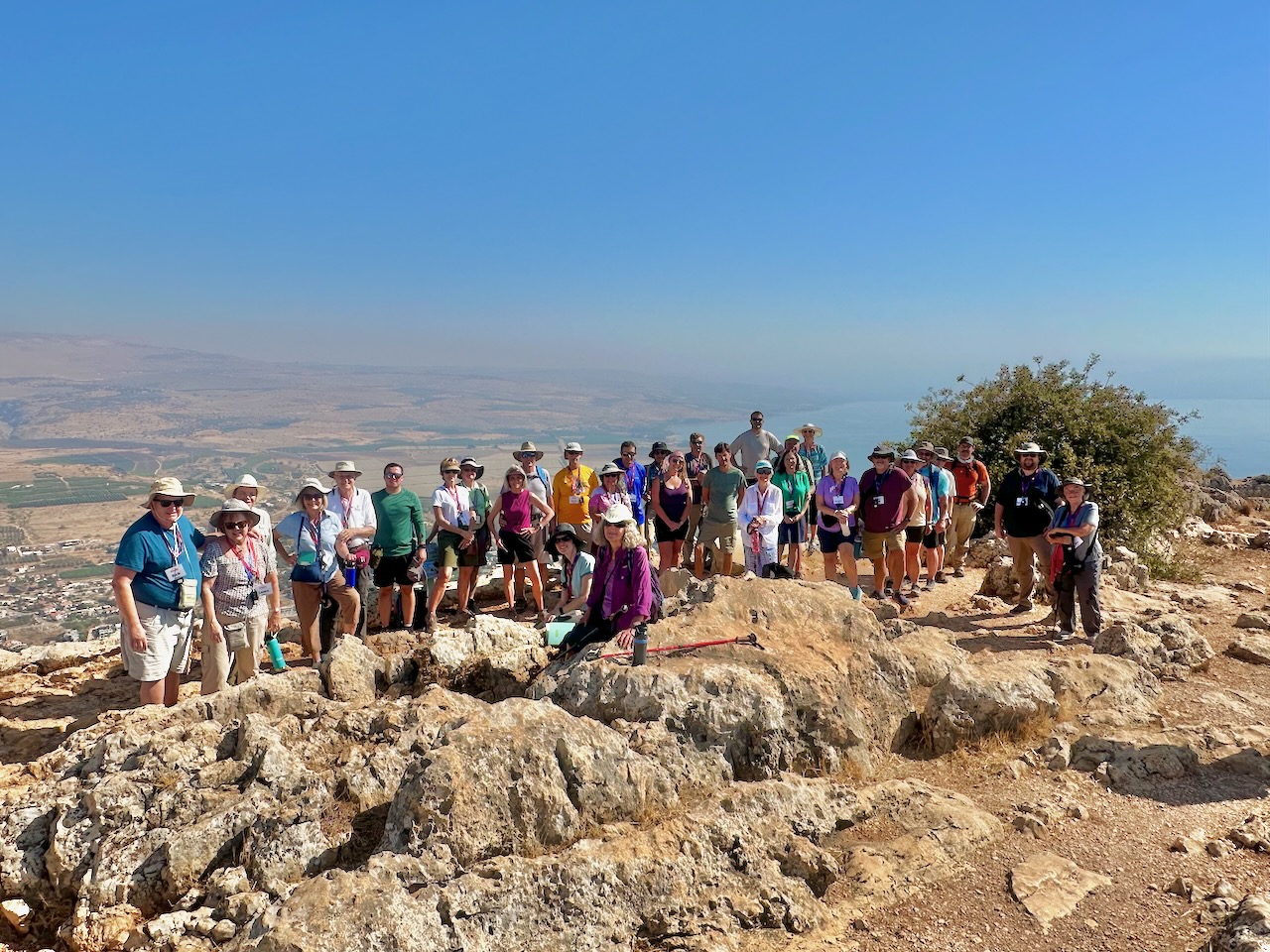
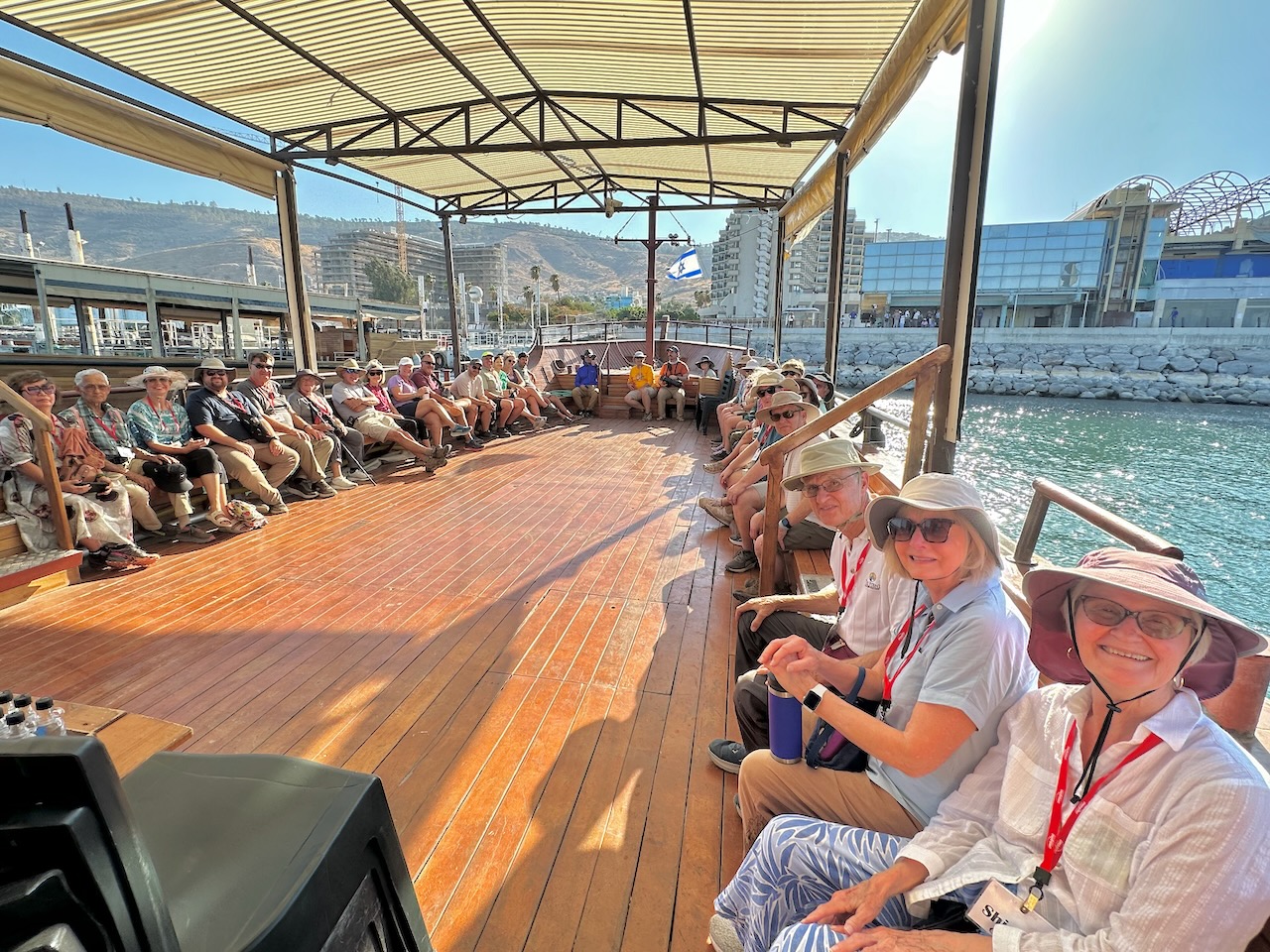
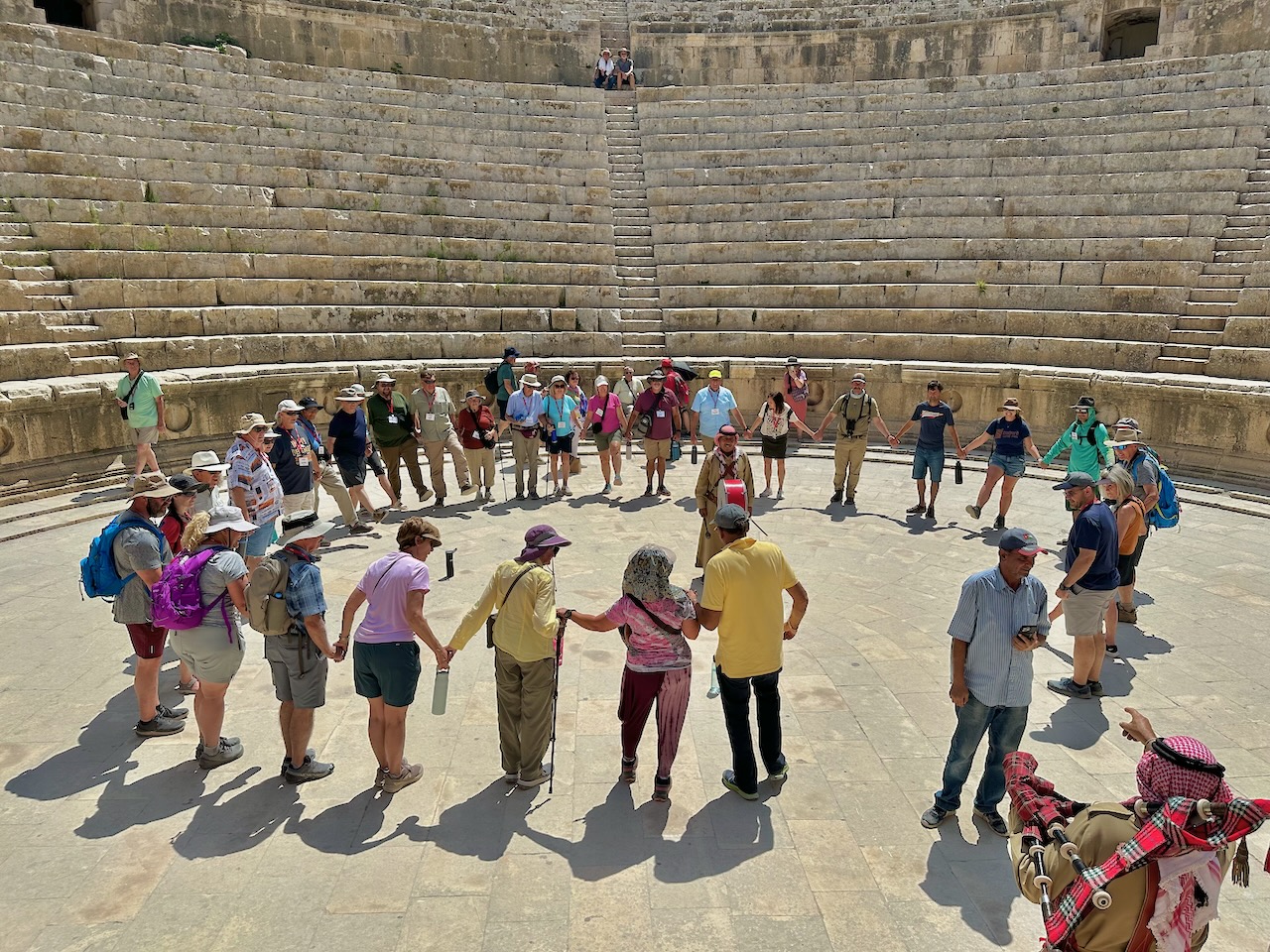
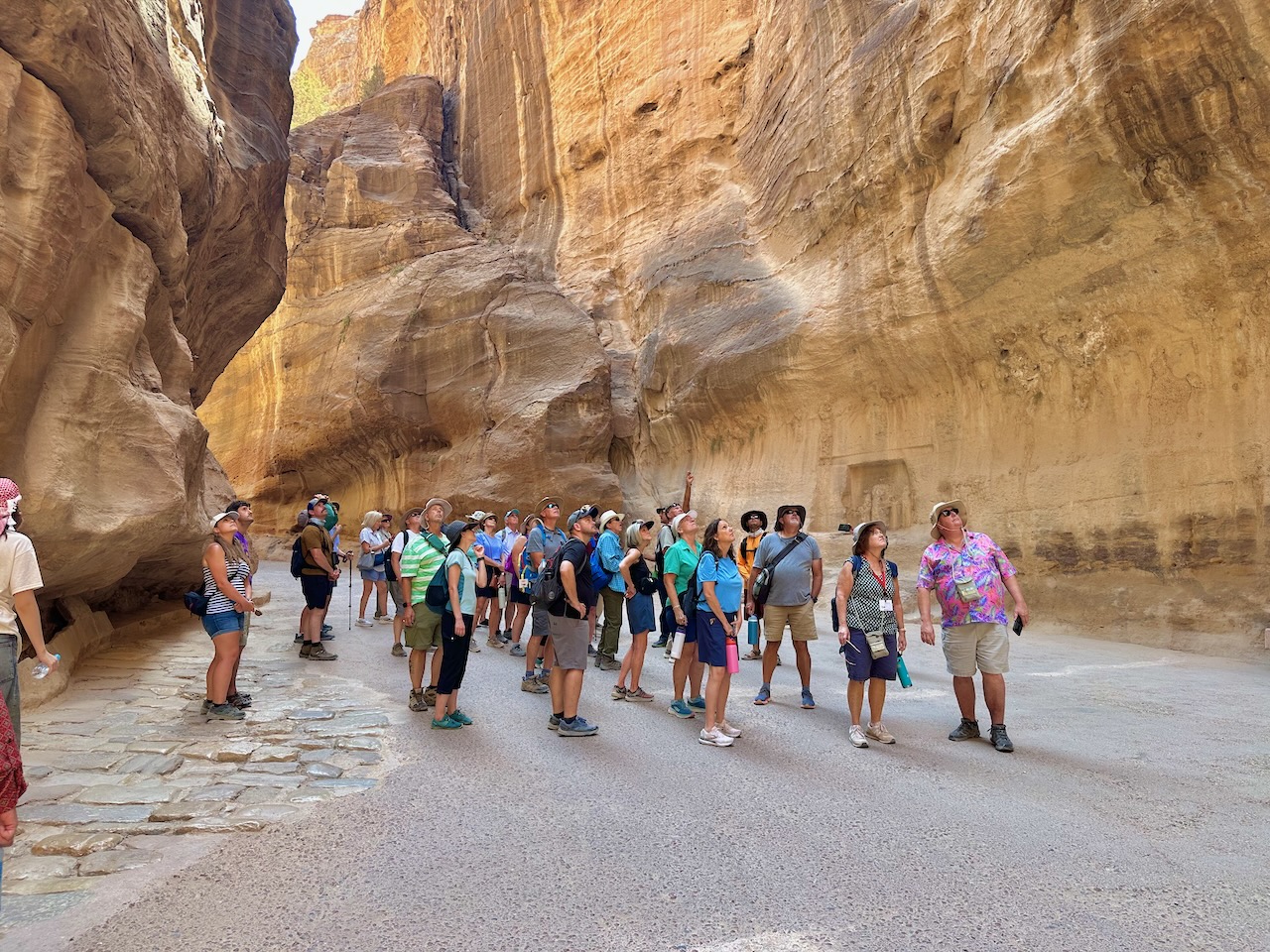
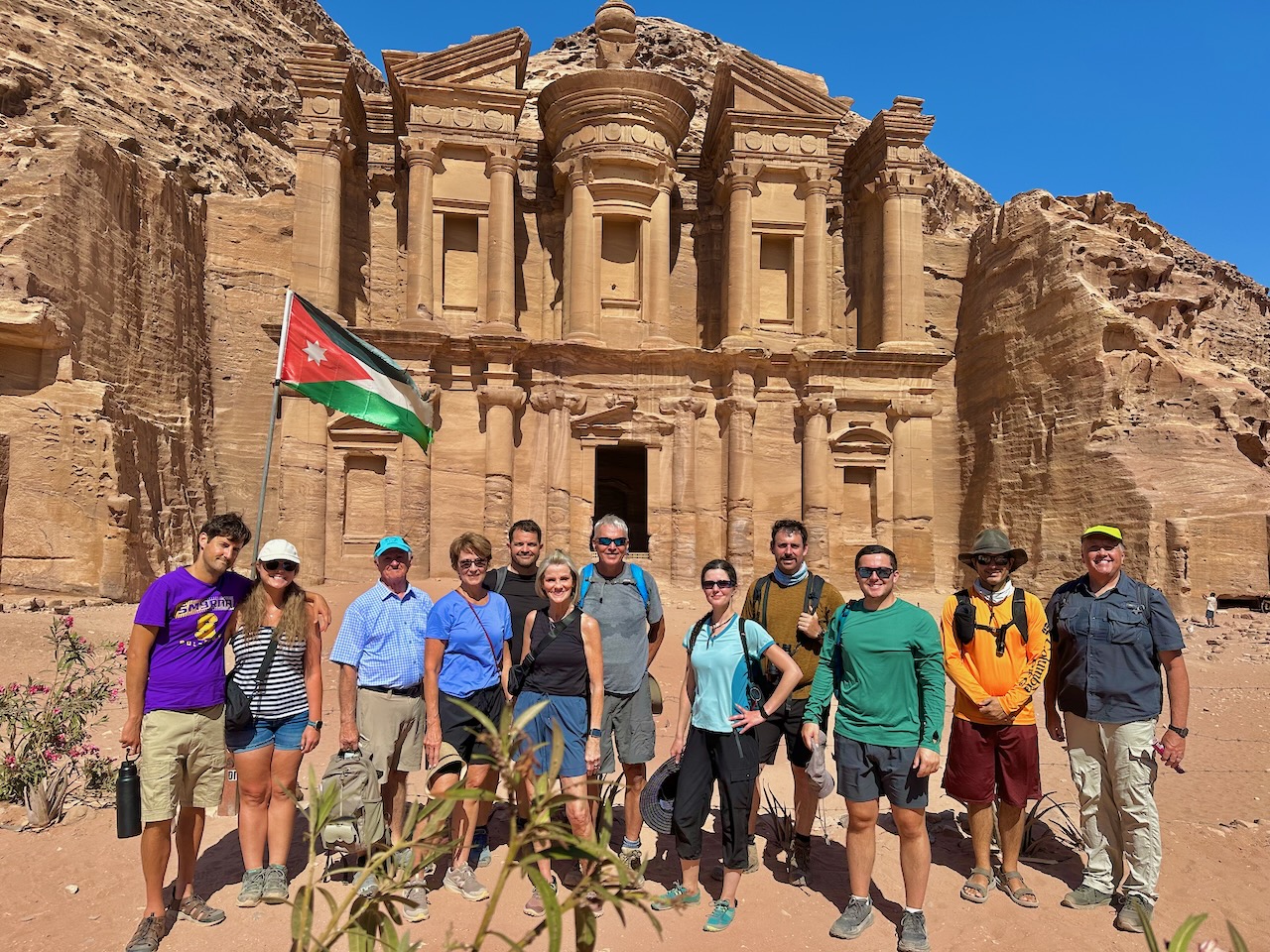

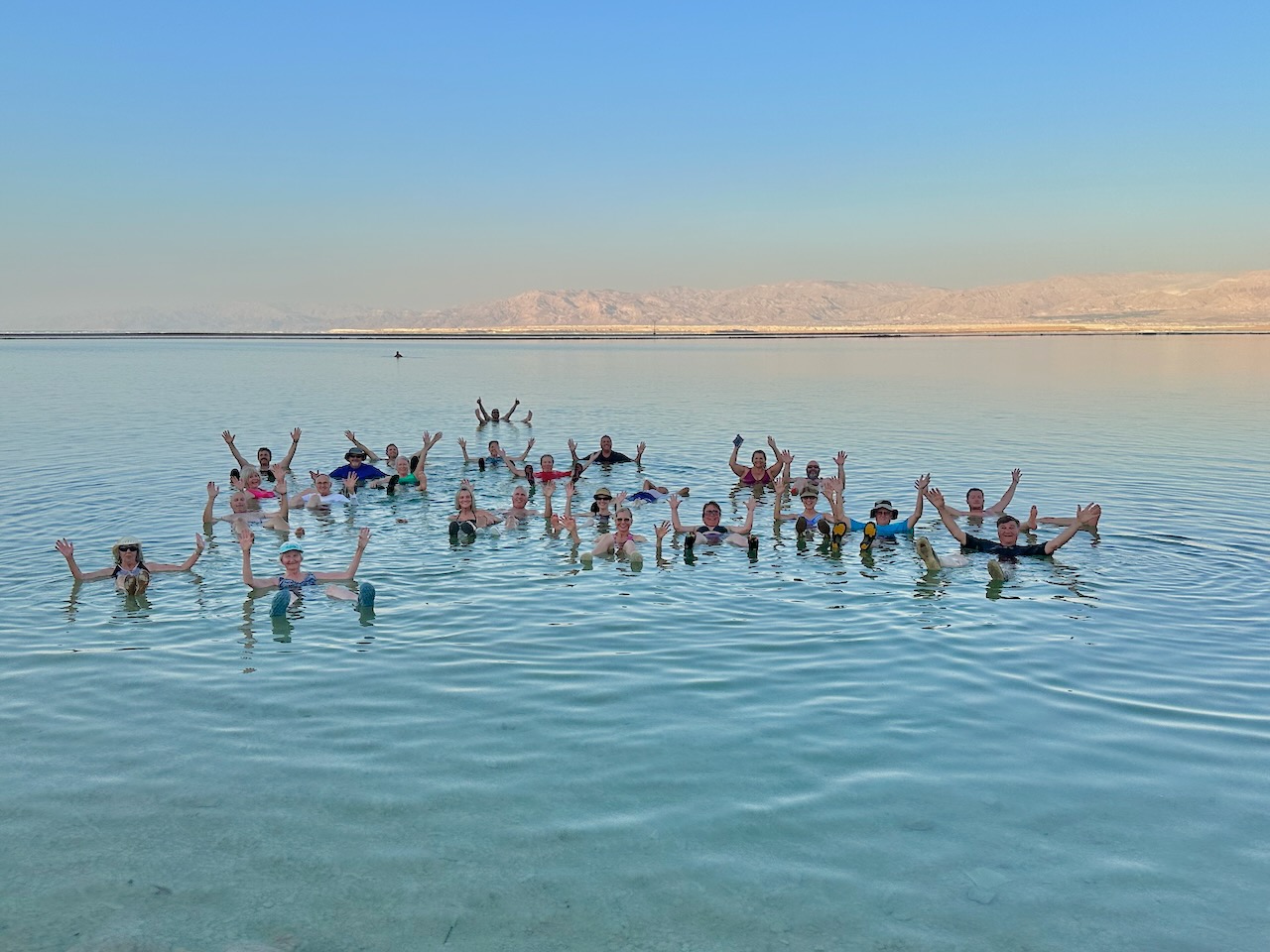
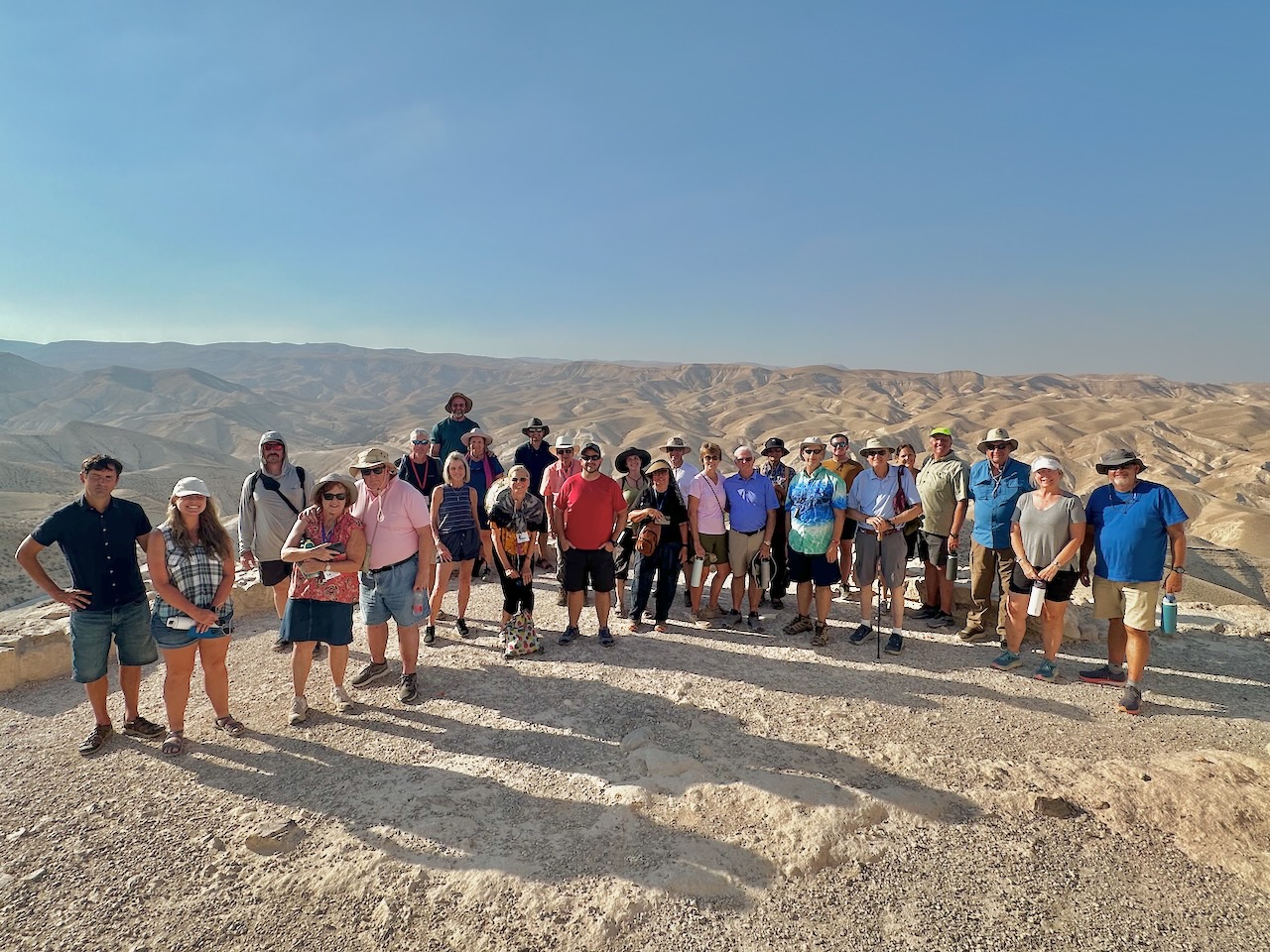

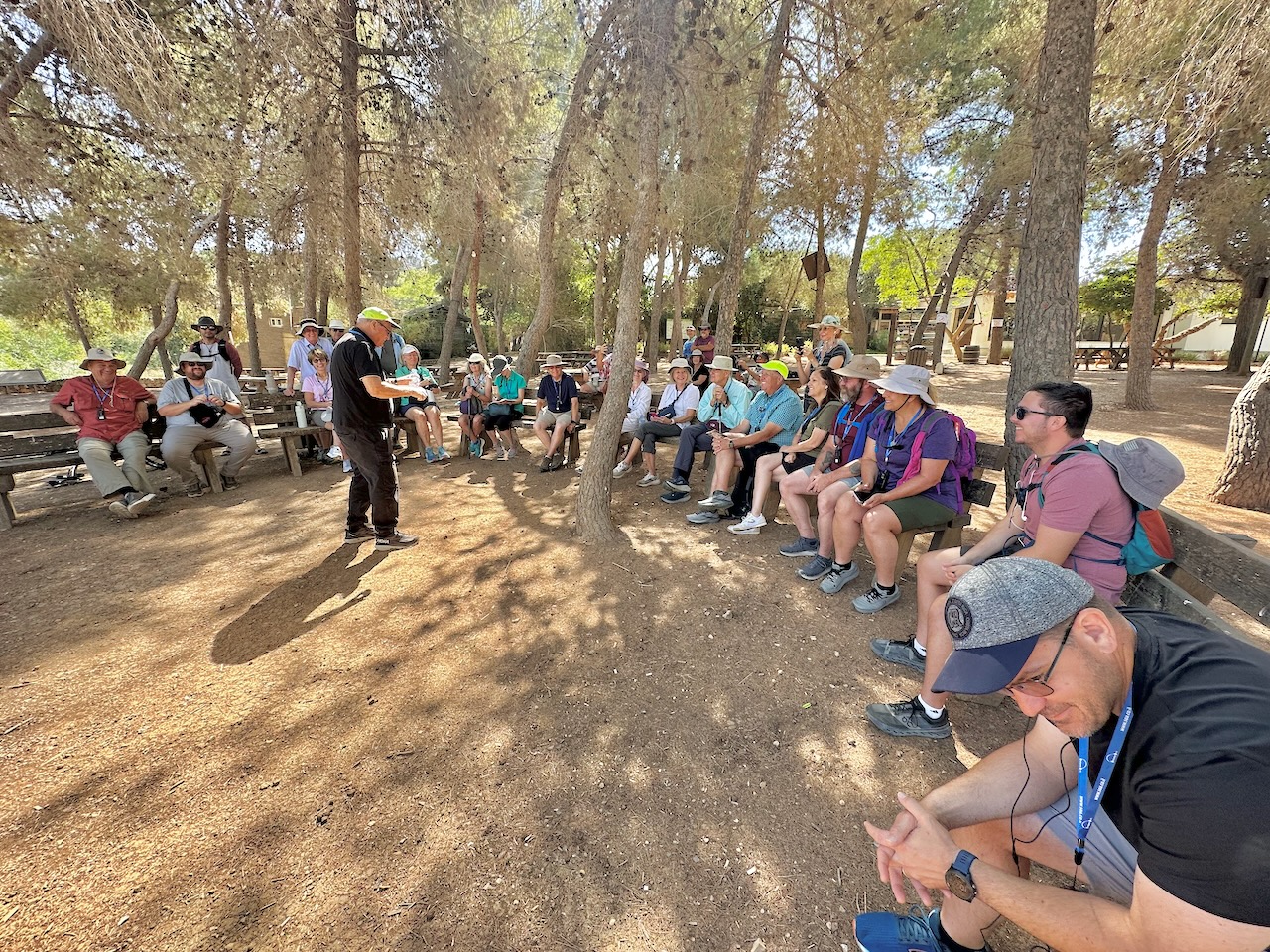
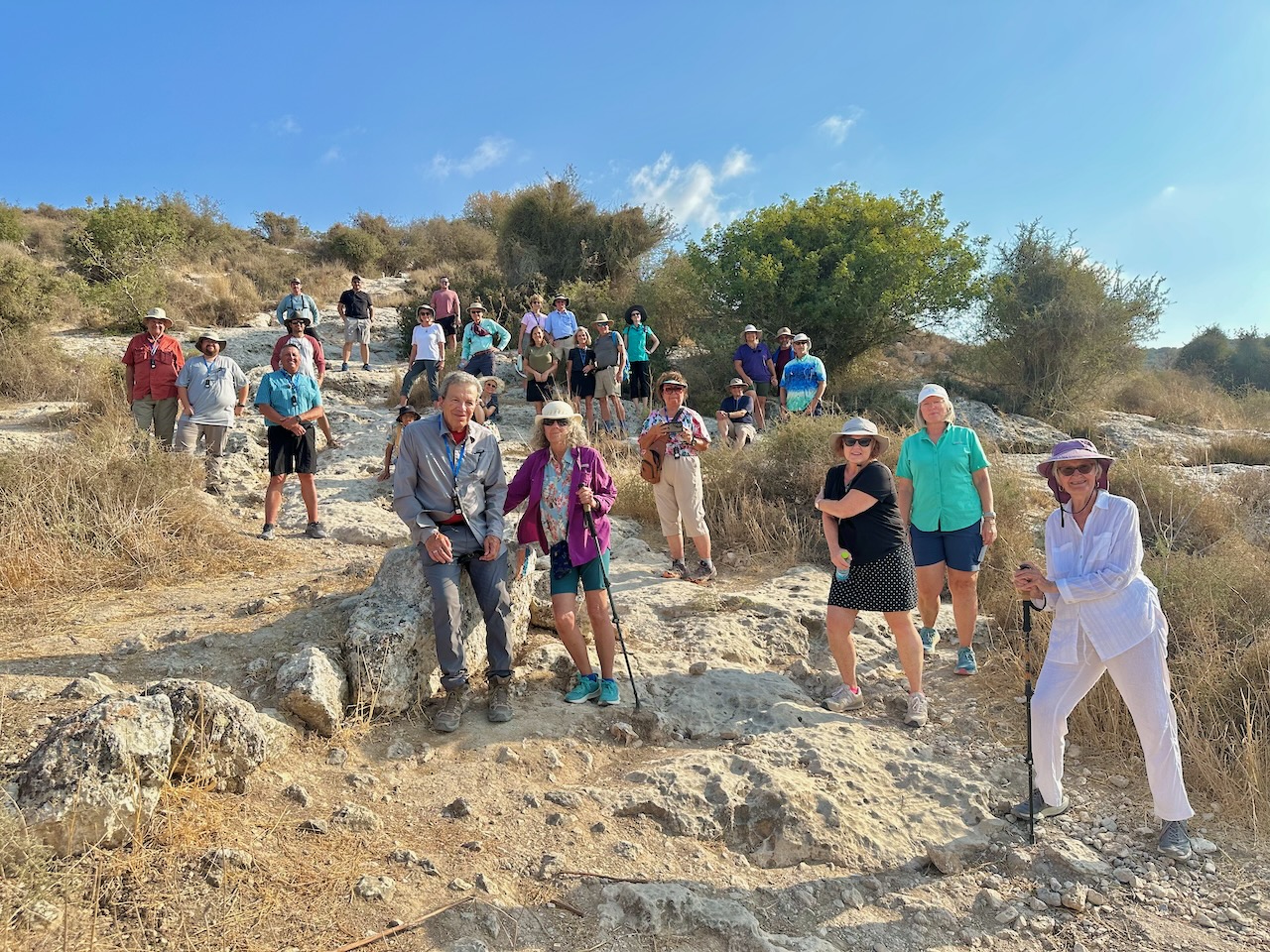
360 Photos
Our Israel-Jordan Tour Experiences:
Days 1 & 2 – Wednesday-Thursday, September 3-4: Depart U.S.A., Arrive in Israel, Tel Aviv-Netanya
The day finally arrived… we are heading to Israel! God brought 33 people together for this group, the majority from the Peninsula Baptist Church in Moorseville, NC. We used two flights to arrive at the Ben Gurion Airport. We were met by our Israeli agents who assisted us through the airport. The early group were transported to the hotel in Netanya while the bus took the majority of the group to Netanya. David (our driver) Shlomo (our guide), and Pastor John (our tour leader) shared a few things on the way for the latter group.
Once we arrived at the hotel, we enjoyed a late dinner together. Some even took a stroll down at the beach of the Mediterranean Sea. We are looking forward to our first full day tomorrow.
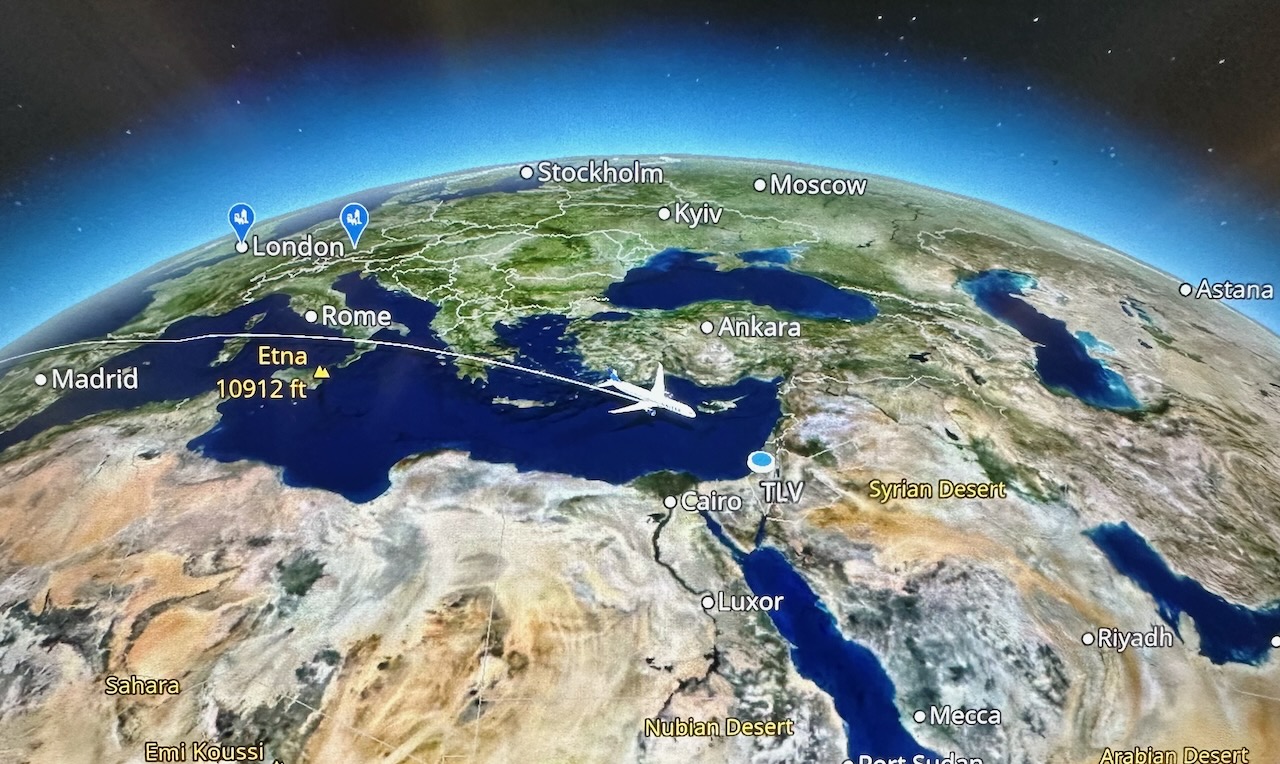
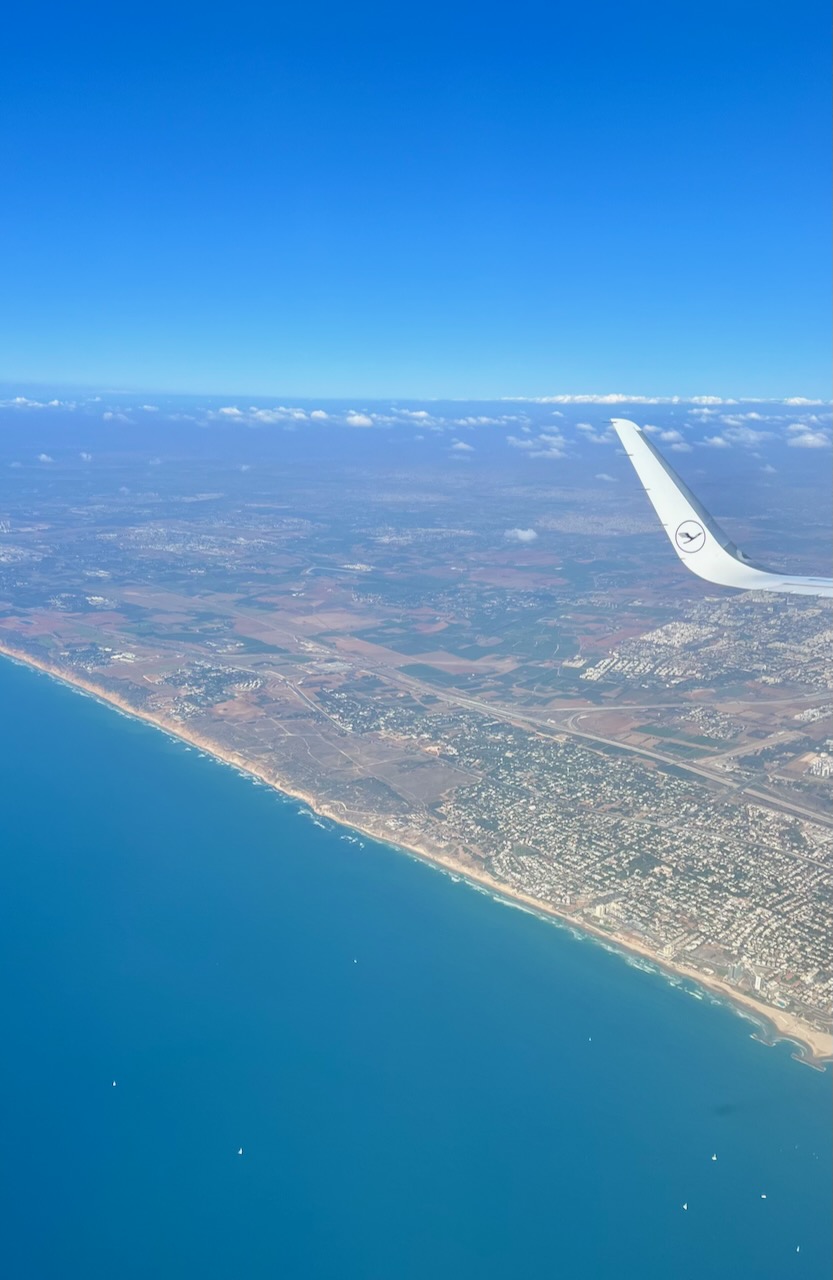
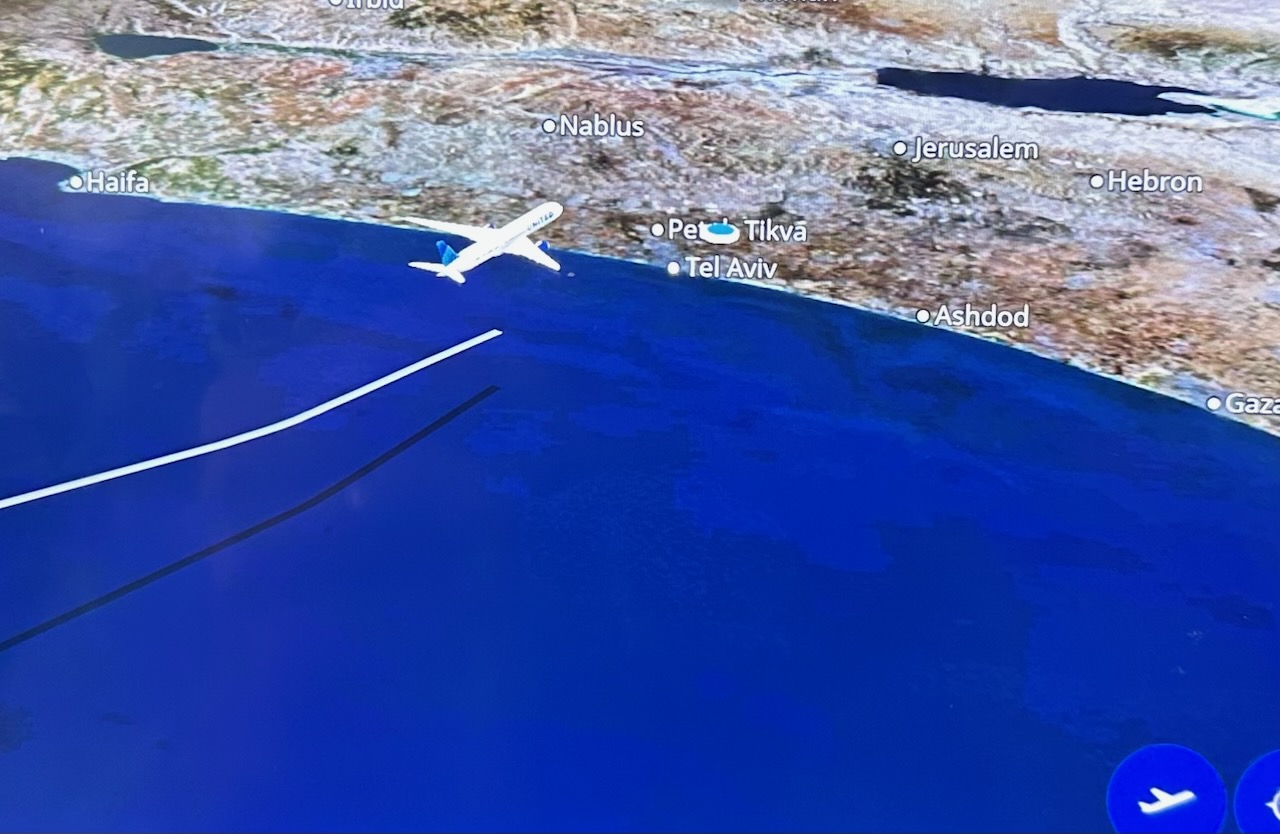

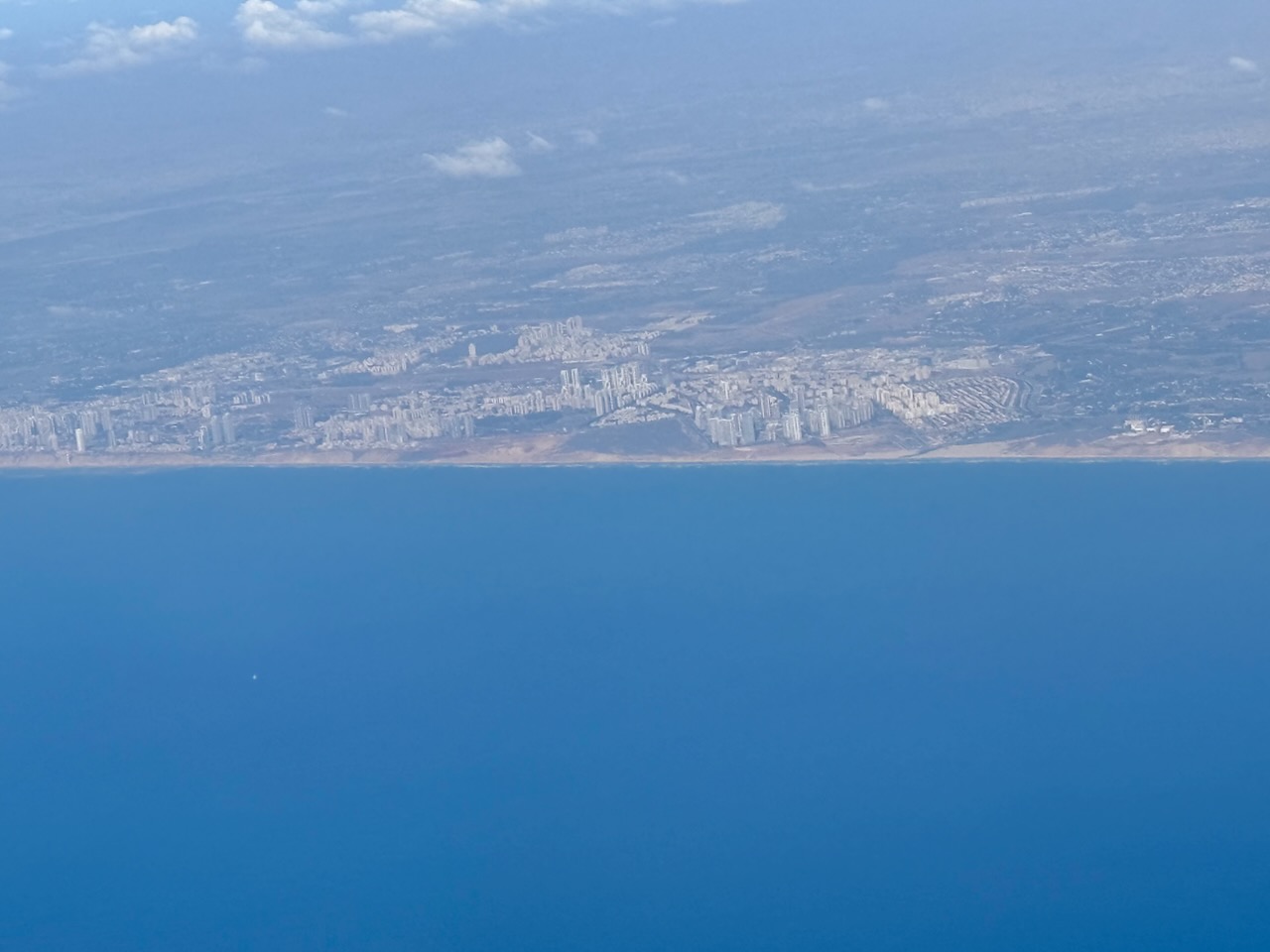
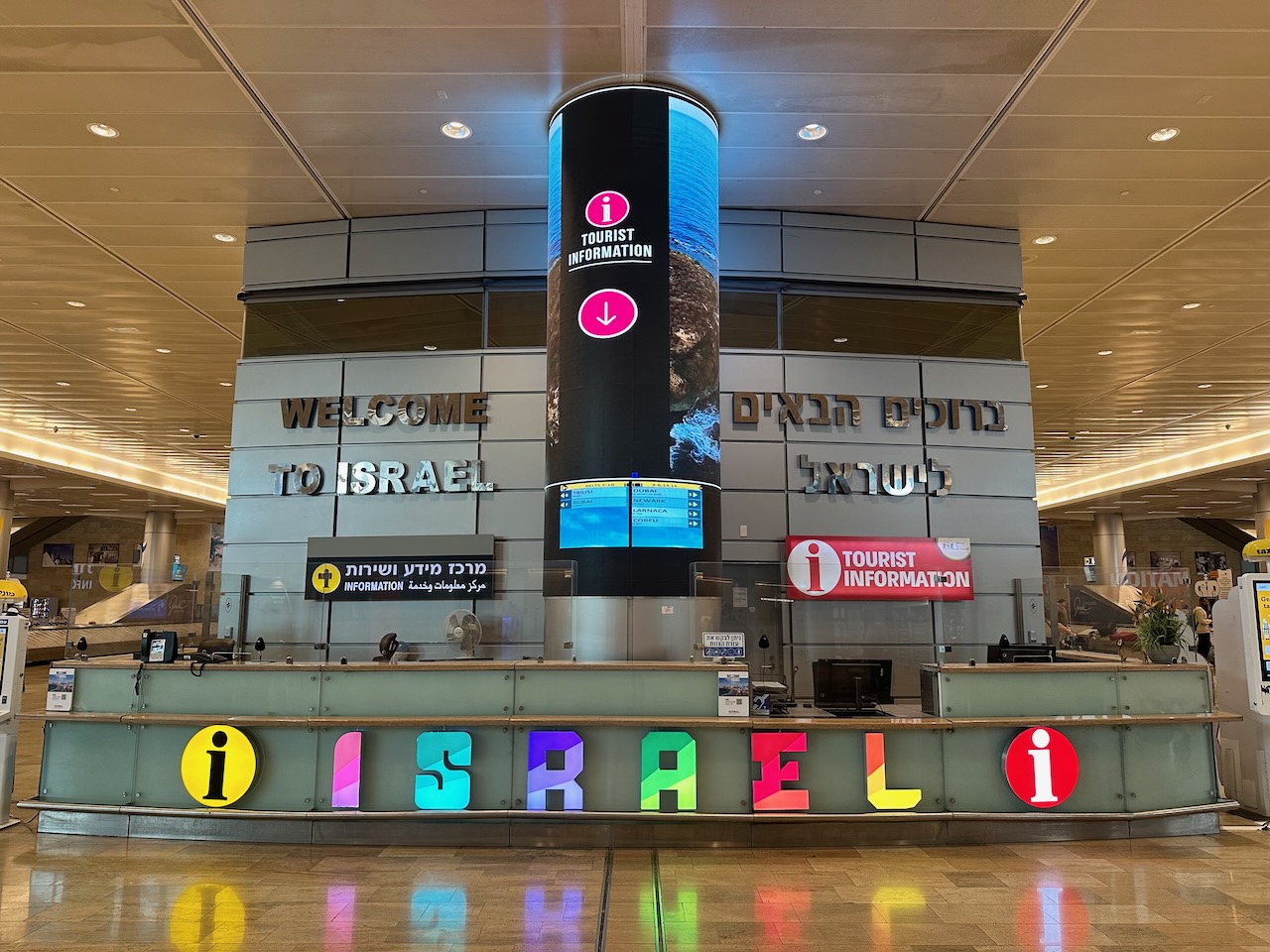
Day 3 – Friday, September 5: Caesarea, Megiddo, Beth Shean, Precipice of Nazareth, Tiberias
Today was our first full day here in Israel. We are all excited to engage with the Bible and the primary land where biblical events took place. The day’s weather was very hot with full sun and afternoon highs (at Beth Shean around 100). After a wonderful full breakfast, we loaded the bus and left about 7:30. We read Psalm 100 and the “Modeh Ani” prayer of thanksgiving as we drove north to our first site. We also learned the song, “Oh, the Sun’s Coming Up.”
Caesarea Maritima
We drove north in the Sharon Plain to get to our first site, Caesarea Maritima. It was a city built between 22-10 BC by Herod the Great.We started the the theater where we read portions of Acts 8, 9, 10, 12, 21, and 26. Peter, Phillip, and Paul were all here sharing their faith in Christ. Among the ruins the praetorium (palace, where we saw a replica of the Pilate Inscription found in 1961 in secondary use), hippodrome, and the area of the harbor. We then entered the Crusader part of the city. We saw a short 10 minute movie about Herod and Caesarea. Before leaving the site, we also saw the aqueduct that brought fresh water into Caesarea from the Carmel Range.
Carmel Range
Leaving Caesarea, we drove through the Carmel Range (or Mt. Carmel). This range separates the Sharon Plain with the Jezreel Valley. Although we did not drive to the top of this ridge, on the bus we read from Isaiah 35, Amos 1 and 9, and Song of Songs 7. The primary story connected with Elijah the the Carmel Range comes from 1 Kings 18.
Megiddo
As we drove along the edge of the Jezreel Valley arrived at Megiddo, an archaeological site that has about 25 levels of occupation that span 2,500 years! After seeing a model of the tel (ancient mound), we walked to the top of this Canaanite/Israelite site. We saw two Canaanite gate complexes, the gate, stables and palace area of Solomon (1 Kings 9:15), a sacrificial altar (Canaanite), and a grain silo. The also enjoyed a great view of the surrounding hills from here and the valley itself (Revelation 16:16). We left the site but deciding down 180 steps through the impressive water system that was designed and engineered to safely bring water into the city. It was remarkable to descend down and up through this amazing engineering project.
Beth Shean
We left Megiddo and drove east. We passed Tel Jezreel as we read from 1 Kings 21 and 2 Kings 8-9. These stories reference Naboth (who had a vineyard), Joram, Jehu, and Jezebel. To our south was the Gilboa Range We read from 1 Chronicles 10 (also recorded in 1 Samuel 31) about Saul and his three sons dying here. We continued east through the Harod Valley (an eastern finger/extension of the Jezreel Valley really) to Beth Shean, the only city of the Decapolis on the west side of the Jordan. Beth Shean is a massive archaeological site, primarily Roman. Here we saw the Roman bathhouse, the colonnaded street, and public latrines, and the impressive theater. Some in the group climbed about 190 steps to the Old Testament site where Saul’s body was hung on the walls of the town square. The view from on top of the Roman city below was amazing! Even though the heat reached about 100 here, this site was overwhelmingly impressive!
Precipice of Nazareth
To end the day we drove north across this broad part of the Jezreel Valley to get to the Precipice of Nazareth. The view from here of Mt. Tabor (Judges 4-5), the Hill of Moreh (Judges 6-7, 2 Kings 4), Gilboa (1 Samuel 31), and even Mt. Carmel (1 Kings 18) to the west was impressive! Unfortunately because of the haze we could not see the Hills of Gilead across the Jordan Valley to the east (in Jordan today). We considered the life of Jesus as we read from Luke 4 and John 1.
Tiberias/Sea of Galilee
It took about an hour (driving past the modern Arab town of Cana, John 2 and 4) to arrive at our hotel in northern Tiberias (the Ron Beach Hotel). It is located along the western coastline of the Sea of Galilee. We enjoyed a nice sunset over the water from the balconies of our hotel before dinner. The “Shabbat dinner” was amazing! We retired to our rooms for a good nights rest. Some of us wake early tomorrow for “Hill 713.” It was a great first full day!
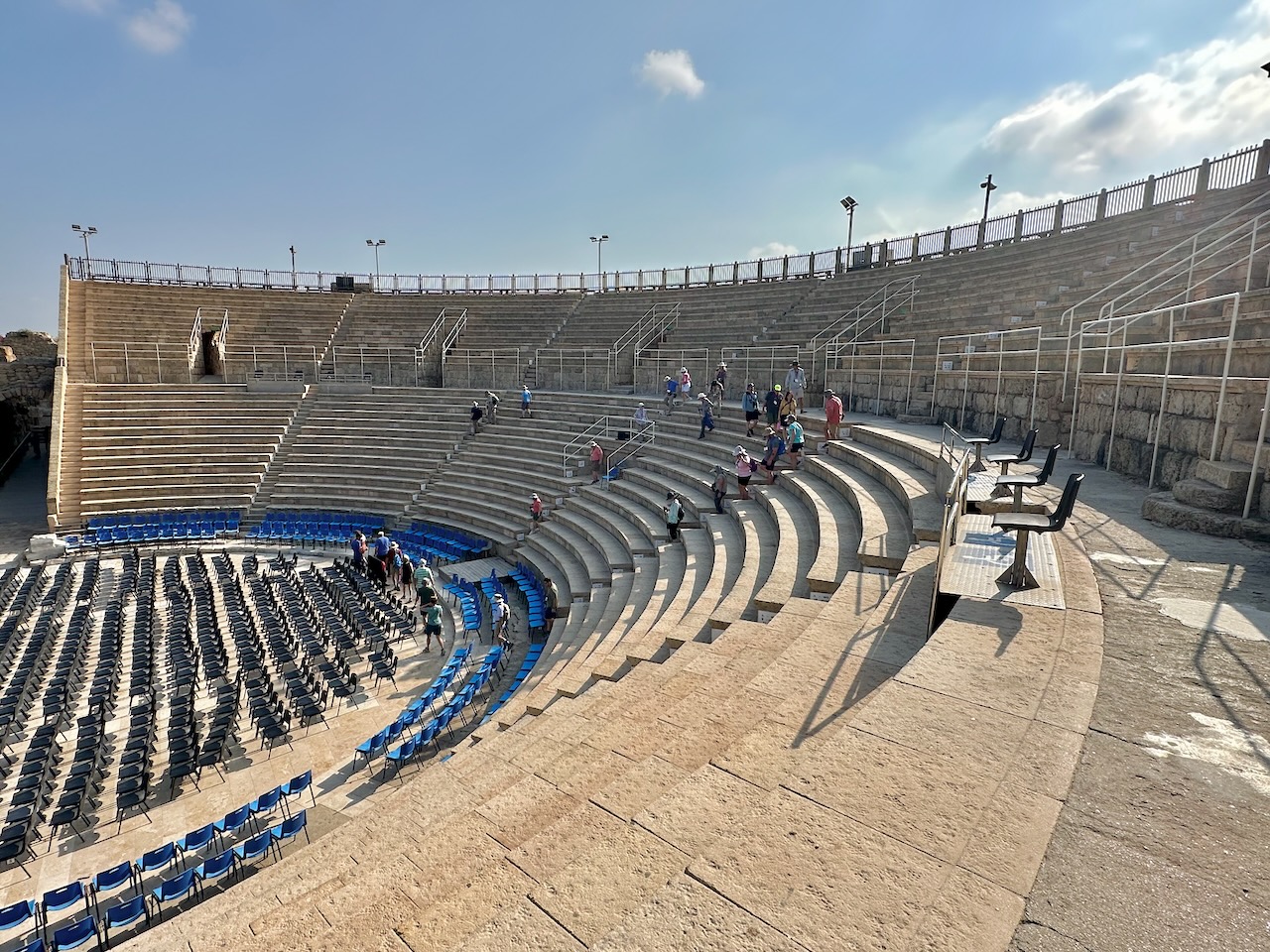
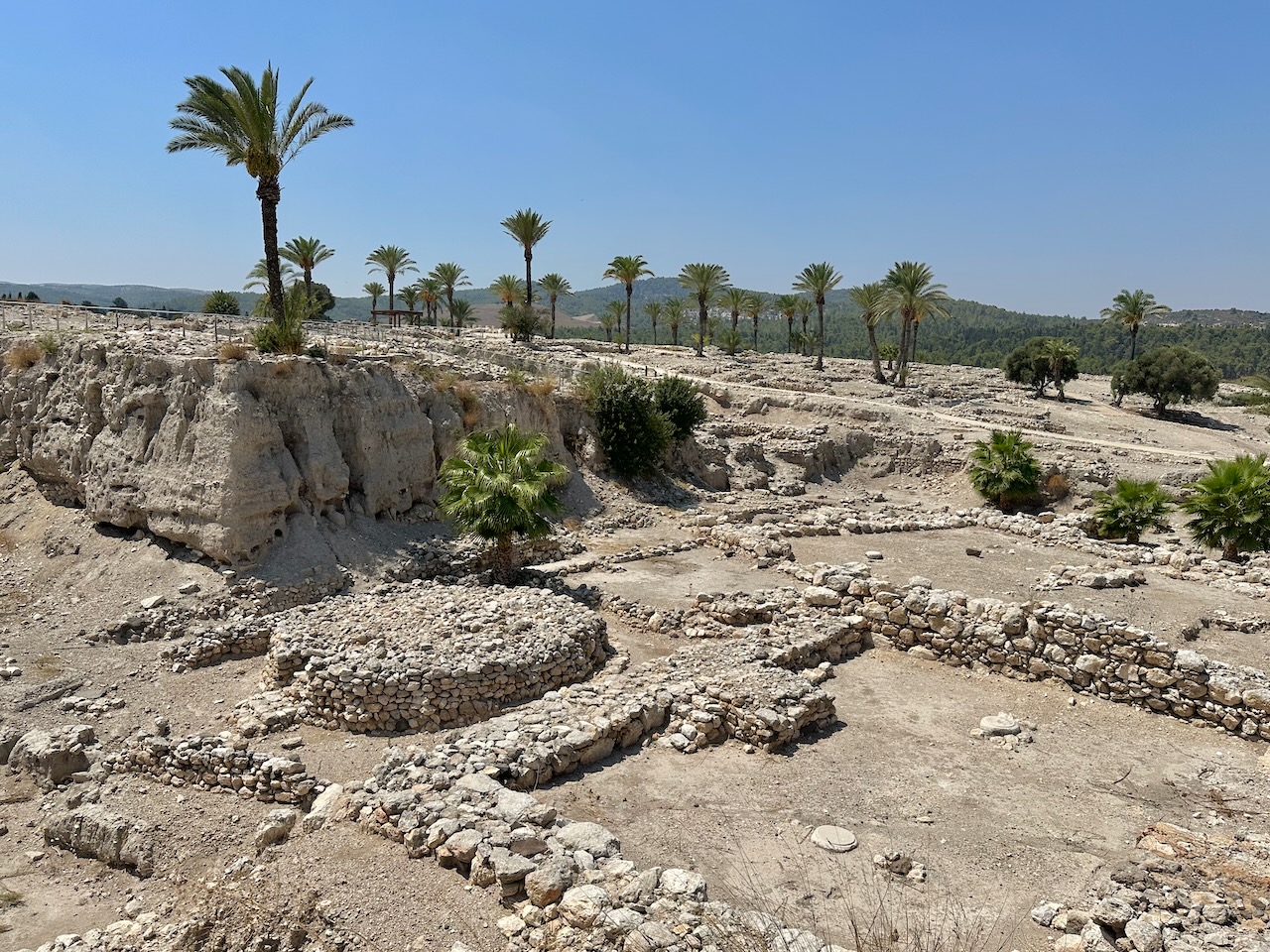
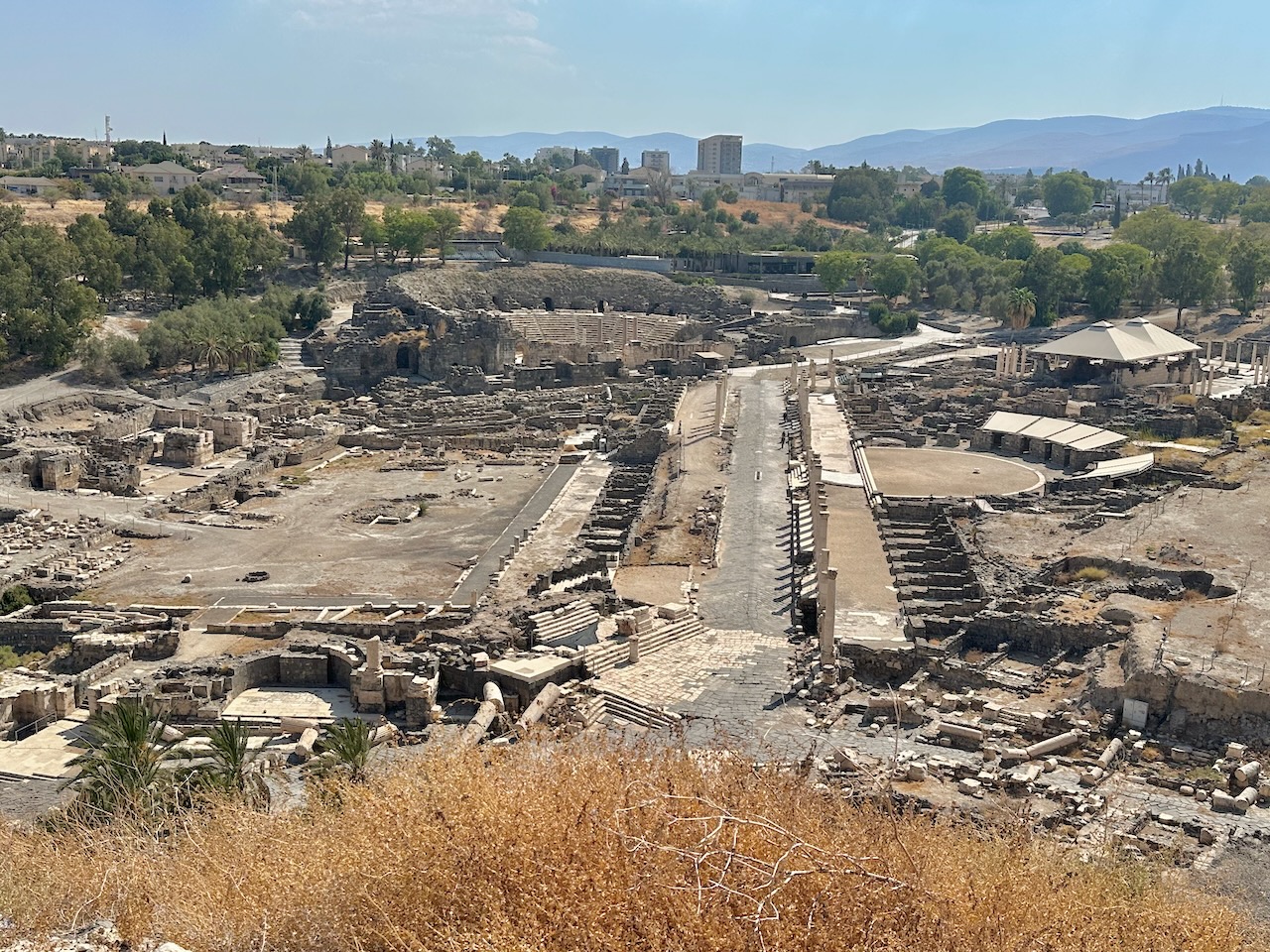
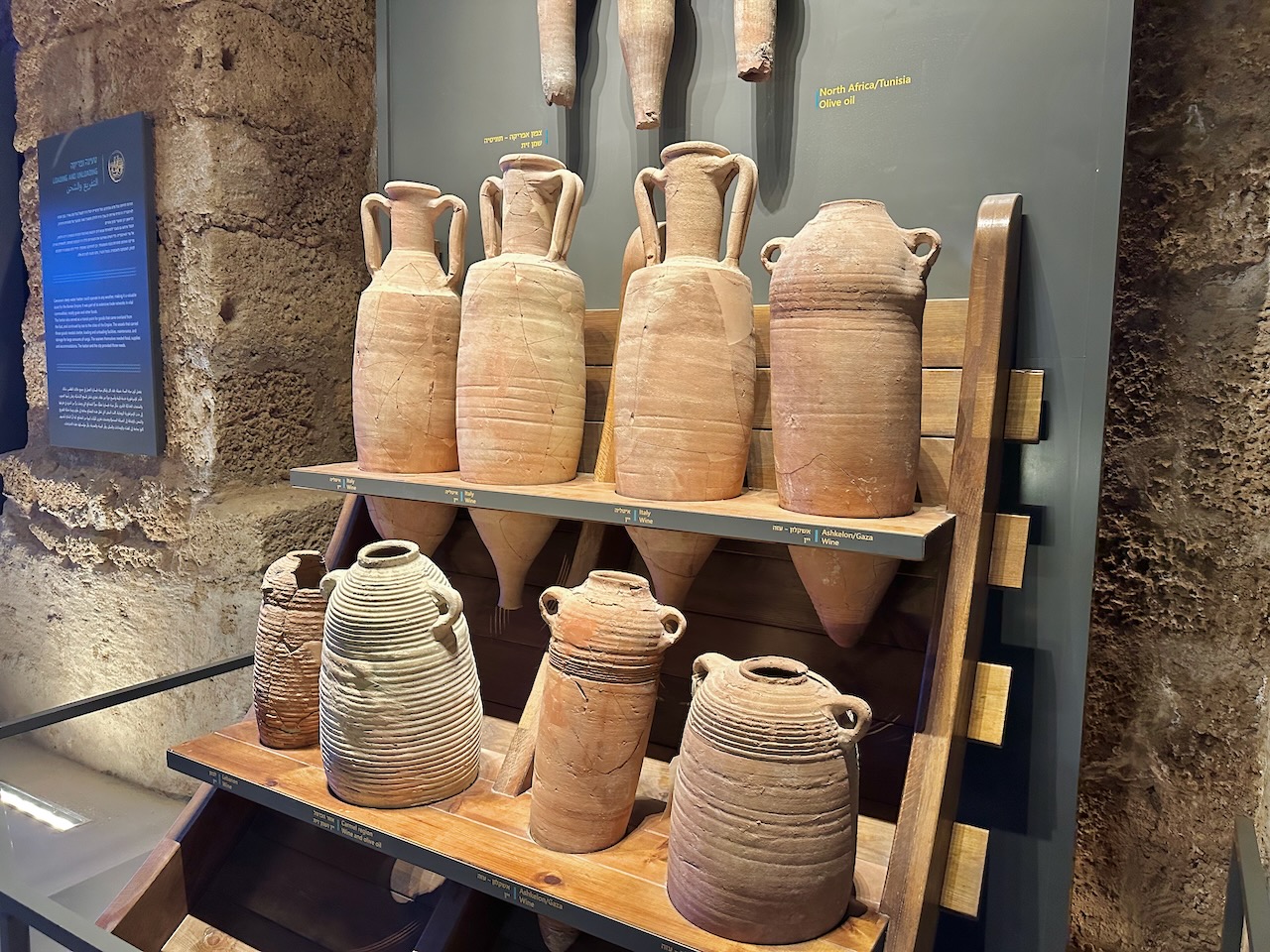
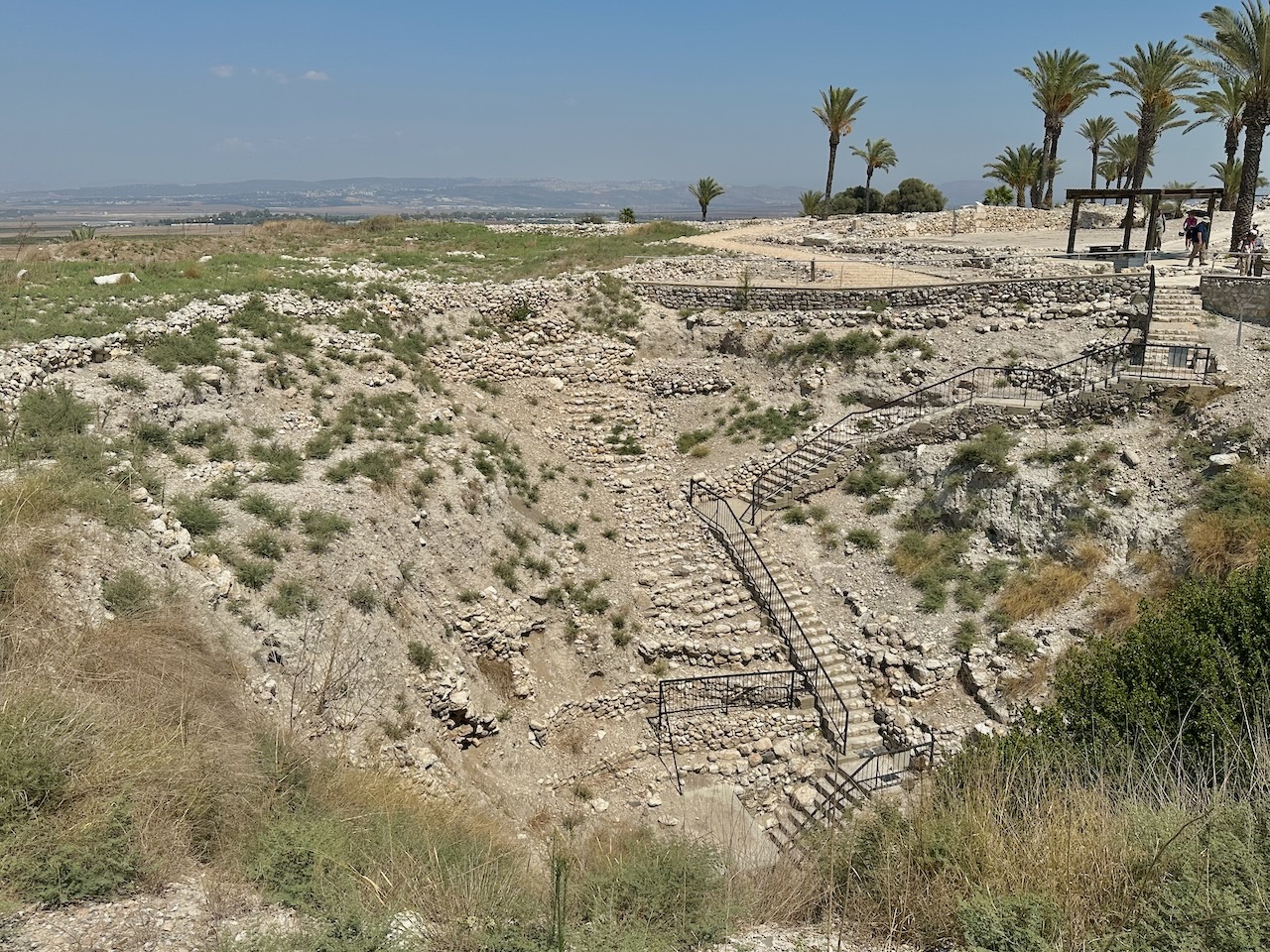
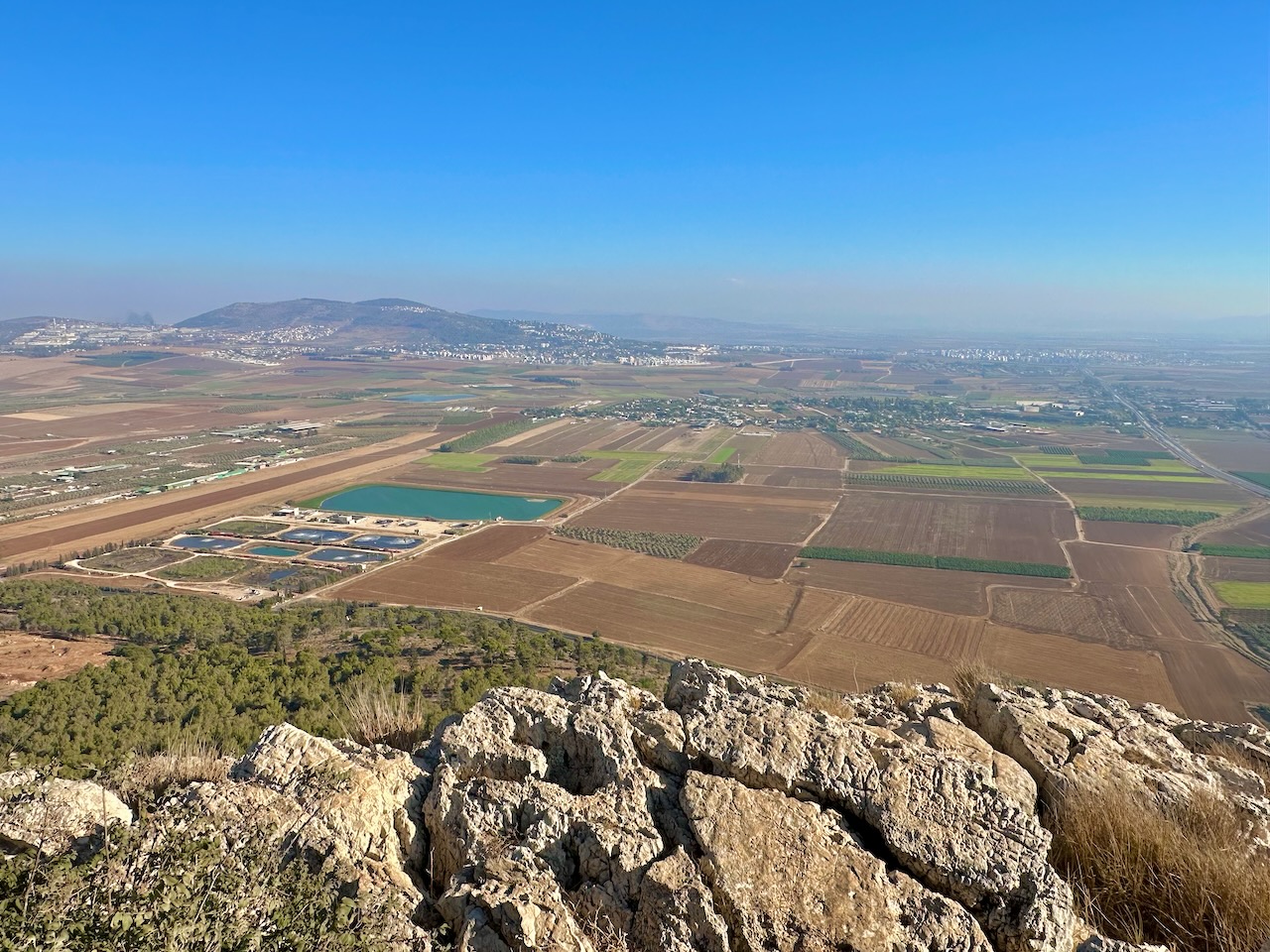
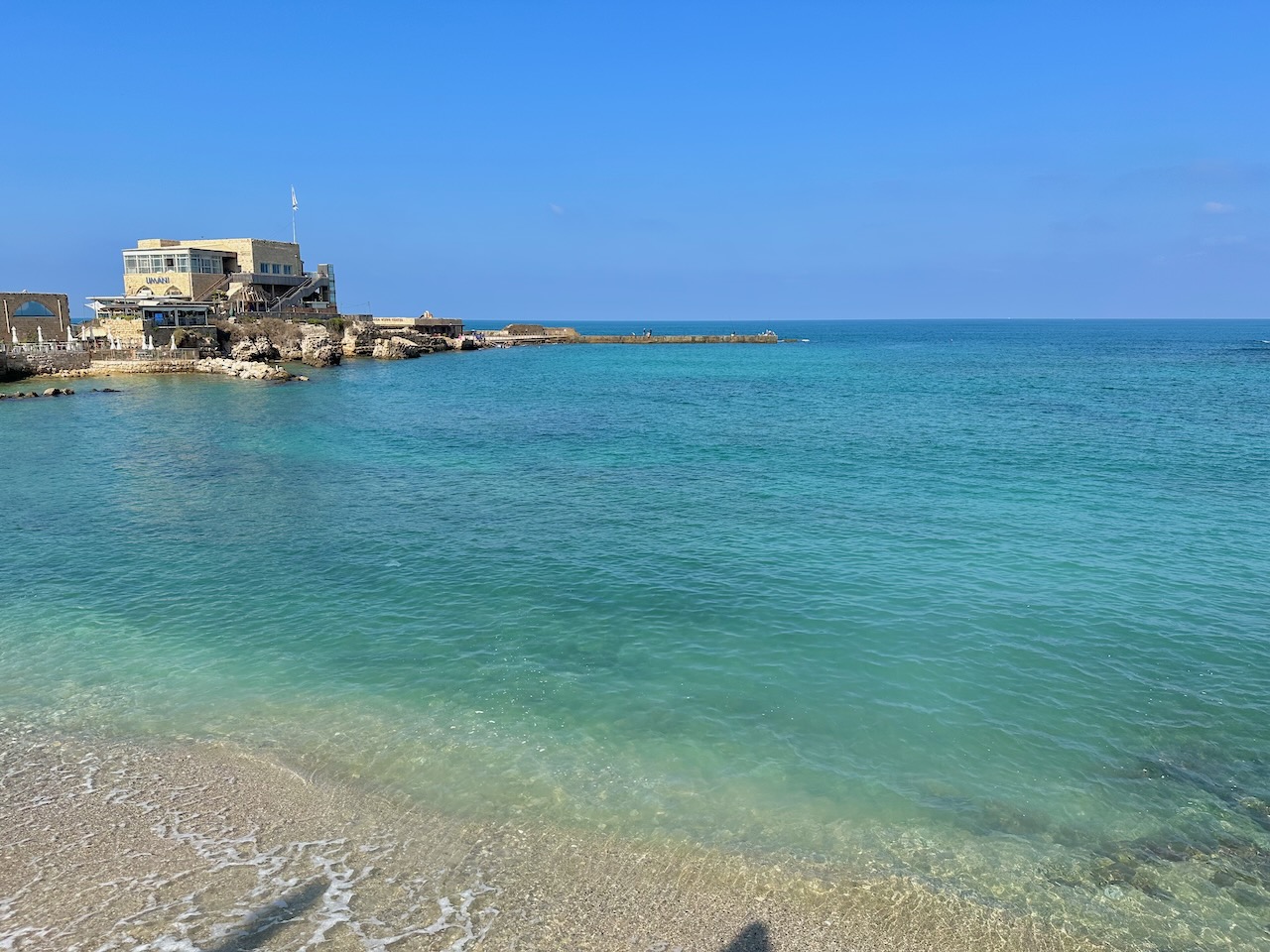
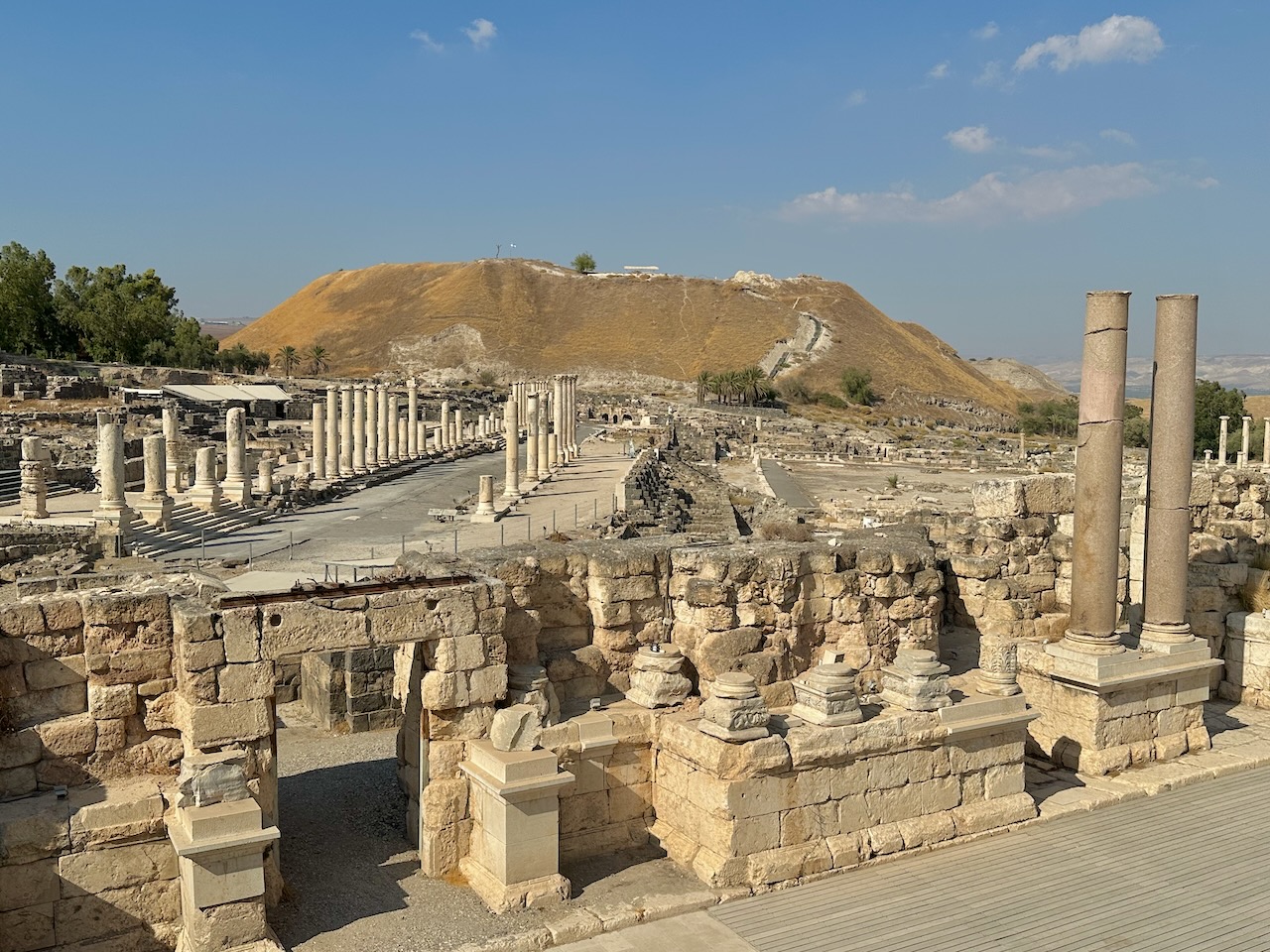
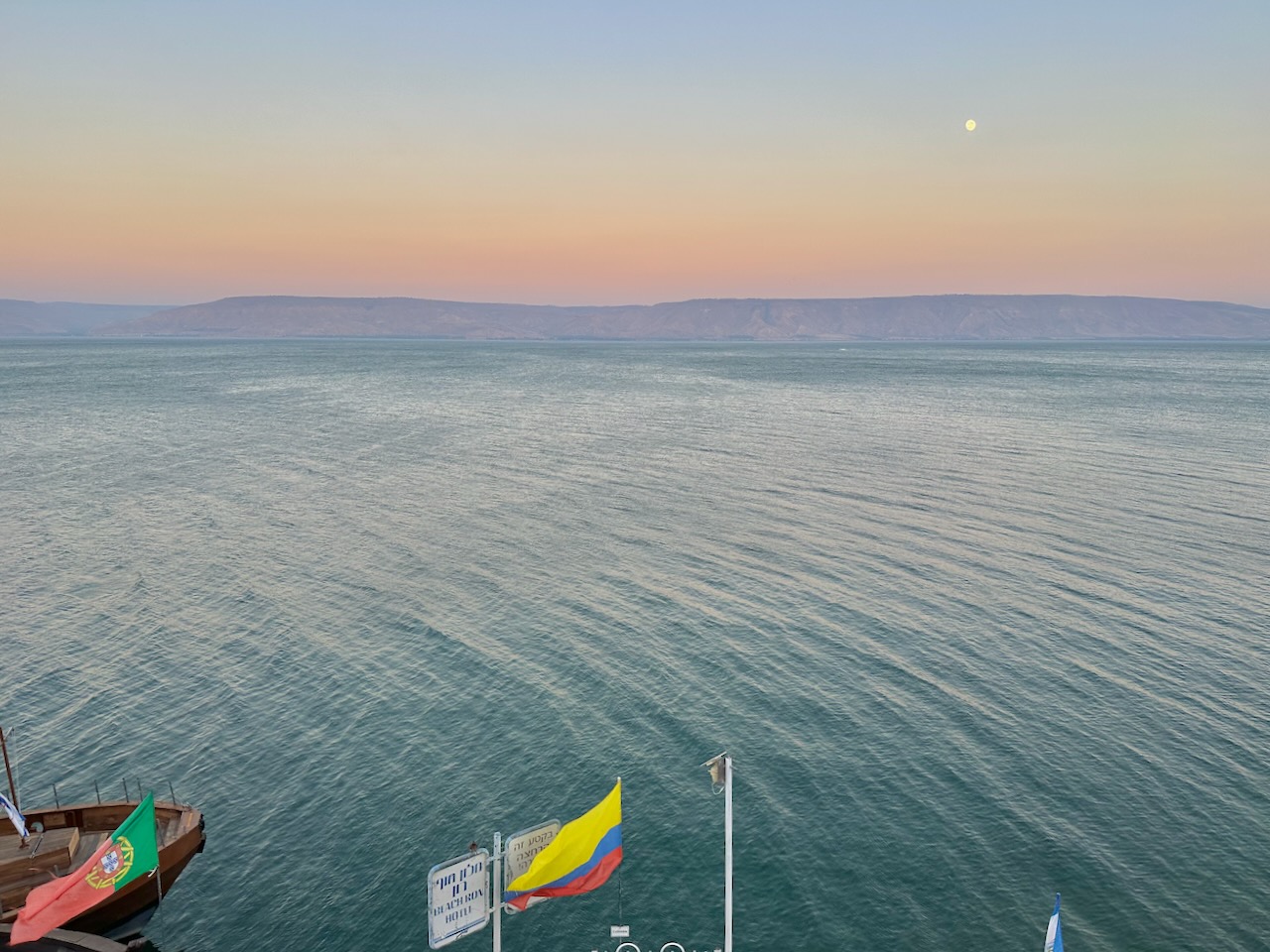
Day 4 – Saturday, September 6: Optional Sunrise Hike in the Upper Galilee (“Hill 713”), Arbel, Yardenit, Magdala, Capernaum, Boat Ride
Today began early for 16 of us (4:50 a.m.) and a bit later for the other half of the group. We spent the entire around (and on) the Sea of Galilee. The weather was once again predictably warm, with temps on the 90s. We left the hotel a little later this morning (at 8:15). We read from Matthew 4 as drove to Arbel.
“Hill 713” (Mitzpe Ha-Yammim)
The early morning departure at 4:50 was for the purpose of driving to “Hill 713” (Mitzpe Ha-Yammim in Hebrew, the “view of two seas”) for the sunrise hike (.8 miles). We arrived at the trailhead at about 5:30, and made it to the “view” by 6 a.m. Located on part of the Merom Range, this viewpoint provides the very best view of the entire Sea of Galilee, the Lower Galilee areas, and the entire width of Israel! On a clear day one can even see as far west as Tel Aviv area and the Med Sea! This morning the visibility was descent enough for us to see the outline of the lake, and most of the Lower Galilee. After the sun rose, we hiked back to the bus and drove back to the hotel. We arrived by 7:30 in time for a later breakfast.
Mt. Arbel
At 8:15, the entire group left the hotel and drove about 10 minutes, arriving at the trailhead that leads to the top of Mt. Arbel, a mountain on the west side of the Sea of Galilee. Eight (8) in the group choose to hike the challenging trail that ascended to the top, while the others drove around the back side and walked to the top from the visitor center. Even though it was a bit hazy, the view of the lake from the top was spectacular. As we all gathered on top, we read from Matthew 5 (the “Beatitudes”). While there is a traditional Catholic location for the Mt. of Beatitudes, perhaps the lower slopes of Arbel may have been the place where Jesus about. The kingdom proclamation of Jesus was His “go-to” message throughout His ministry! Additionally, while we can’t know for sure, it could have been the top of this cliff where Jesus met His disciples after His resurrection and shared the “Great Commission” (Matthew 28). After walking down to the visitor center, we were treated to ice cream (thanks Amiel Tour) before getting back on the bus.
Yardenit/Jordan River Baptism
Next, we drove to the southern end of the lake where the Lower Jordan begins. Here, 14 in the group reaffirmed their faith in baptism in the Jordan River at a place called Yardenit. Pastors Daniel and John officiated the baptism. Jesus Himself was baptized at Bethany Beyond the Jordan located further south across from Jericho (John 1). The experience was special for all of us!
Kinneret Cemetery
From the southern end of the lake we now drove north along the southwestern shoreline of the lake. We included an extra stop at the Kinneret Cemetery. This is where an early Jewish pioneer woman named “Rachel” is buried. Shlomo shared about her life. She was an Ukrainian Jew who wrote poems, some of which were put to songs. She died in 1931.
Magdala
From here we drove north of Tiberias to the Plain of Genesseret. After our tasty fish lunch, we visited the ancient city of Magdala. This was a large Jewish city in the days of Jesus. We saw a modest 1st century synagogue here. Although the city is only mentioned once (the end of Matthew 15), Jesus must have taught here.
Capernaum
Our last archaeological site of the day, Capernaum, is located on the NW corner of the lake. This Jewish town served as Jesus’ “home base” for His Galilean ministry. In the late 4th/early 5th century synagogue we recalled the stories from Mark 1, 2; Luke 7,8; and John 6. We also saw the Byzantine church, octagonal in shape, that dates to about the same time period. This ancient church surrounds a 1st century house structure suggested, by tradition and archaeology, to be Peter’s house. Down on the lakeshore, we ended with Mark 9. Serving in Christ’s kingdom requires a heart of humility and servanthood.
Sea of Galilee Boat Ride
Our last stop of the day was back to Tiberias where we embarked on our 45 minute boat ride. Being out on the water was inspirational! The stories of Mark 4 and Matthew 14 were shared. Jesus cares for us, especially when we encounter the “storms” of life. Sailing back to the dock, we returned to the shoreline, boarded our bus, and drove back to our hotel nearby. It was a great day of focusing upon Jesus!
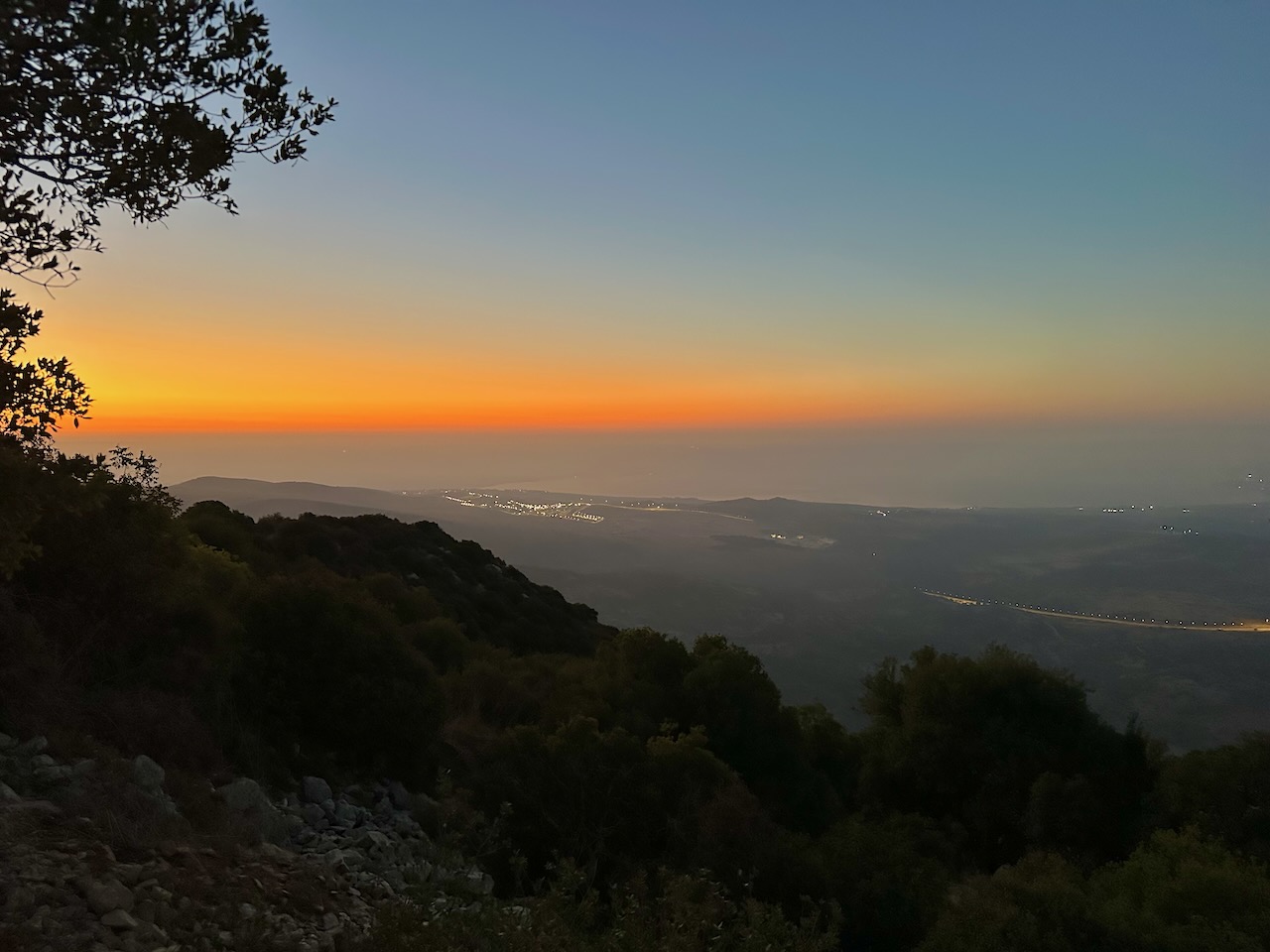
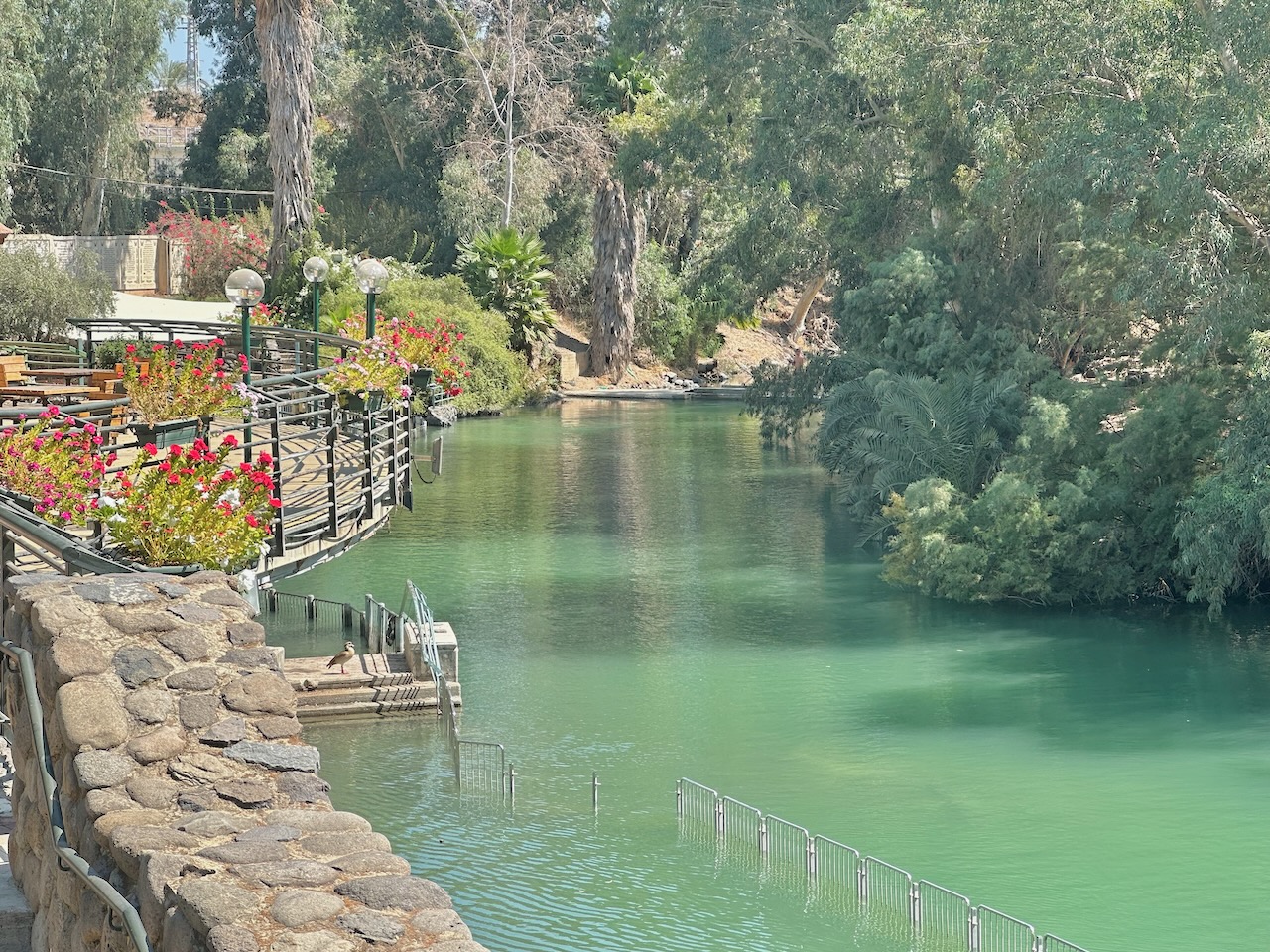
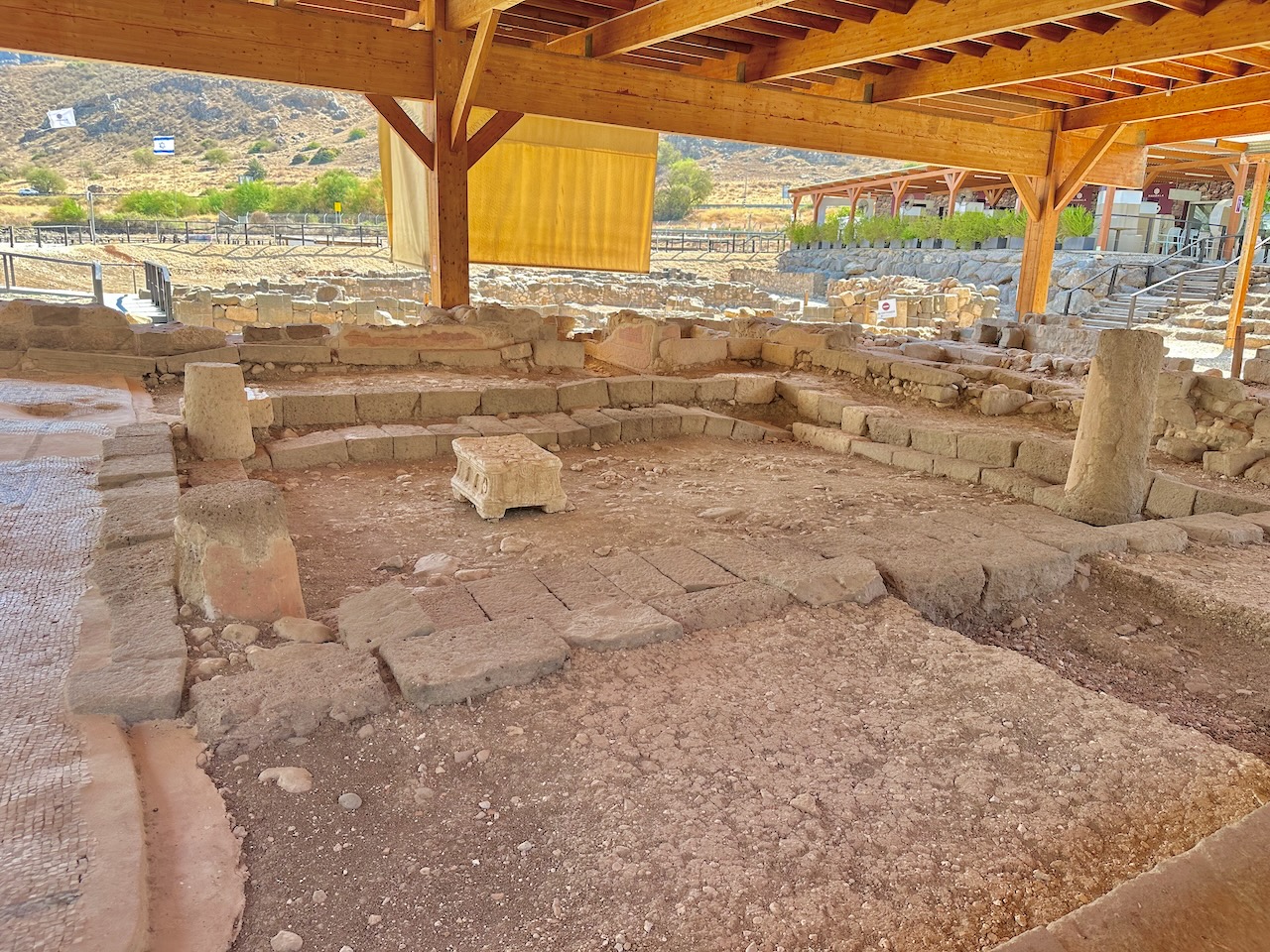

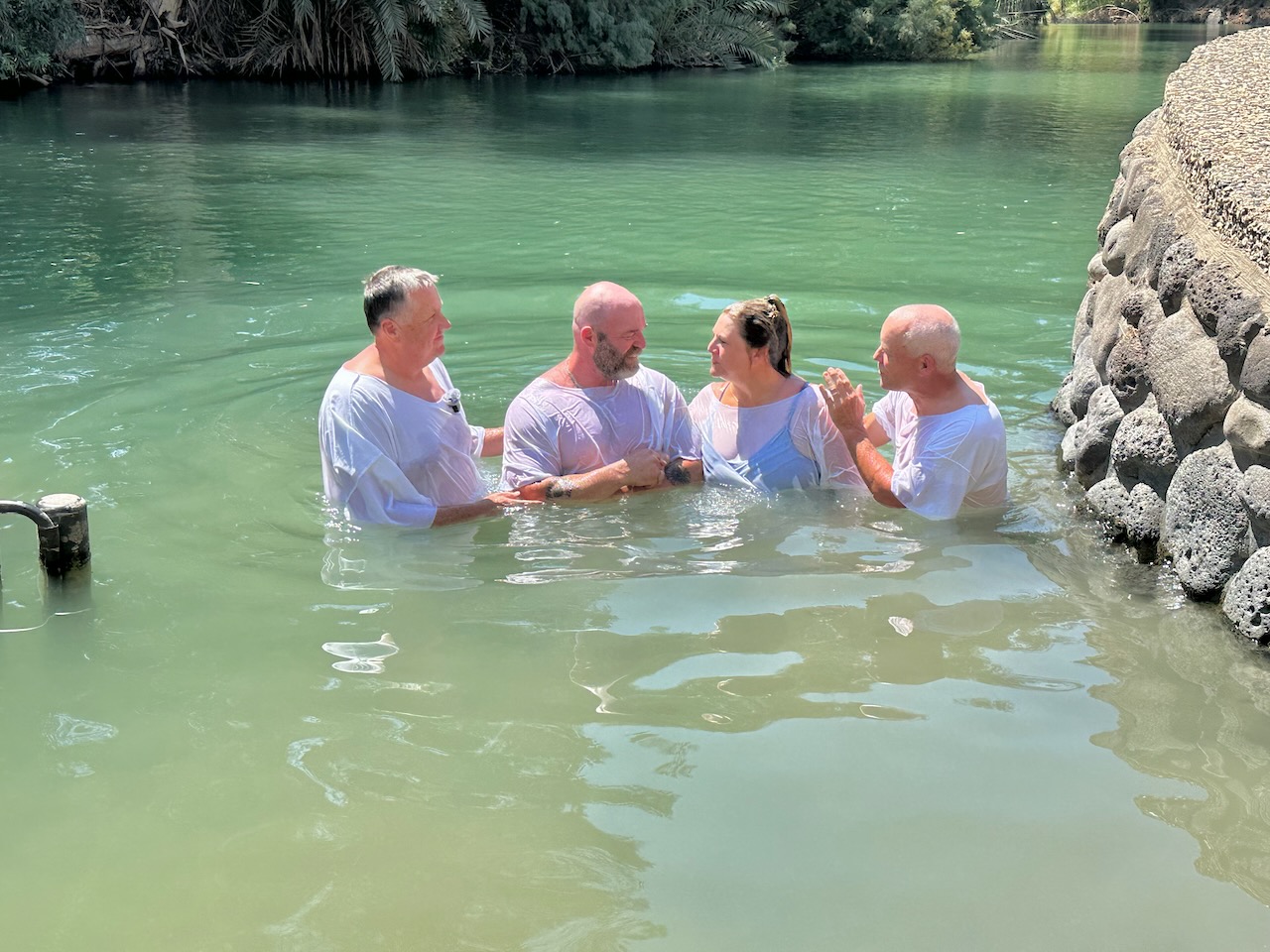
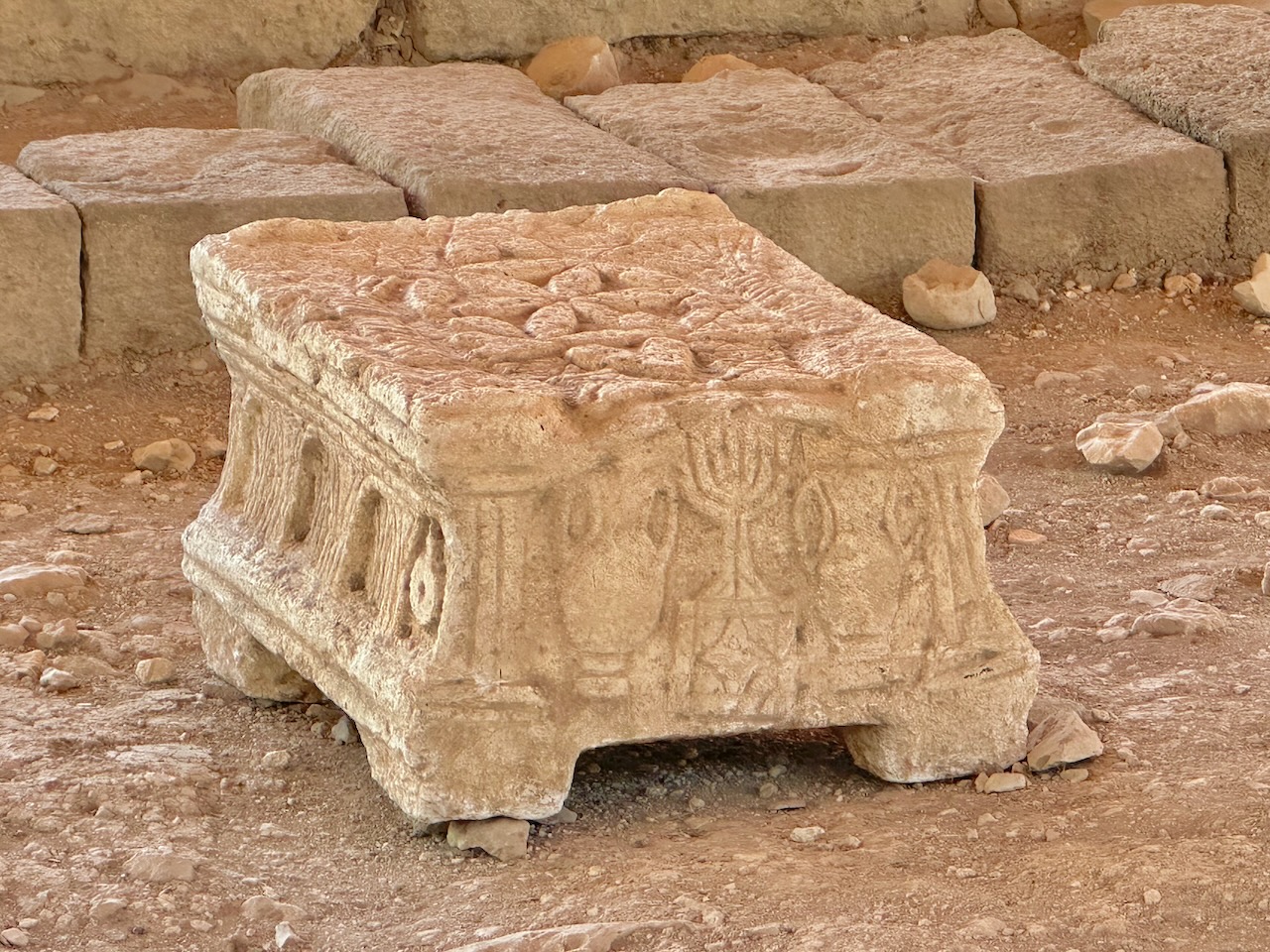
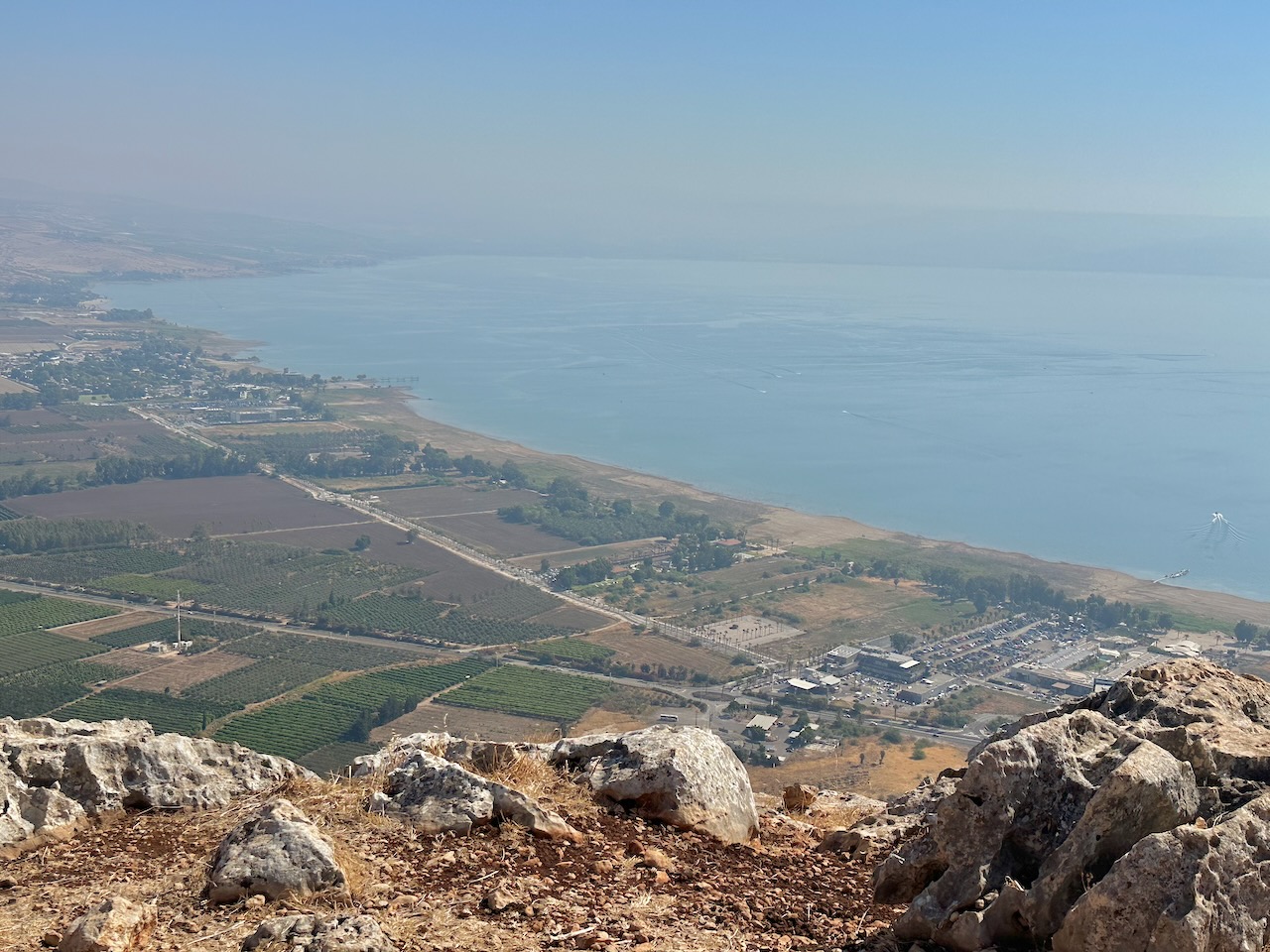
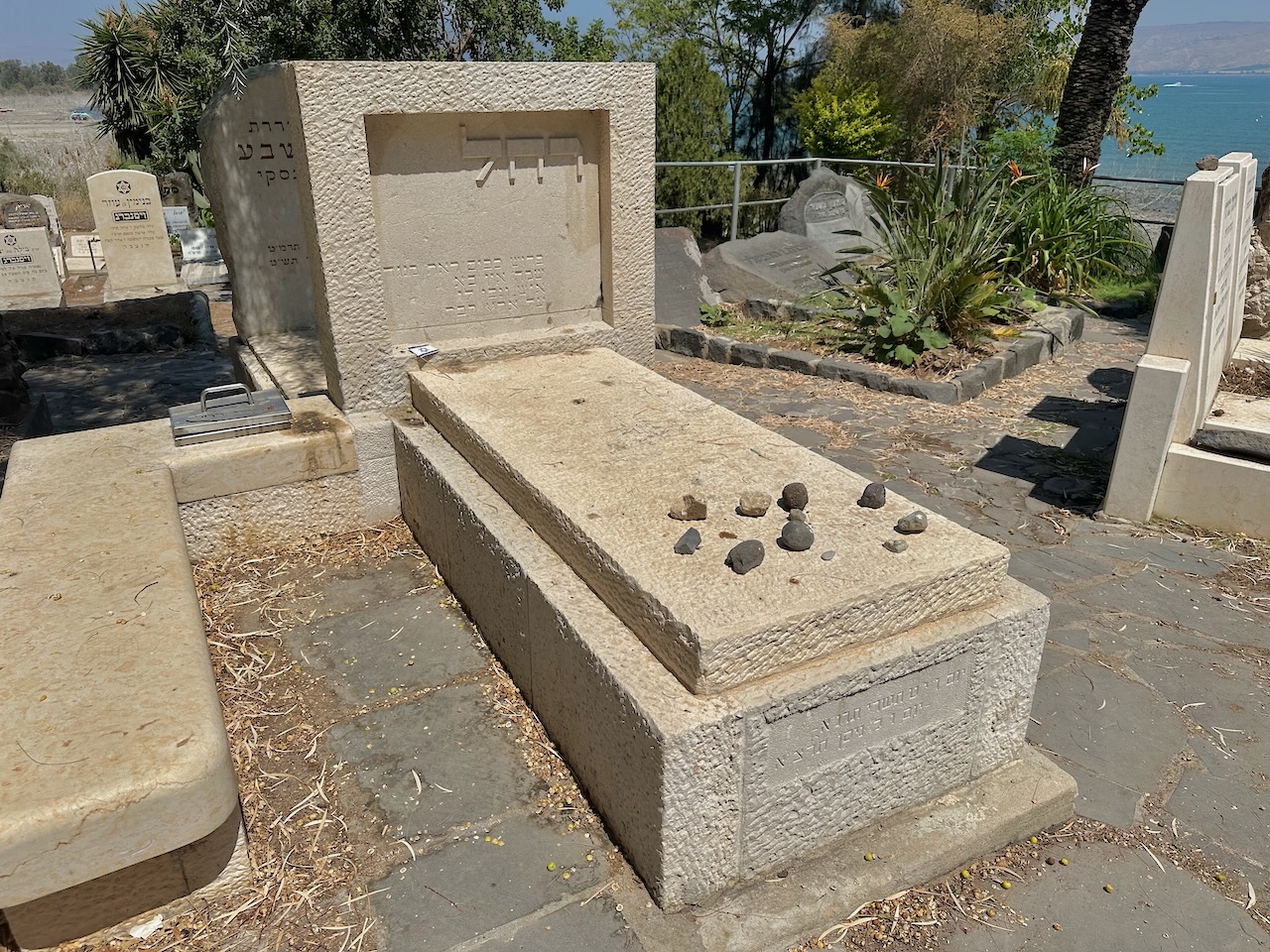
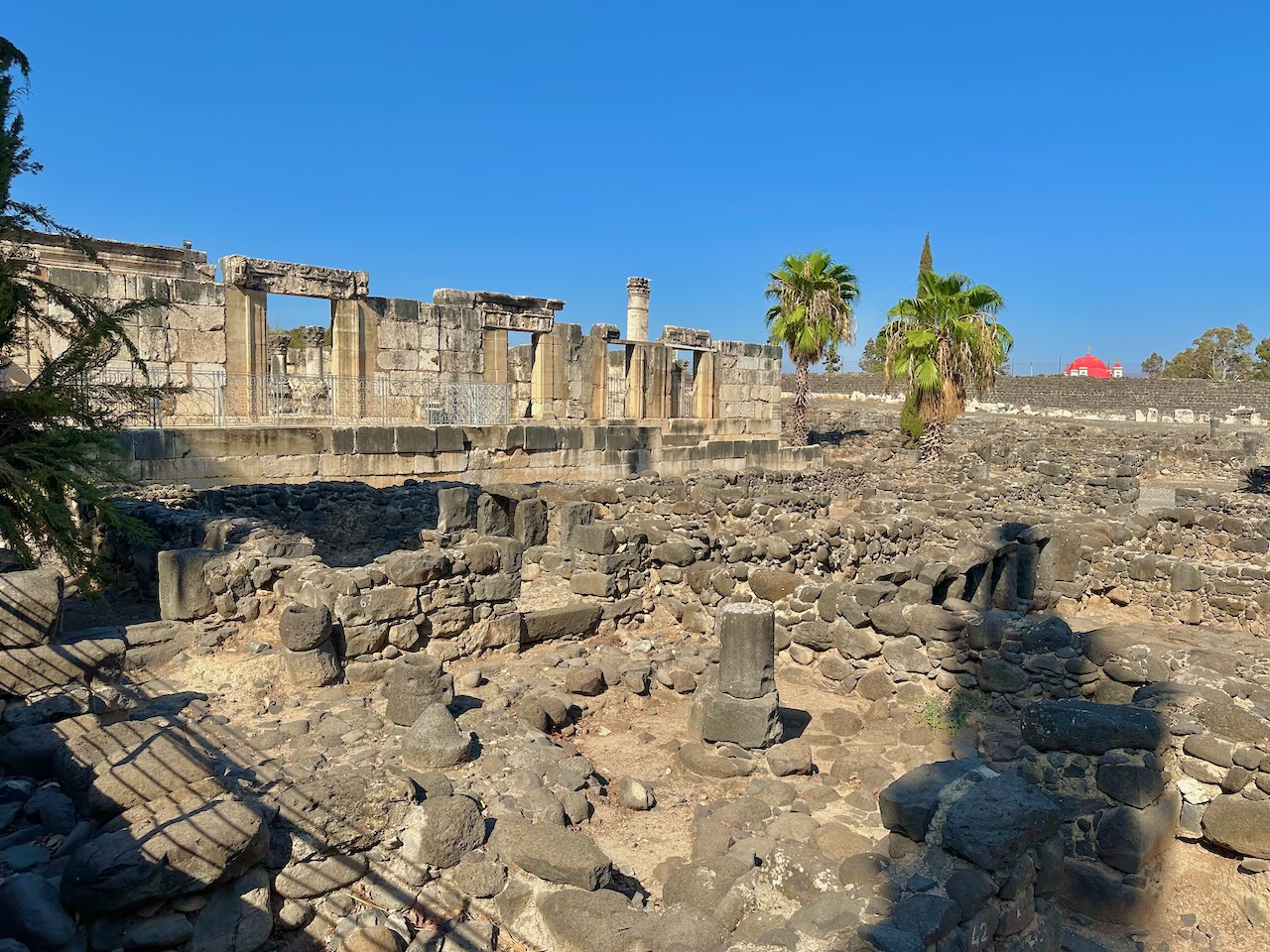
Day 5 – Sunday, September 7: Hippos, Qatzrin, Syrian Border, Caesarea Philippi, Dan, Misgav Am
Today we traveled north to the Golan Heights. It was a cooler day, with full sun and highs in the 80s. Everywhere we went we had every site to ourselves (once again). We left the hotel at 7:30, reading Matthew 13 as we began our drive north.
Hippos/Sussita
We first traveled north to the northern end of the lake. This is the location of Bethsaida, the home of Peter, Andrew, and Philip (John 1). We then turned south as we drove on the east side of the lake. We made a brief stop at the only “cliff” area on this side. No doubt this is where Mark 5 took place. We continued to Hippos/Sussita. Here at Hippos (a Decapolis city), we saw many Roman ruins. During the Byzantine Period (4th-6th centuries AD), there were no less than a half a dozen churches were built here. With a great view of the lake, we read the transformational story of the demoniac from Mark 5 (which most likely happened down near the lakeshore). The view across the lake was really good.
Katzrin
Next, we drove back north to Katzrin, the largest city in the Golan Heights. We visited the Talmudic Village that is here (from about the 3rd-8th centuries AD). We saw good examples of olive presses, the synagogue, and other house structures. We then gathered in a completely-restored stone house where we read from Mark 2. We could see the story unfolding before our eyes!
Syrian Border/Qunetra
Next, we drove to the base of a IDF military establishment located on the border with Syria. Here, Shlomo shared with us some of the modern history between Israel and Syria (ie. 1967 and 1973 wars). We looked across to see Qunetra, once a Syrian town.
Caesarea Philippi/Banias
Descending down of the Golan Heights, we stopped at the archaeological site of Caesarea Philippi. This was a very pagan city in the days of Jesus and through the Roman Period. The city enjoyed the waters of the Banias Spring, one of the three tributaries of the Jordan. We read from Matthew 16 where Jesus asked His disciples the “final exam” question, “Who do you say I am?” Among the ruins at the Grotto once stood the Temples of Augustus, Zeus/Jupiter, Nemesis, the Shrine of the Dancing Goats, and the niches dedicated to Pan, the promiscuous shepherding god of the Greeks and Romans. Six days later, Jesus was transfigured (perhaps somewhere on the lower slopes of Mt. Hermon, Matthew 17).
Dan Nature Preserve & Archaeological Site
Nearby a short distance to the west is the Nature Preserve and and archaeological site of Tel Dan. The Dan Spring served this ancient city originally called Laish. We walked along the river to a quite place where we recalled Psalm 42 (“as the deer pants for water…”) before we walked to the archaeological ruins of the high place. We read from Judges 18 and 1 Kings 12 about the patterns of disobedience displayed here. Leaving the site of Dan we saw the a mud-brick Middle Bronze gate (probably not seen or used by Abram) and the Iron Age/Israelite gate and where the famous Dan Inscription was found in July, 1993.
Misgav Am/Lebanon Border
Our last stop of the day was to Misgav Am, a community overlooking the Lebanon border. The view into Lebanon was outstanding. Again, Shlomo shared some modern history about Lebanon and the challenge that Hezbollah has posed over the years. To see the total destruction by the IDF of Lebanese towns where Hezbollah were entrenched (and from where they shot 1000s of rockets into Israel) was incredible to see!
We returned back to our hotel for another incredible dinner. We also enjoyed seeing the lunar eclipse that happened between 8:30 – 9:30 pm (9:11 being full eclipse). The “red moon” was amazing to see over the Sea of Galilee!
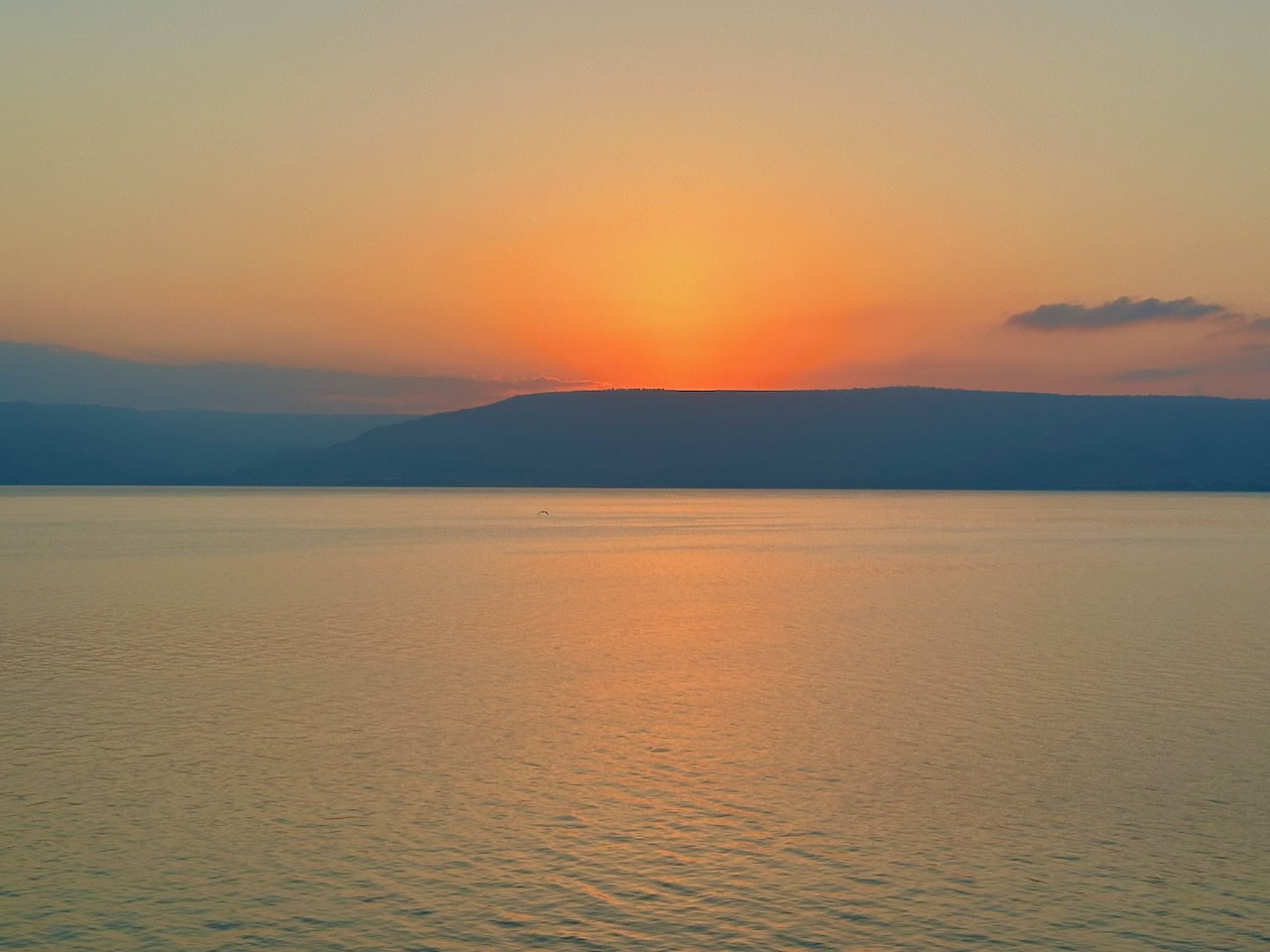
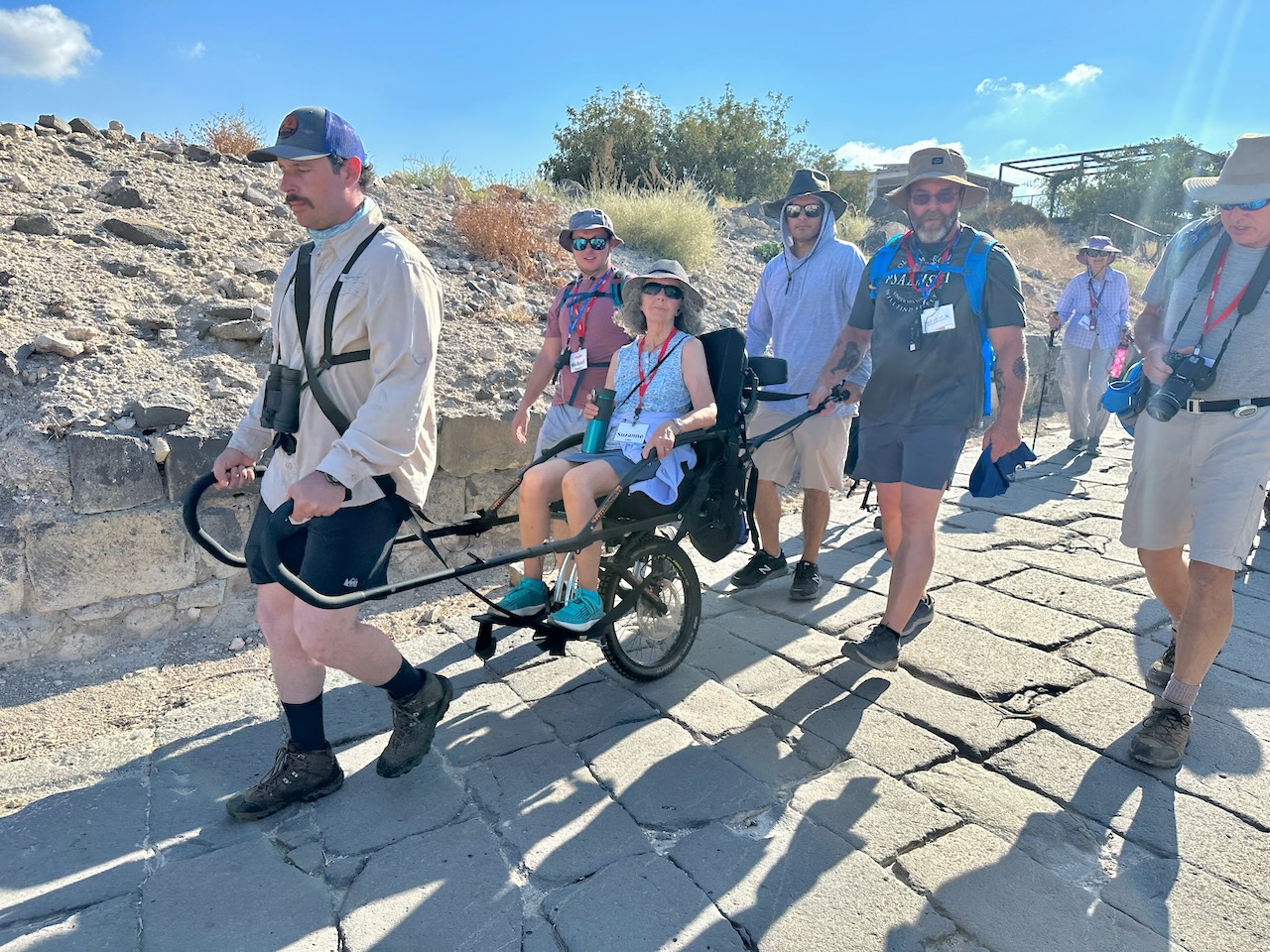


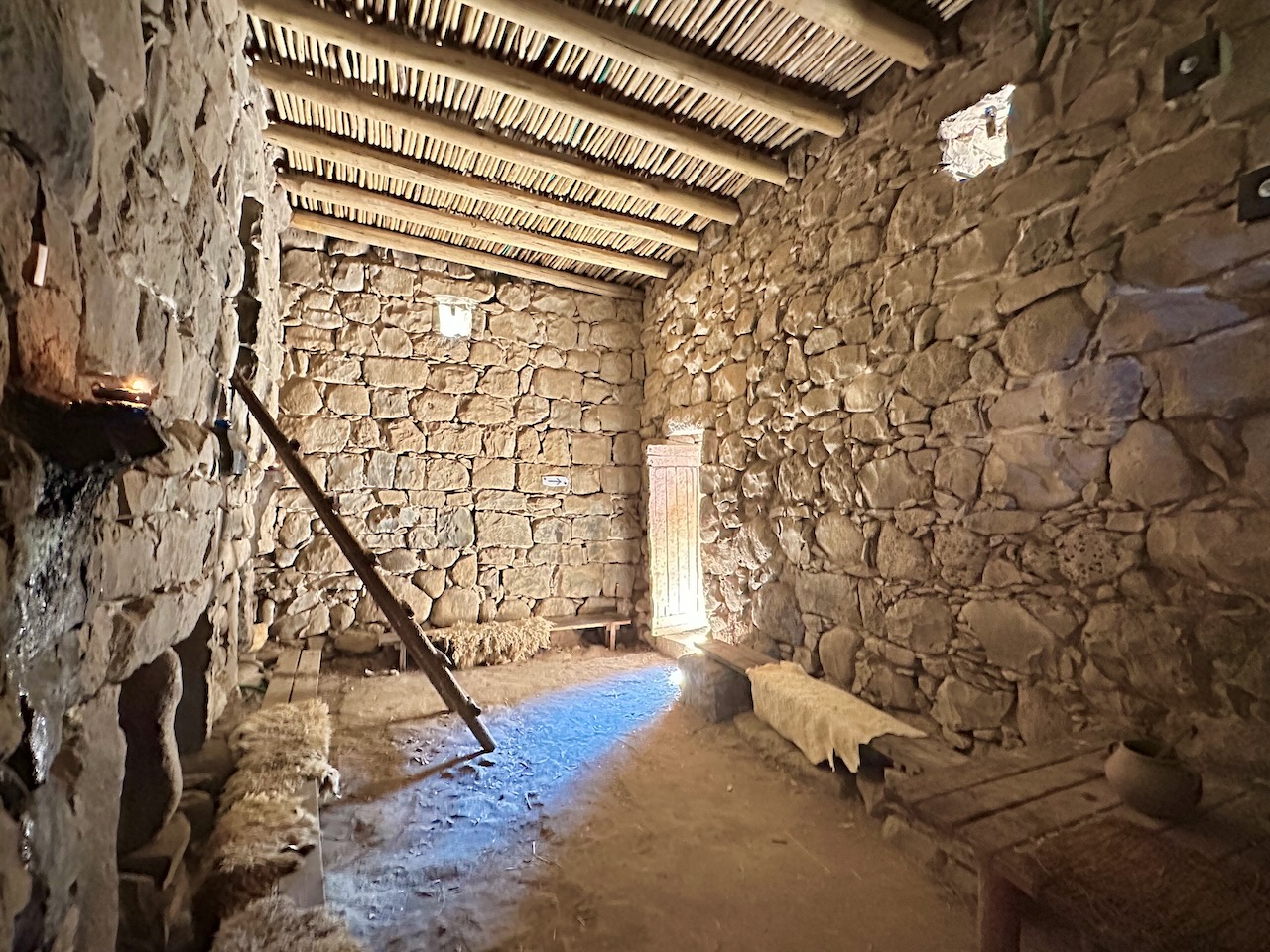

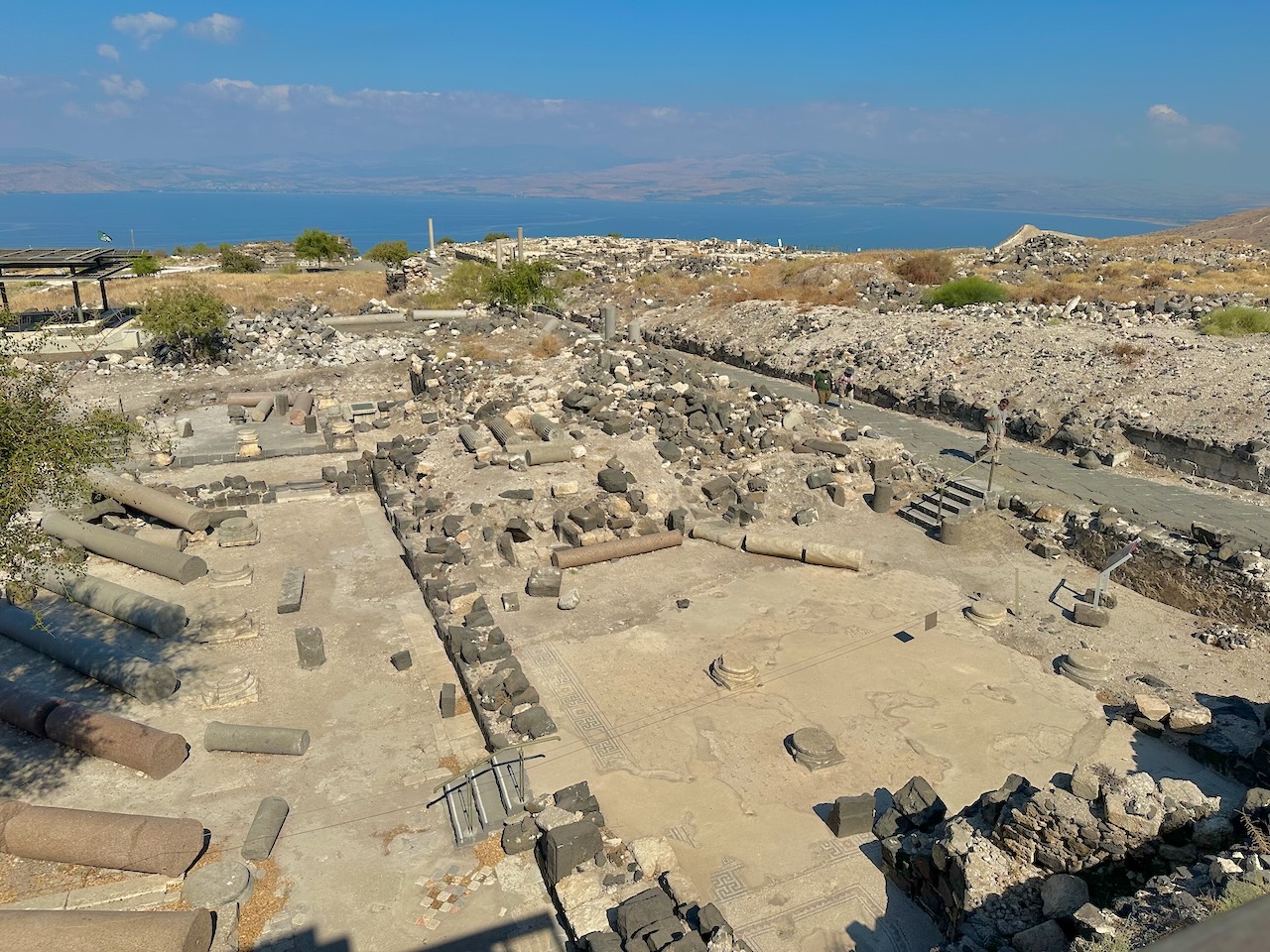
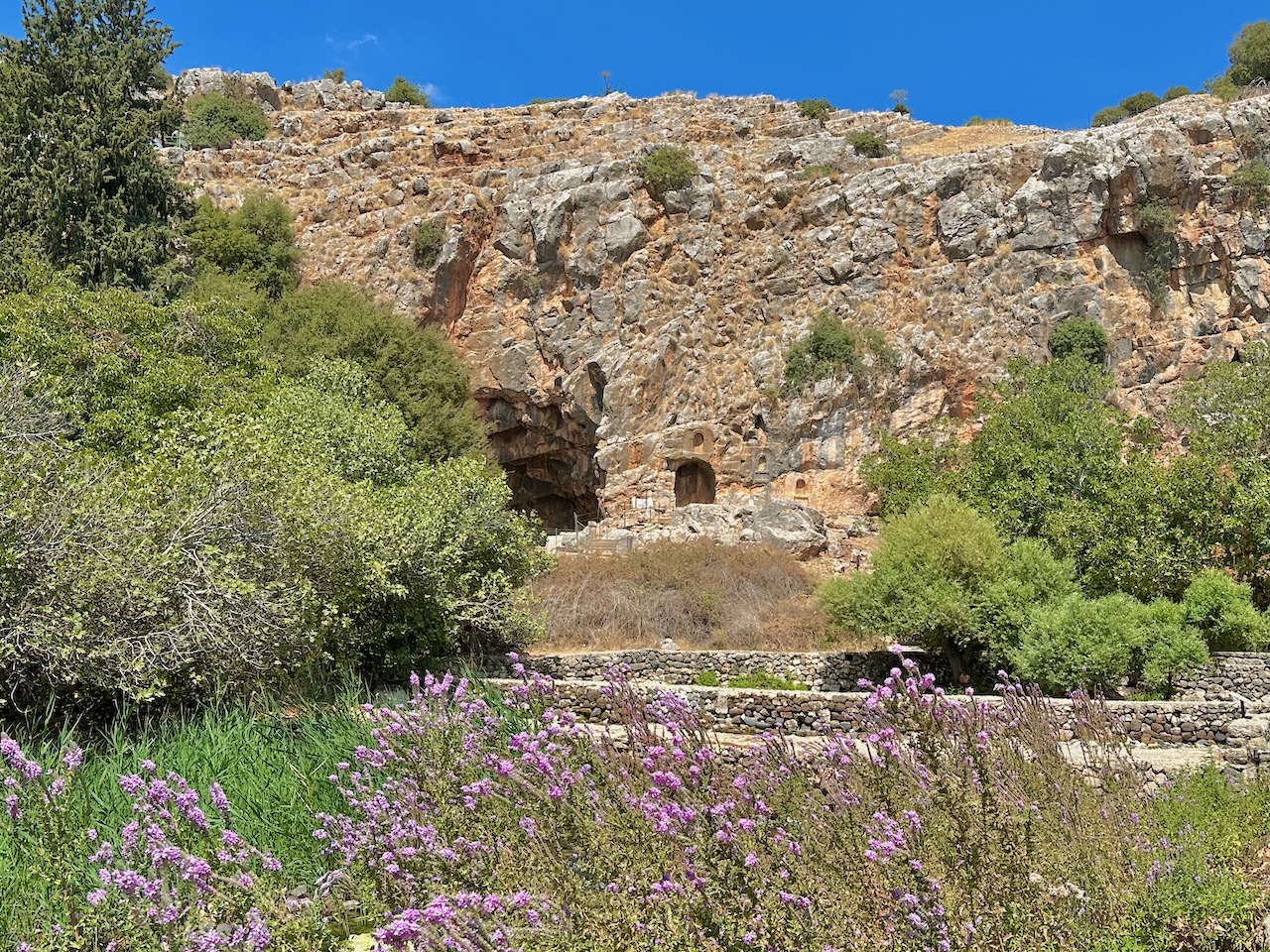

Day 6 – Monday, September 8: Jordan Northern Border Crossing, Jerash, Mt. Nebo, Machaerus, Madaba
Today we crossed into Jordan! Following breakfast and loading the bus, we left the hotel about 7:25. We read portions of Matthew 5-7 as we drove south, saying goodbye to Tiberias and the Sea of Galilee. The weather was again sunny, with temps a bit cooler (low 80s) in Jordan today.
Sheik Border Crossing
It took about 50 minutes to arrive at the Sheik Border Crossing. The procedures went rather slow, as expected on both sides. However, we crossed without issues. On the Jordanian side we were greeted by Sam, our Jordanian guide) and our driver, Rashid.
Jerash
Following the completion of the Jordanian crossing procedures, we drove directly to Jerash. We passed by Pella, known to be the place to where early Christians retreated for safety following the destruction of the Temple in Jerusalem. Jerash was a Decapolis city, one of 10 major Roman cities. Most of the ruins date to the 2nd Century AD. We started at Hadrian’s Arch and then walked through the hippodrome and past the Zeus Temple. We then visited the incredible theater. Most in the group then walked to theater side of the site to see the Decumanus (east-west street), Temple of Dionysus, and Temple of Artemis. There were many Byzantine churches also built here. We walked out of the site on the Cardo (the north-south street). We walked past the nymphean. Jerash is one of the most well-preserved Roman cities in the world! It was incredible!
Machaerus
Leaving Jerash at 2:35, our drive to our next site, Machaerus, was scenic. We passed by the Jabot River where Jacob wrestled with God (Genesis 32).We also drove on there outskirts of Amman, Jordan’s capital. We finally arrived at Machaerus. Originally built by the Hasmoneans and then taken by Pompey in 63 BC, Machaerus was eventually reestablished by Herod the Great as another “palace-fortress.” It is located on the east side of the Dead Sea. This was where John the Baptist was be-headed (Josephus and Matthew 14). Many of us climbed to the top to see where the head of John the Baptist was offered to Herod Antipas (the “throne room” according to an Austrian archaeologist). On top were a few ritual baths too. Although it was a bit more hazy this afternoon looking westward, we could clearly see the Dead Sea and the vicinity of Ein Gedi on the other side.
Madaba
It was about a 35 minute drive to our hotel in Madaba (Sam’s hometown). We decided to visit Mt. Nebo tomorrow morning before driving south to Petra. Following check-in, we enjoyed a nice dinner before retiring early. It was a great first day here in Jordan. The highlight is yet to come tomorrow (Petra!).
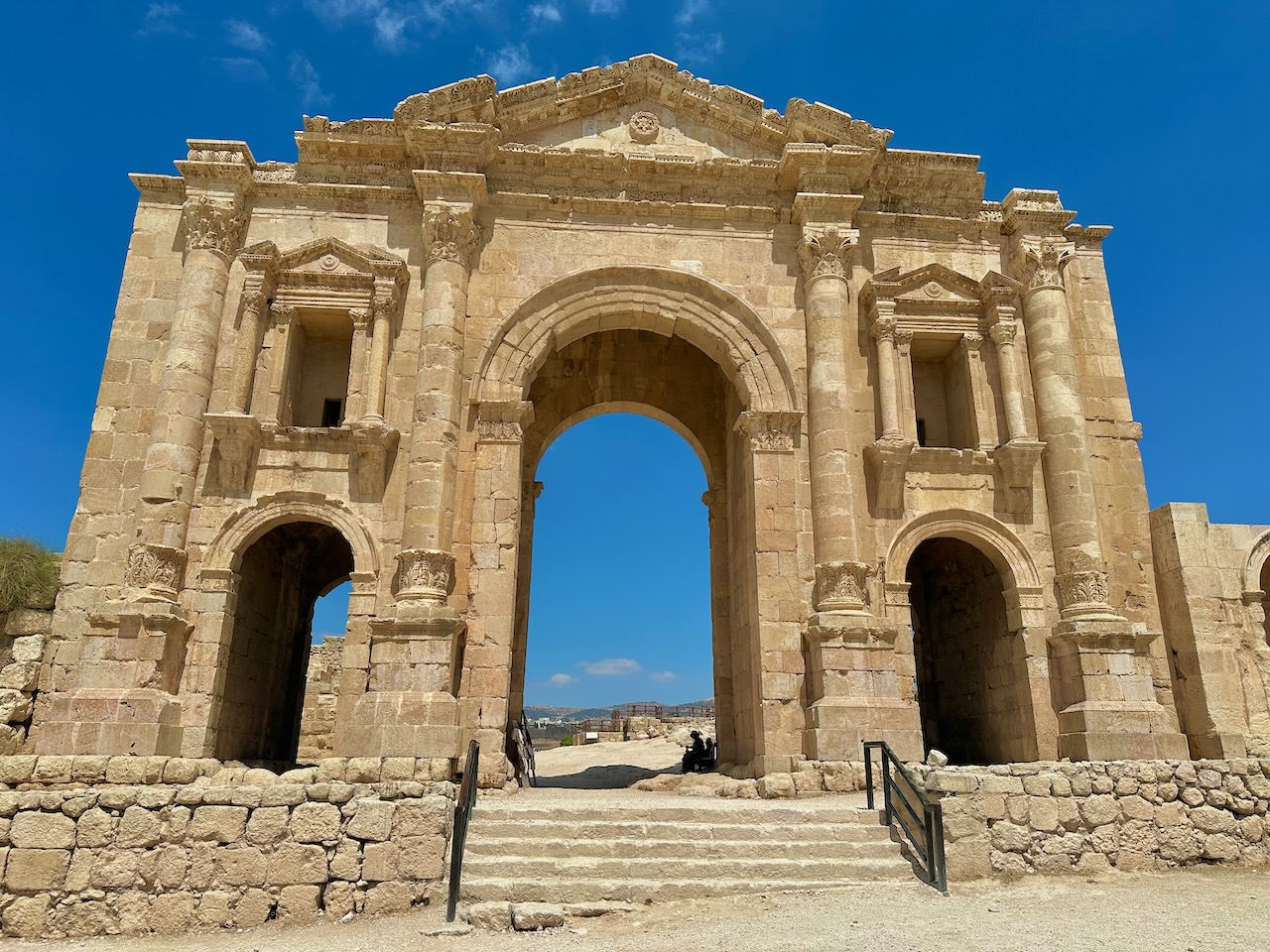
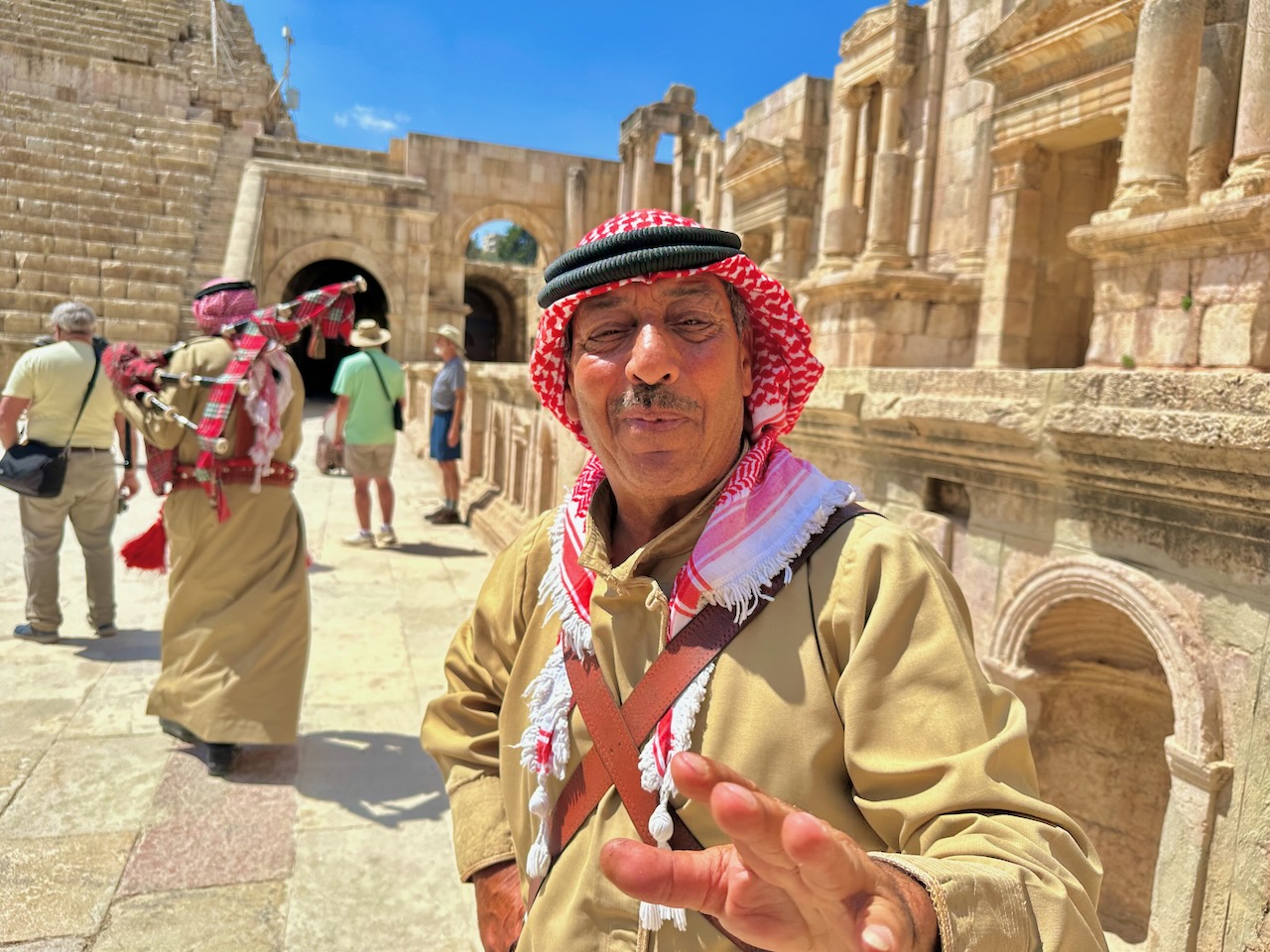

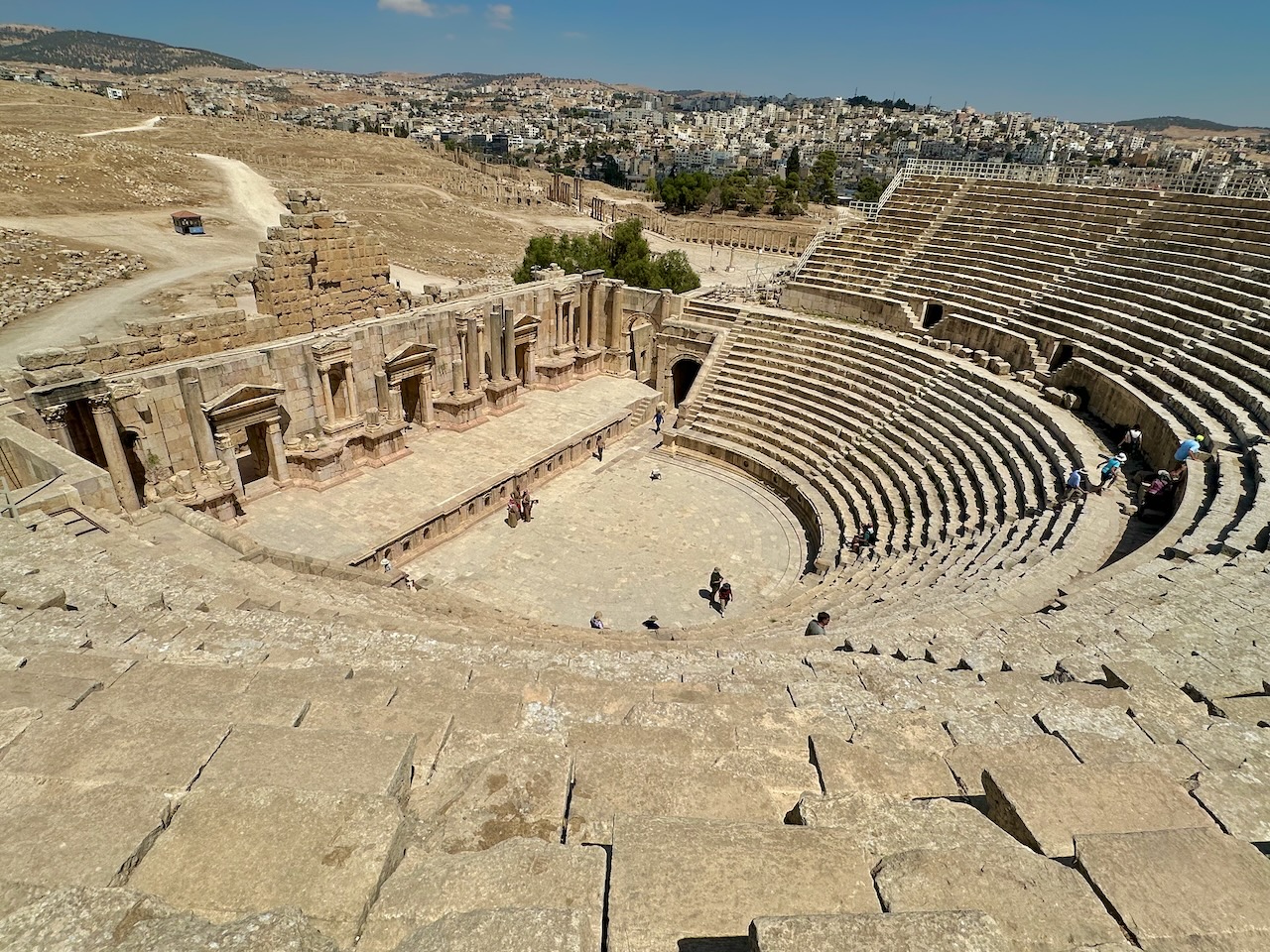
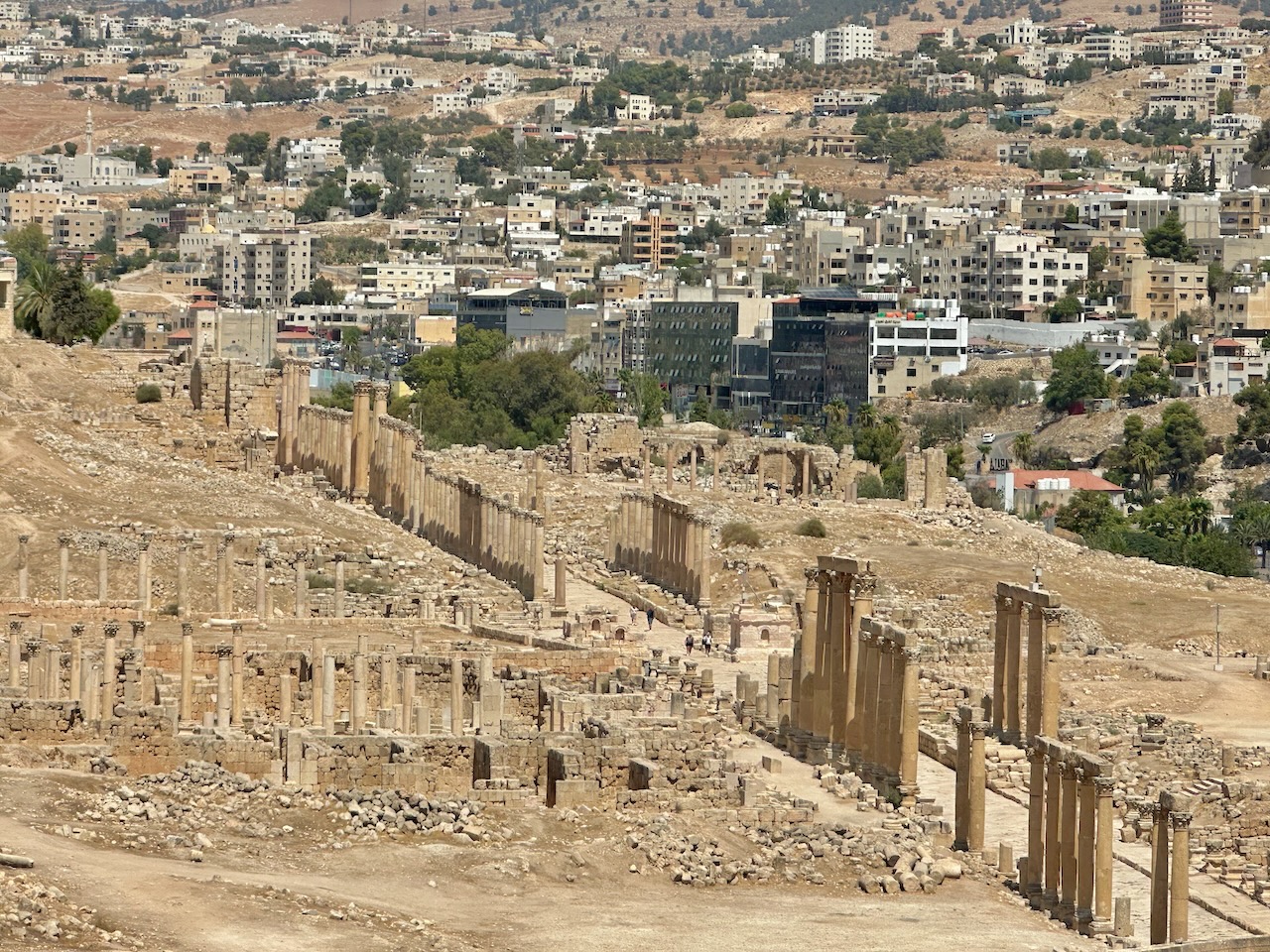
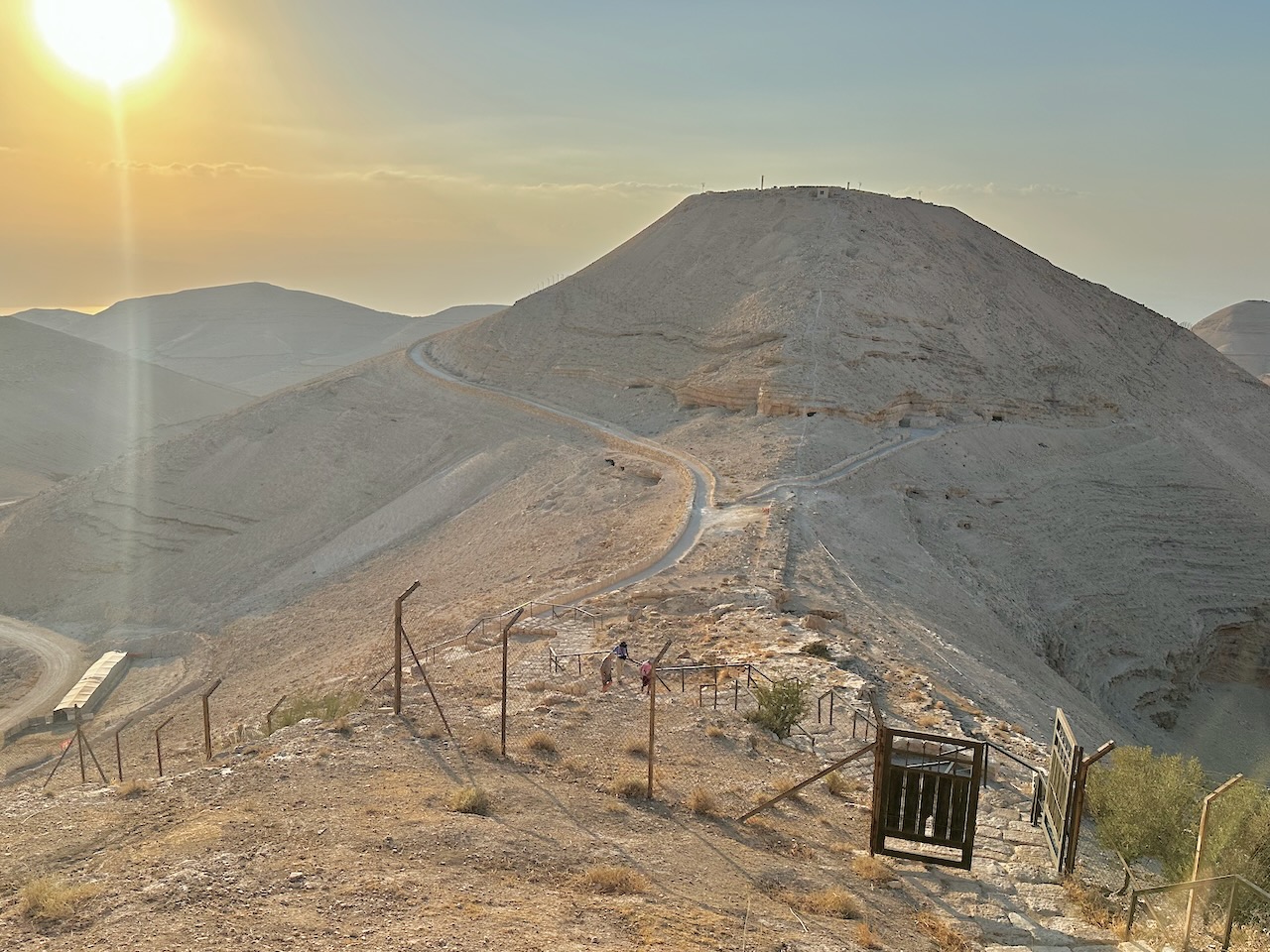

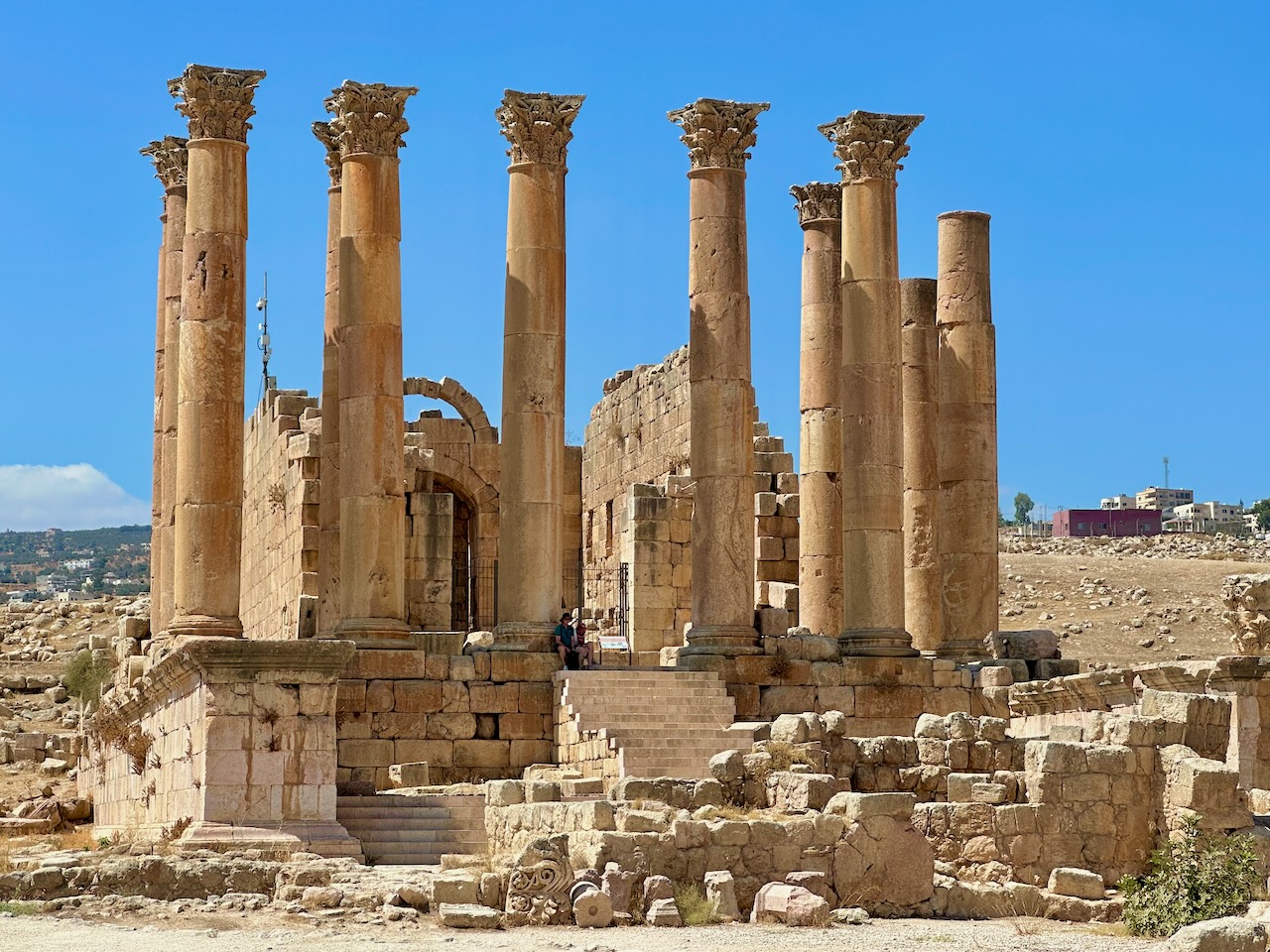
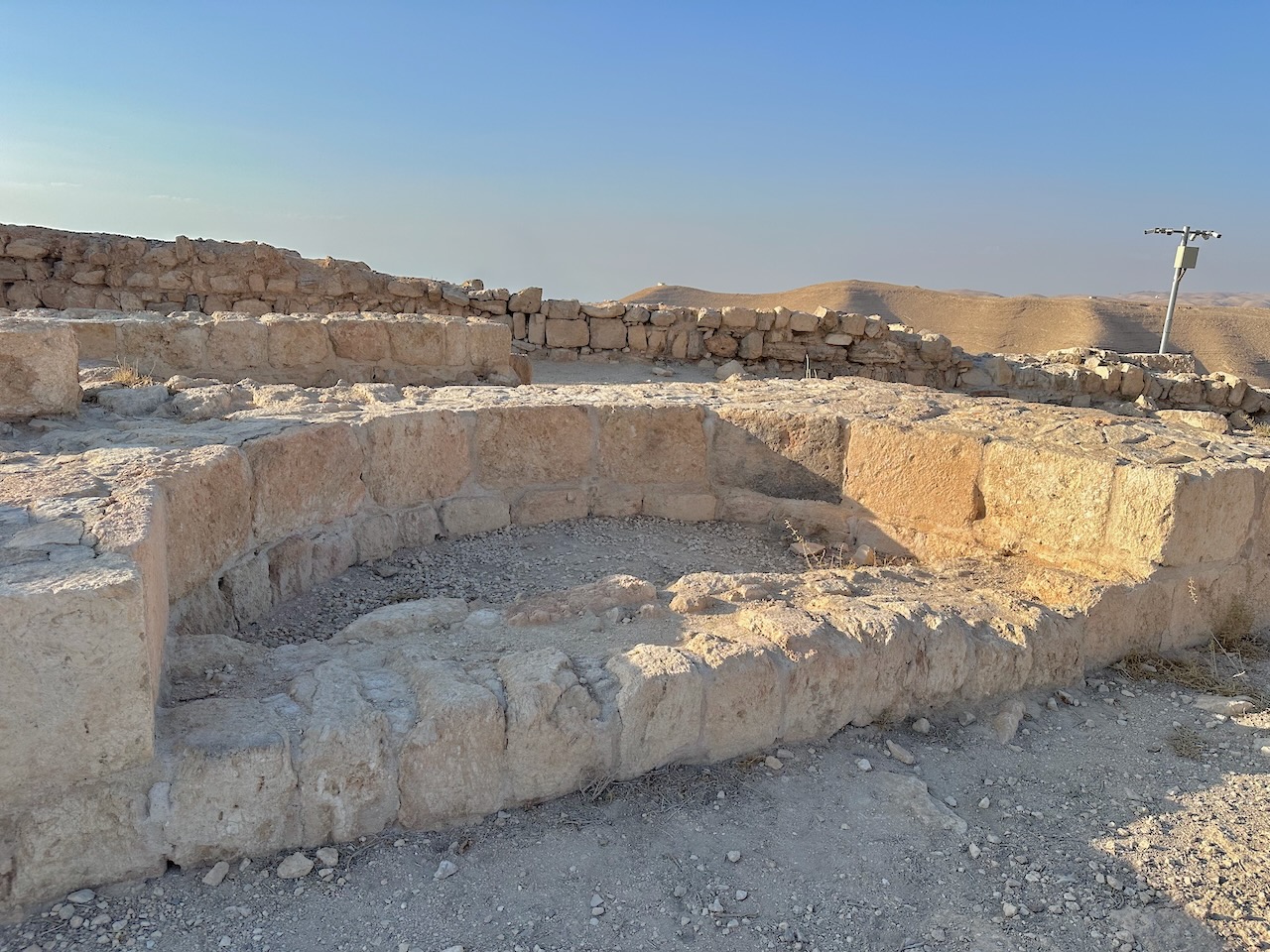
Day 7 – Tuesday, September 9: Mt. Nebo, Petra
Today was a fabulous day in every way! We saw the best of Jordan today, starting with a great view from Mt. Nebo and then visiting Petra. The skies were sunny, with a nice breeze and highs around 80. We left the hotel at 7 a.m., reading Deuteronomy 31 on the way.
Mt. Nebo
After a good night’s stay here in Madaba (with a great “home-made-tasting” dinner last night), we drove west about 15 minutes to the Pisgah Range. High above the Plains of Moab, there is an individual peak called Mt. Nebo. While the “traditional” Mt. Nebo (with a Byzantine Church and now the newly-renovated Greek Orthodox Church) wasn’t open yet, we choose an adjacent hill with even a better view. We walked about five minutes where we could look across and see the “Promised Land.” The visibility was fairly good, allowing us to see the west side of the Jordan River and the area of Jericho, as well as the northern tip of the Dead Sea. We read from Deuteronomy 34 and Joshua 1 about the transition of leadership from Moses to Joshua. As we considered the Israelites crossing into unknown territory, we know that God is in control of our unknown journeys of life, and He never leaves us too! It was a great way to begin the day!
Petra
From here we drove back around Madaba and turned south to Petra, using both the Desert and King’s Highways. We stopped once on the way for restrooms. Around 11:15 we arrived at our hotel in Wadi Musa. Dropping off our luggage here, we then walked together to the entrance of Petra and spend the entire rest of the day within this remarkable red-rose ancient city. We are in the heart of the Seir Mountains and the land of the Edomites, as mentioned in the Bible. The highest peak of these mountains is Aaron’ Peak, the traditional burial place of Moses’ brother Aaron (Mt. Hor also could be in Israel near the Zin Desert, see Numbers 20). This ancient Nabatean city was built within the Seir Mountains, the land of the Edomites (Deuteronomy 2, 33; Ezekiel 35). We all thoroughly enjoyed the spectacular scenery and tombs/ruins of this red-rose ancient city.
Once we entered the site, we all walked through the Siq (canyon) which brought us to the first monument, “The Treasury” (“Al-Khazneh”). This well-preserved monumental tomb appeared in the movie “Indiana Jones and the Last Crusade.” It was the tomb of the Nabatean King named Aretas III (Paul mentions his son, Aretas IV in 2 Cor. 11:32). His daughter (or granddaughter – depending on dating) was the former wife of Herod Antipas, see Matthew 14).
From the Treasury we now began our walk into the city. Besides passing by many of the Nabatean tombs, we walked by a 3,000-seat theater carved into the sandstone, one of the largest theaters in Jordan. From here, a number in the group walked to the Monastery Tomb at the far west side of Petra (about 900 steps with an ascent of about 600 total feet), while others explored on their own (e.g. the Royal Tombs). The Aravah and Negev of Israel could be seen in the haze to the west from the area of the Monastery.
We all walked back down the trail to where some explored more of Petra on their own, while others took the shuttle bus back to the hotel. Ten in the group continued the adventure with a hike up the back side of the High Place. This trail was scenic yet more challenging with its steep climb towards the top. We all made it to the High Place, with the view from here being remarkable.
We all returned back to the hotel at our own pace. An amazing dinner was served at 7 p.m. up on the rooftop of the hotel. We all who to rest well tonight after a long but incredible day of walking and hiking!

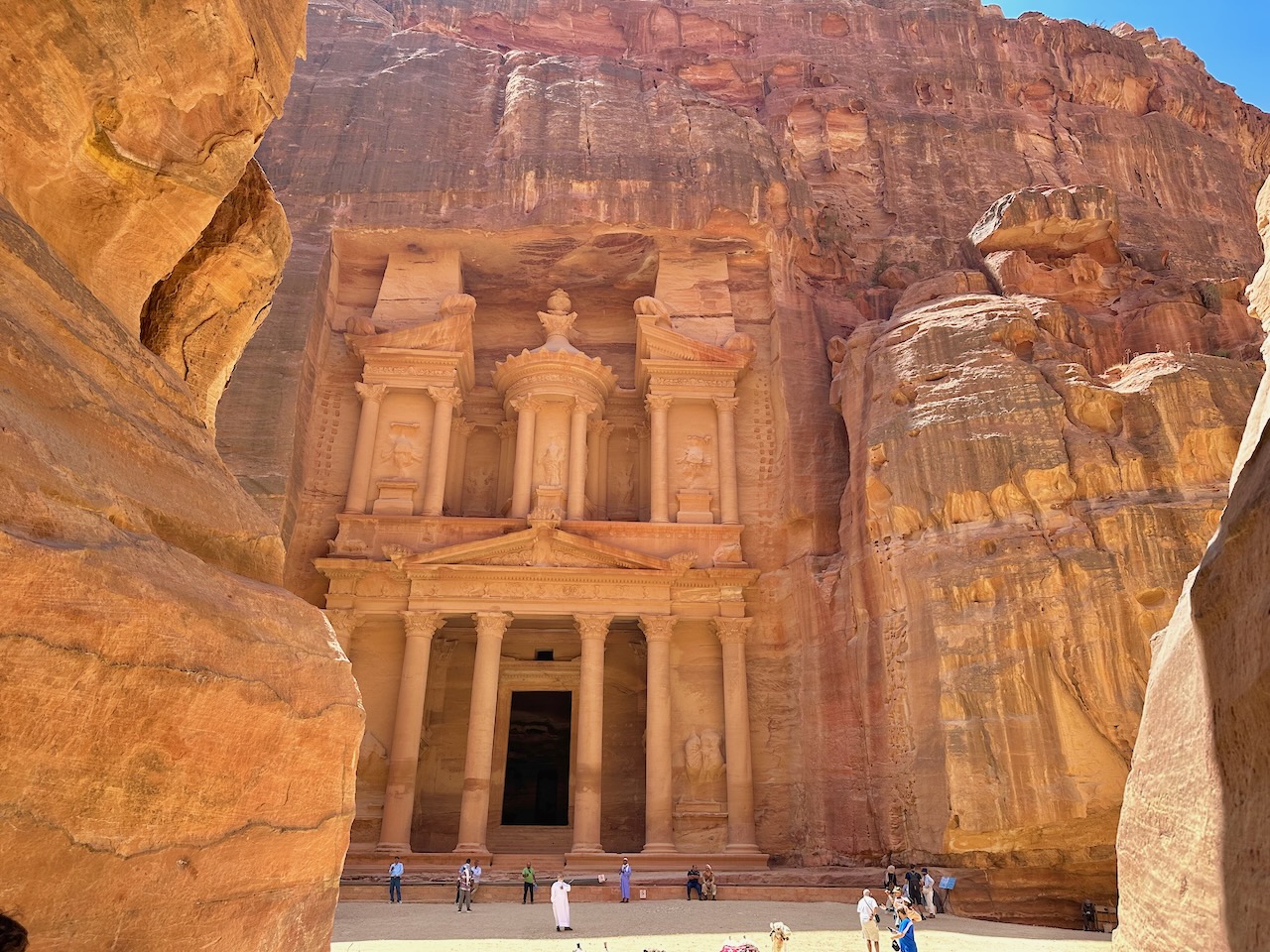
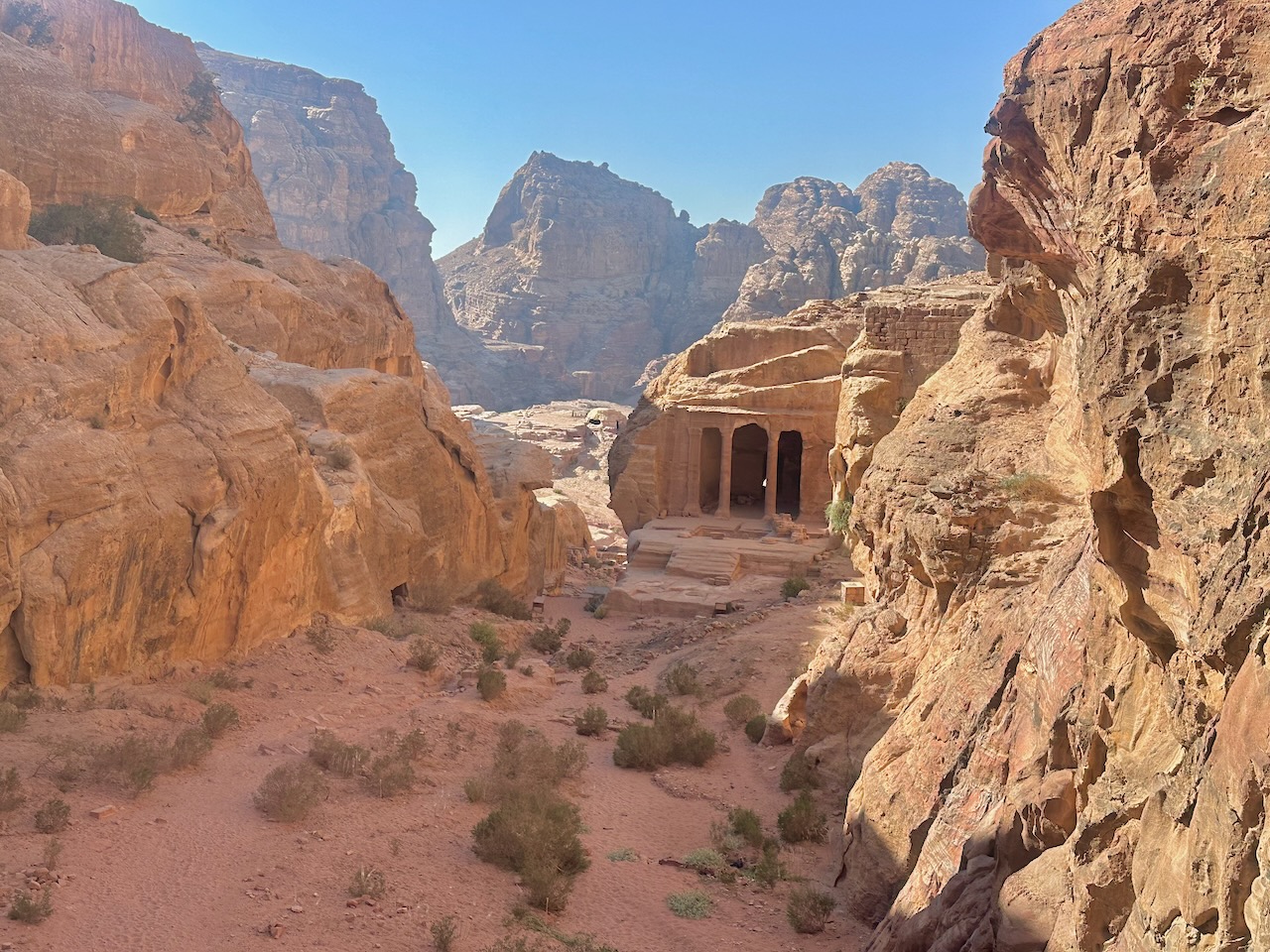
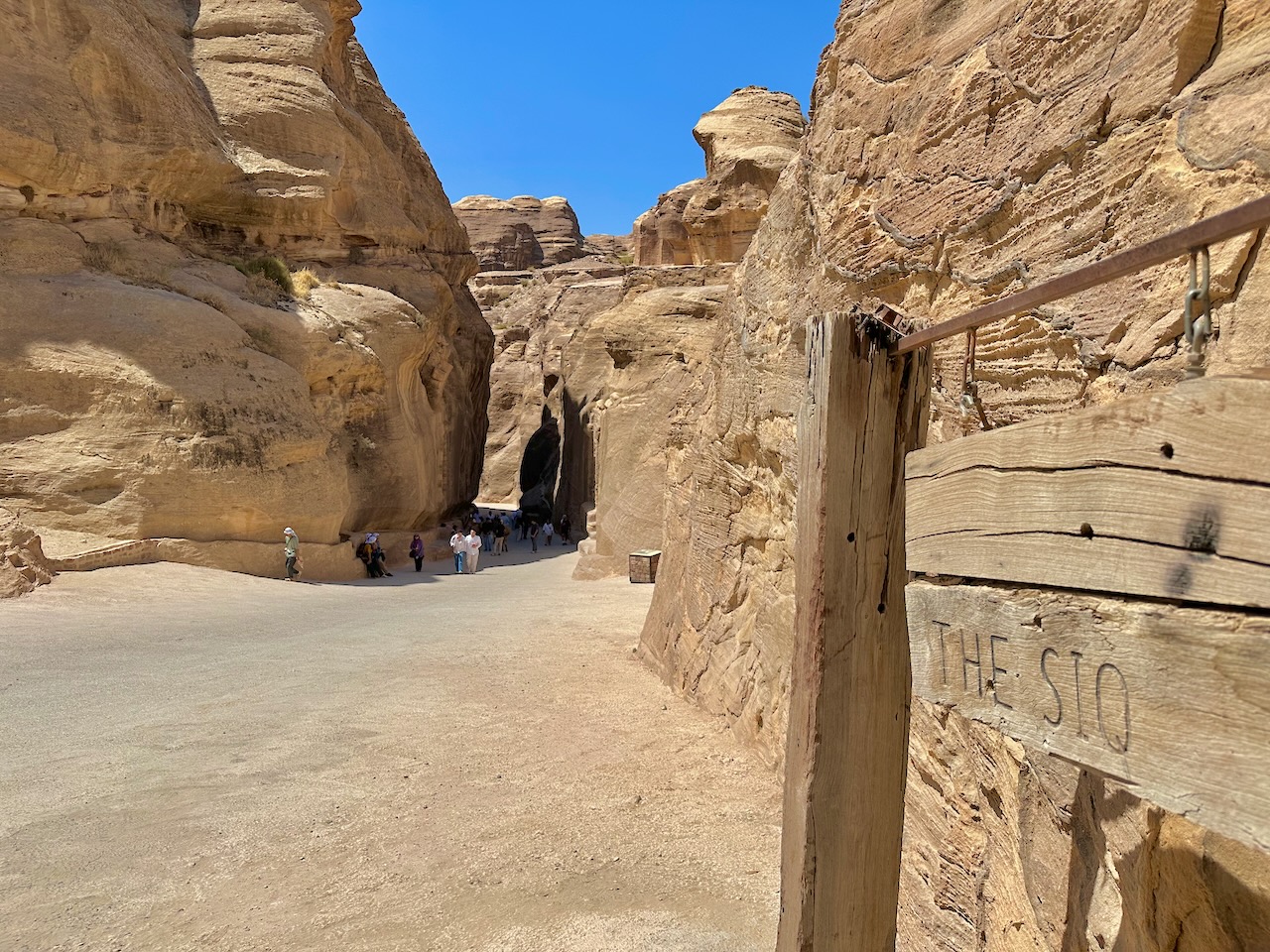
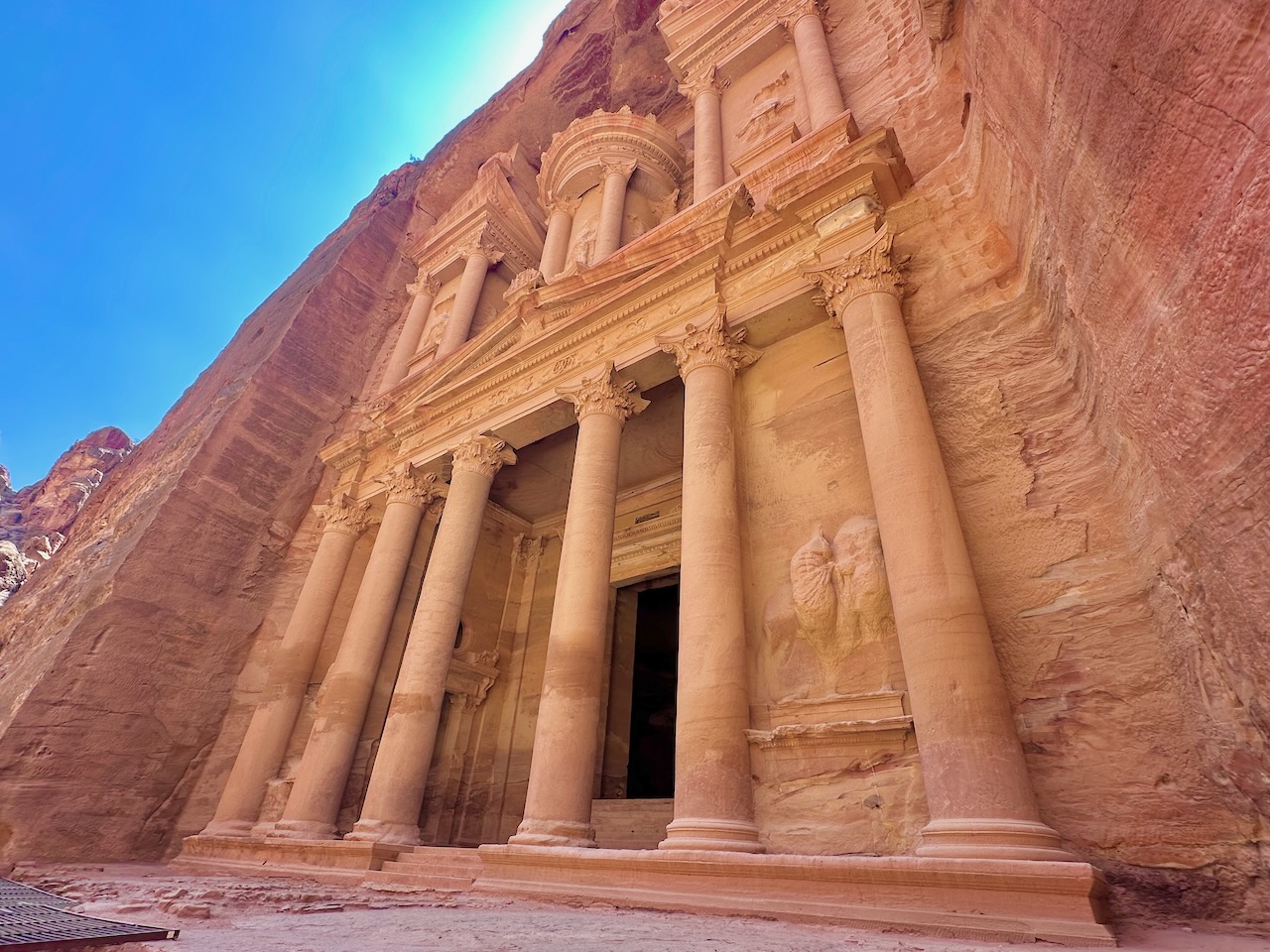
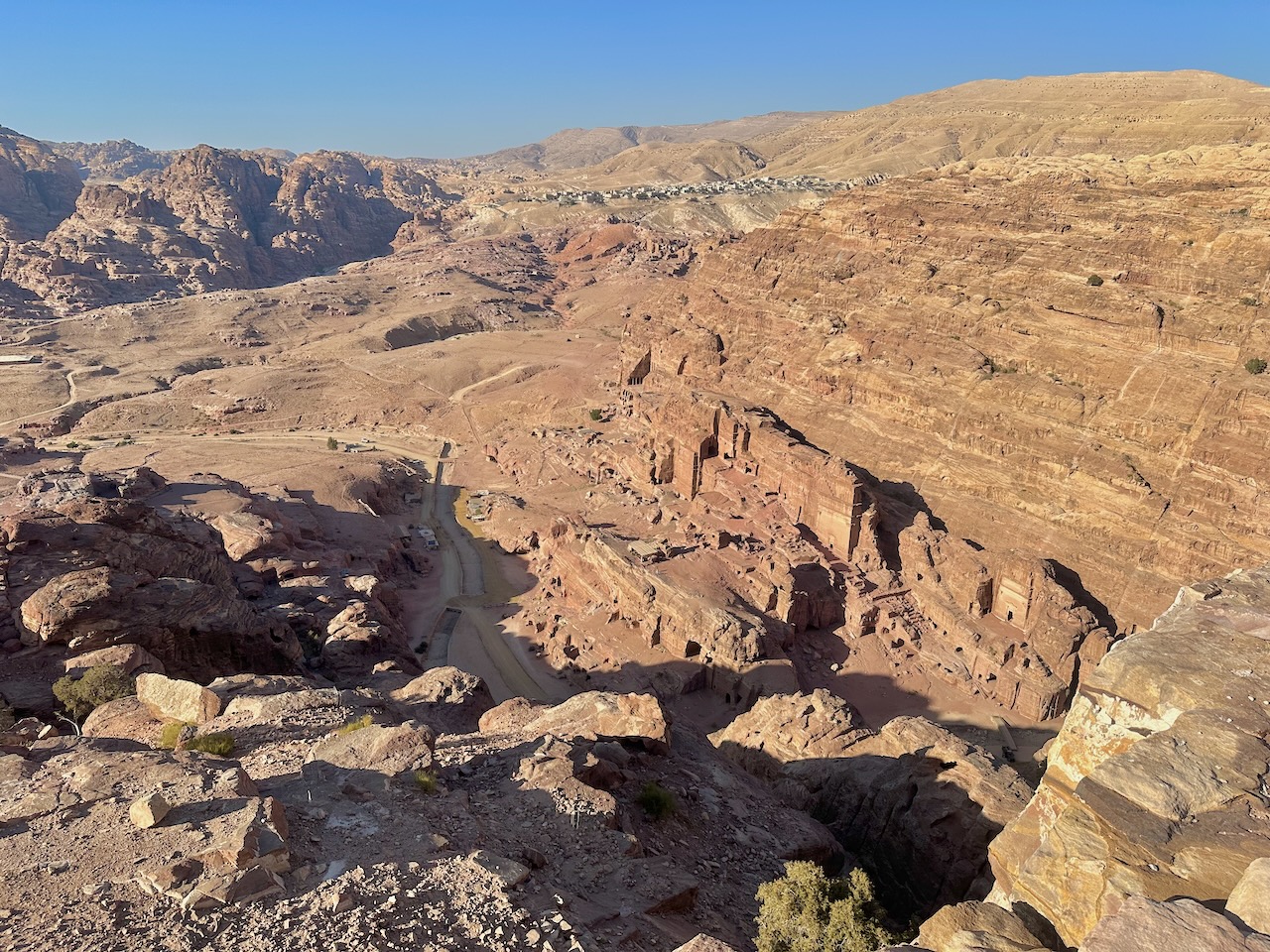
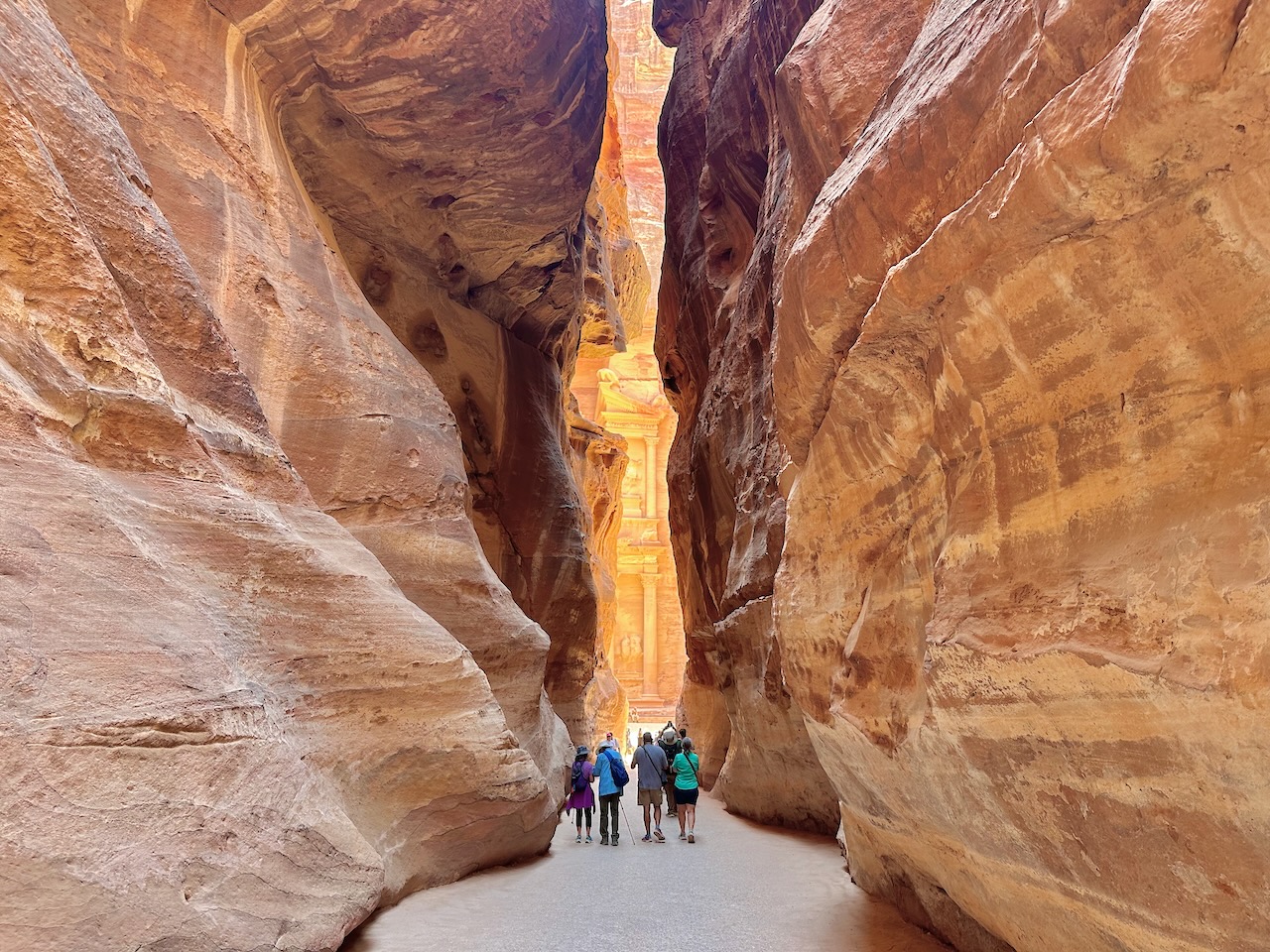
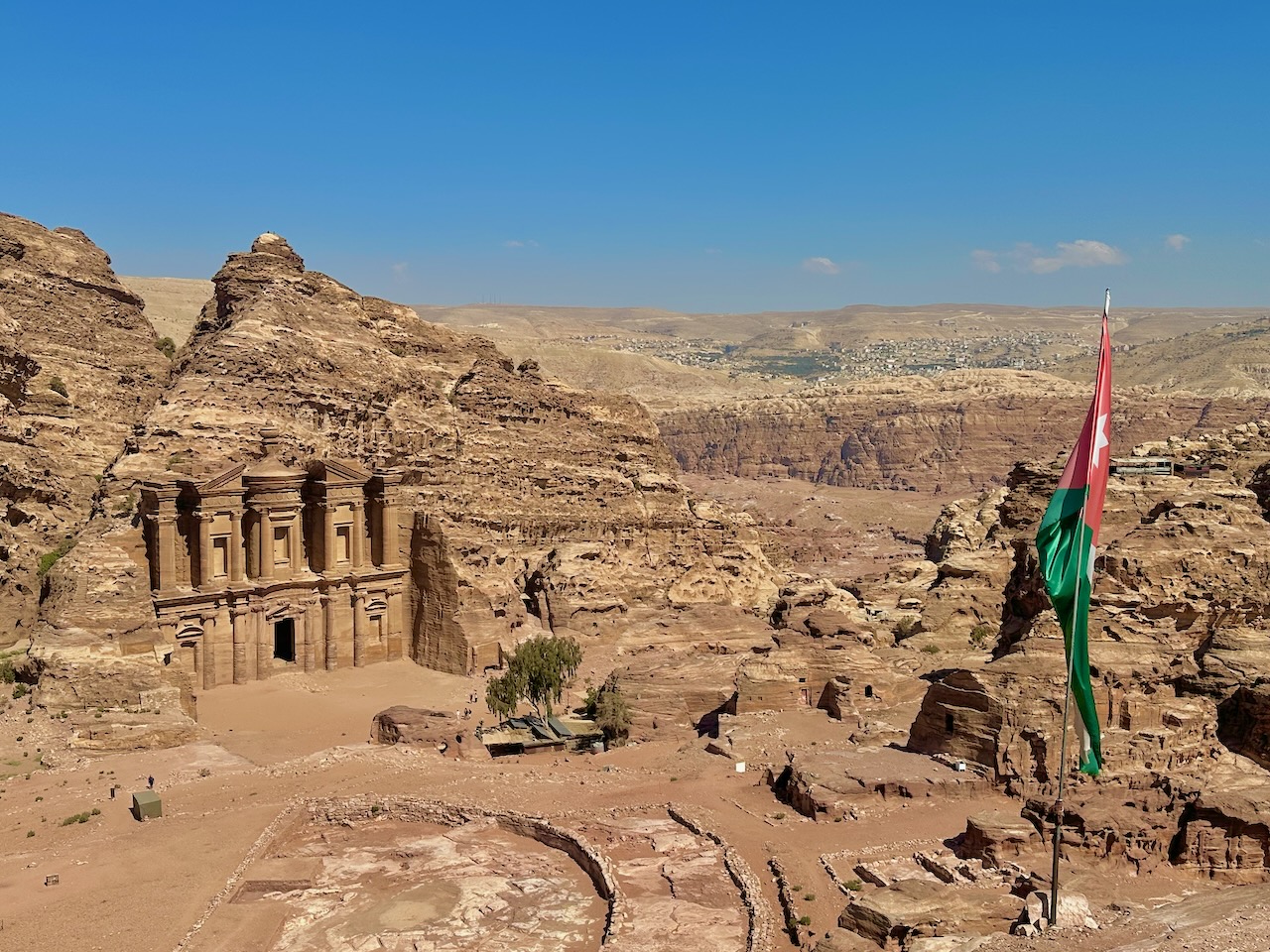

Day 8 – Wednesday, September 10: Return into Israel, Red Sea (Coral Beach), Timnah, Dead Sea
Today was “cross-over” day as we came back into Israel from Jordan. Following a great breakfast, we packed/loaded the bus and left at 7 a.m. We stopped for one last view from high above Petra before we drove south to the Aqaba/Rabin border crossing. The weather was sunny and a bit warmer once again (95?), but a “dry heat” as we say. We read from Obadiah 1 (about the Edomites) as we departed the hotel.
Rabin Border Crossing
We arrived at the Jordanian sieve there border about 9:30. The procedure of crossing into Israel only took about an hour. On the Israel side of the border (called the Rabin Border, named after the former Prime Minister assassinated in 1995), they were a bit more thorough in the process. Shlomo and David greeted us with warm smiles once we crossed.
Elat/Coral Beach/Red Sea
After loading up David’s bus, we drove a bit more south to Elat, Israel’s southern-most city. Here we enjoyed a visit to Coral Beach and the Red Sea (Sea of Reeds, Yam Suph in Hebrew). Some in the group enjoyed swimming among the stunning aqua-colored water, bright fish and coral reefs. It was a beautiful place that we enjoyed for about an hour.
Timnah & Yovata
We now drove about 18 miles north to Timnah. This site was once an Egyptian copper mine in the 13-12th centuries BC. However, displayed here is a full-scale replica of the Tabernacle. The size of this Mishkan (Tabernacle) was 150 feet by 75 feet. We saw the Altar and Laver in the court yard. In the Holy Chamber we saw the Menorah, Table of Presence, and Incense Altar. In the Holy of Holies was the Ark of the Covenant. It was a great tour led by a Messianic believer from Elat who made Christocentric connections throughout the tour. As we left the model, we read from Hebrew 9 about how Jesus fulfilled everything the Tabernacle represented
About 15 minutes north of TImnah it a dairy-kibbutz called Yovata. Shlomo’s sister lives here. We stopped for the wonderful ice cream here. We had many different flavors from which to chose!
Ein Bokek
We arrived at our hotel (the David) in Ein Bokek about 5 p.m. Following check-in, we all changed into our bathing suits and walked down to the Dead Sea. This unique body of water is about 33% salt and mineral, allowing us to float effortlessly. It was a wild experience!
Following our “floating,” we enjoyed dinner at the hotel on our own time. We are looking forward to our “day in the desert” tomorrow before ascending to Jerusalem for the rest of the trip!


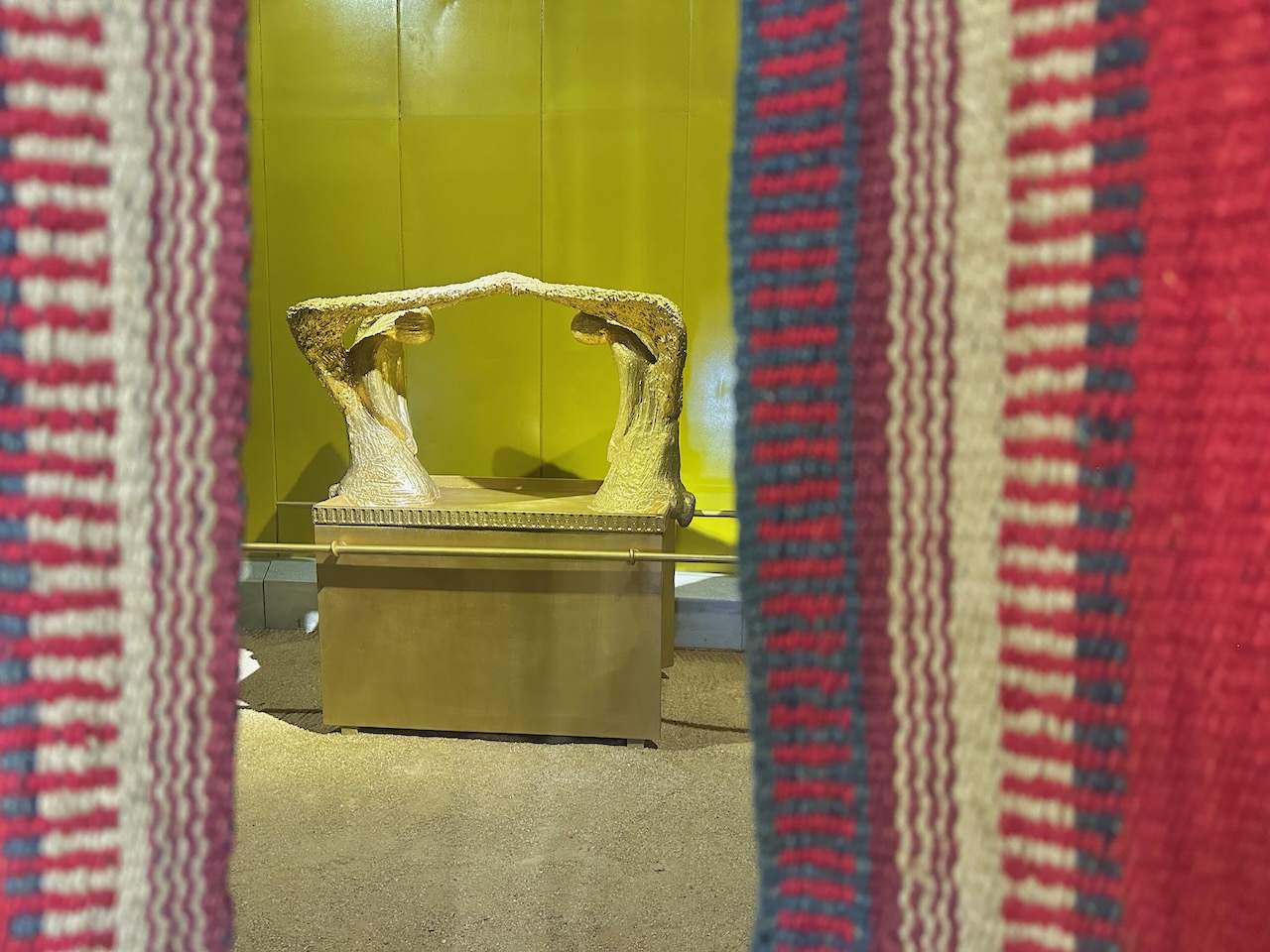
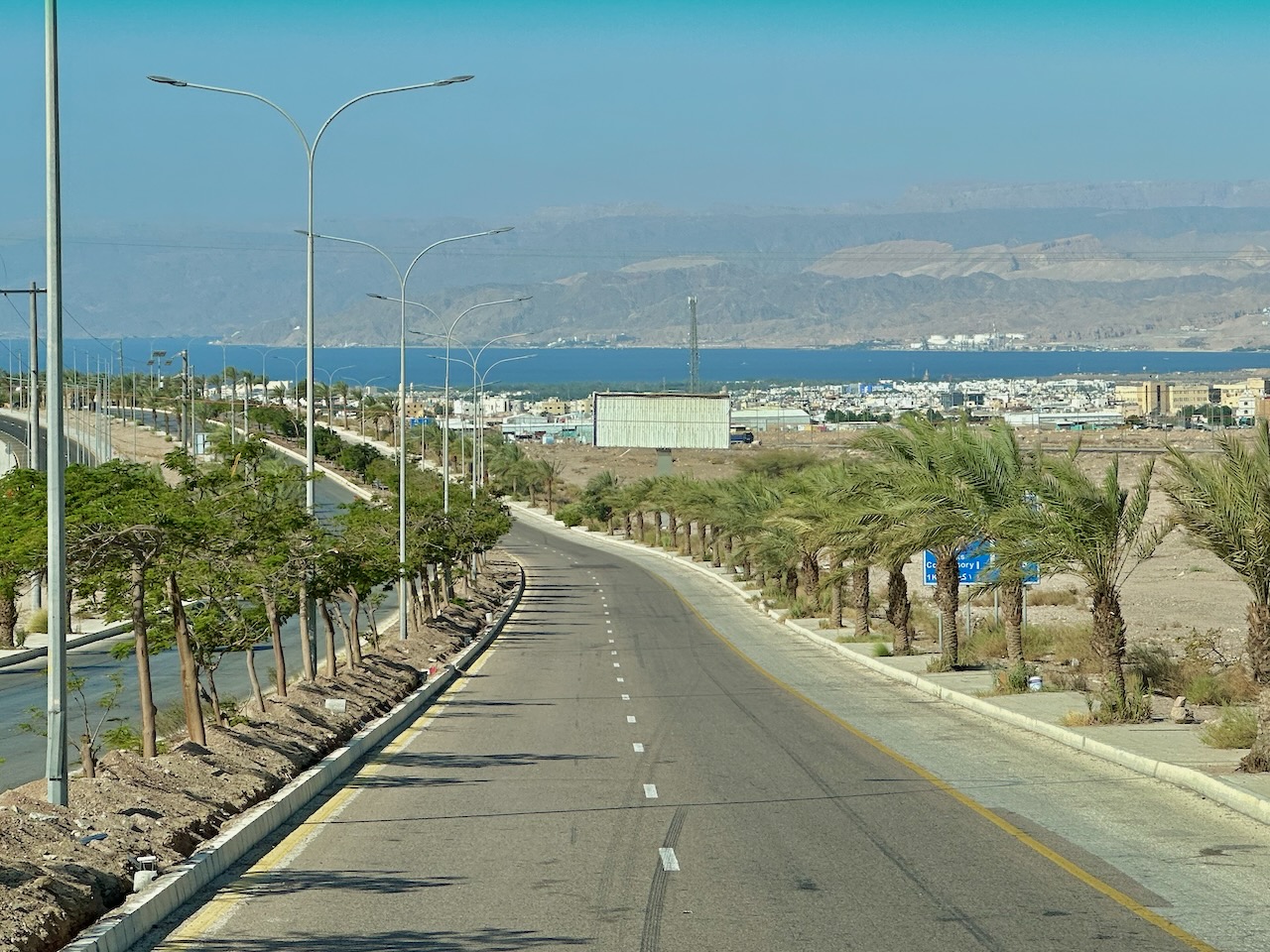


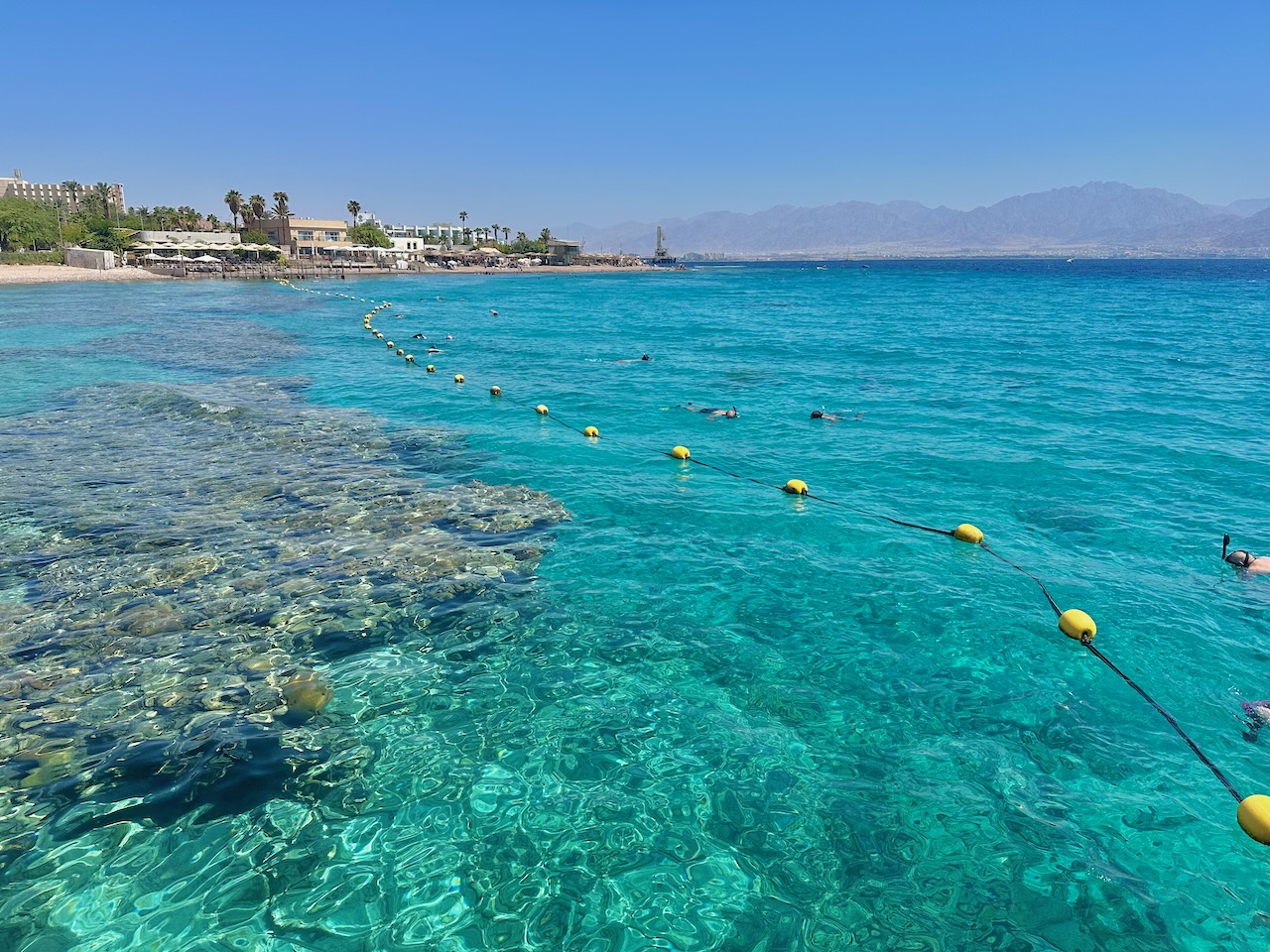


Day 9 – Thursday, September 11: Masada, Ein Gedi, Qumran, Jericho, Wilderness of Judah, Jerusalem, Western Wall
Today was “desert day.” We spent all day in the Judean Desert before ending the day in Jerusalem! The weather was sunny and warmer (predictable here this time of year), with highs in the 90s. We read from Psalm 18 as we left the hotel about 7:40 am.
Masada
Our first site of the day was Masada (metzada, in Hebrew). It was only a 15 minute drive north along the western shoreline of the Dead Sea from our hotel. Masada was built in the early 30s BC as a palace-fortress by Herod the Great. We took the cable car to the top and began seeing the ruins from the 1st century. We saw huge cisterns, the western and northern palaces, the Roman Ramp, the synagogue, and the bathhouse. In 70 AD, this was the location where 967 Jews found refuge from the Romans following the destruction of the Temple. The holdout lasted about three years until all by five of these Jews (a few women and children) took their own lives. It is a story of bravery and courage! Because of the heat, there Snake Path was closed. By the way, we had the entire site to ourselves!
Ein Gedi
From here we drove about 20 minutes north of Masada to get to Ein Gedi, one of only a few oasis here in the edge of the Judean Desert. We read from Song of Songs 1, 2 Chronicles 20 (the “Ascent of Ziz”) and 1 Samuel 24 (David hid from Saul here). Most in the group hiked back to the water falls at the end of the canyon. Some even enjoyed getting wet under the water falls! What an incredibly beautiful place! It was amazing to see so much water here in the desert!
Qumran
Continuing north, Qumran was the next site. This archaeological site is the most important one in Israel because of what was discovered here! When we arrived, we walked directly up to the cliff area of the desert to get a glimpse of Cave 6 (one of 12 caves in which fragments of ancient scrolls were discovered) and also to get a good view of the site itself. We also saw the beginning of the aqueduct system that brought rain/flood water into the site.
It was here at Qumran where the Dead Sea Scrolls were found! The discovery began in 1947, while the excavation took place through 1956. We walked through the limited ruins where a small community of Essenes lived (or retreated here from Jerusalem, as a new theory suggests). To date, about 930 scrolls and fragments of texts scrolls have been discovered. The scrolls/texts date primarily from the late 3rd century BC – 1st century AD. At the small archaeological site we saw cisterns, ritual baths (mikvot), and the scriptorium. In front of “Cave 4” (where the majority of texts were found), we read from “Psalm 151,” and Psalm 19. We celebrated the perseverance of God’s Word! We were invited to take joy in God’s Word.
Jericho
The the last site of the day was Jericho. Located north of the Dead Sea in the southern end of the Jordan Valley, Jericho (called Tel es-Sultan) was the first Canaanite city other than be taken. We first enjoyed a great lunch at the Temptation Restaurant (where we had muqlaba). Then we climbed to the top of this small tel (9 acres) and looked east across the Jordan to recall a few biblical connections (e.g. Moses, Mt. Nebo, Dt. 34; Joshua crossing the river, Joshua 3; Elijah & Elisha, 2 Kings 2); and Jesus’ baptism (Matthew 3). We then saw an old stone tower that predates even Abraham and a small portion of the city wall on the southern end. Mud-bricks and a burn level could also be seen in a few places. We recalled the Joshua 6 story how the city was defeated (and burned) by the Israelites. Praise God for the historicity of the Bible as it happened just as recorded and confirmed by archaeology!
Leaving the OT site of Jericho, we got a quick look at the NT (Herodian) Jericho. Herod the Great had a winter palace here. He also died here, with his body transported for burial to Herodium just east of Bethlehem.
Wadi Qelt & Jerusalem
On our way to Jerusalem, we made a brief stop overlooking another section of the Judean Desert called Wadi Qelt. Here we heard “Isaiah, the Prophet” share the words, “Prepare the way for the Lord” (from Isaiah 40). This was followed by Shlomo singing Psalm 23 for us in Hebrew. The desolate but beautiful desert was the backdrop for some of the lament psalms written by David.
We then drove the rest of the way to our hotel in Jerusalem. We read Psalm 122 was we made the final ascent. What an initial view of the Old City and Temple Mount as we came out of the tunnel of the Mt. of Olives. We checked into our hotel and enjoyed a great dinner. We also enjoyed an optional walk to the famous Western Wall. It was spectacular to see it at night! We are all looking forward to our last number of days here and around Jerusalem!
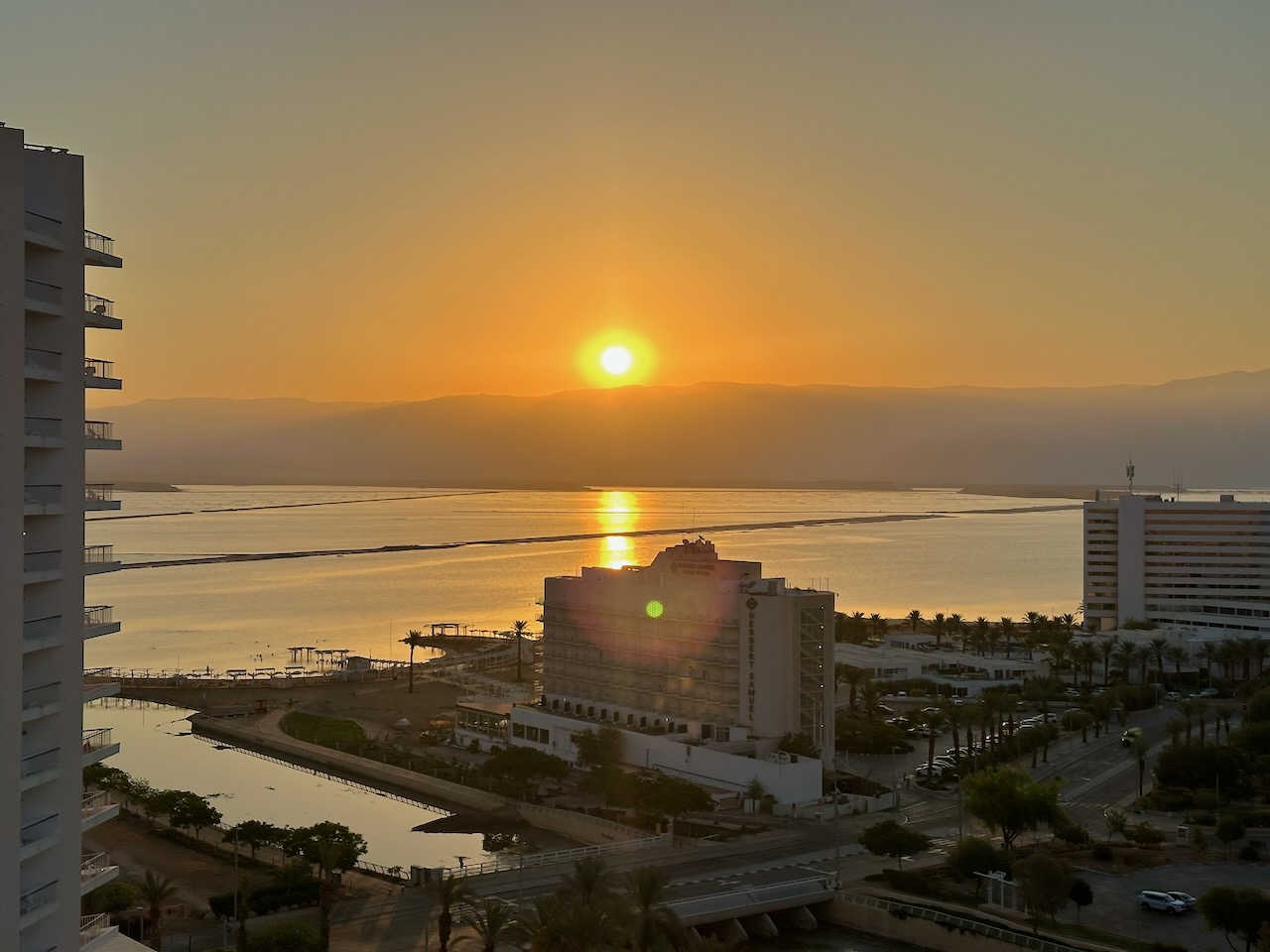

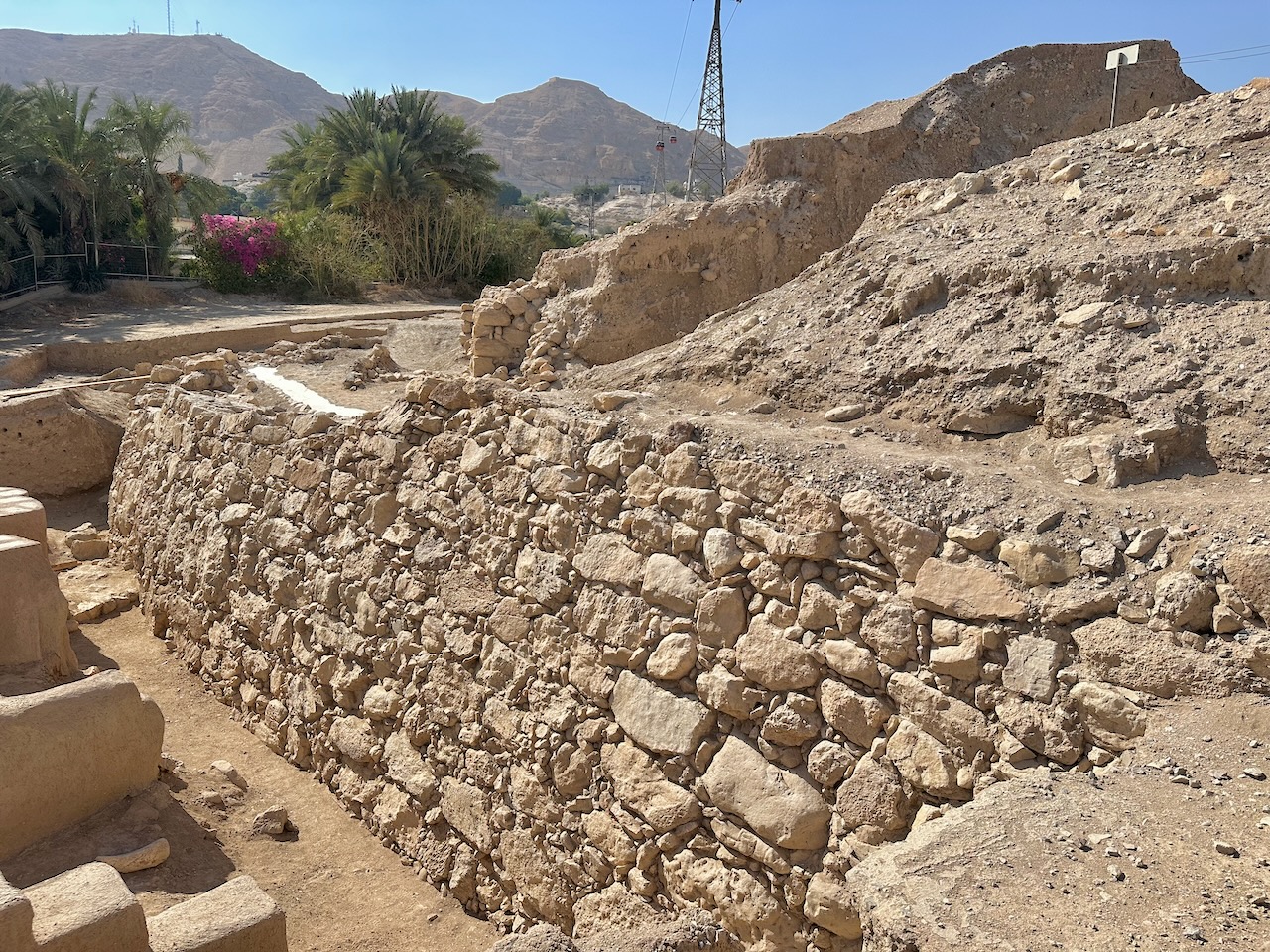
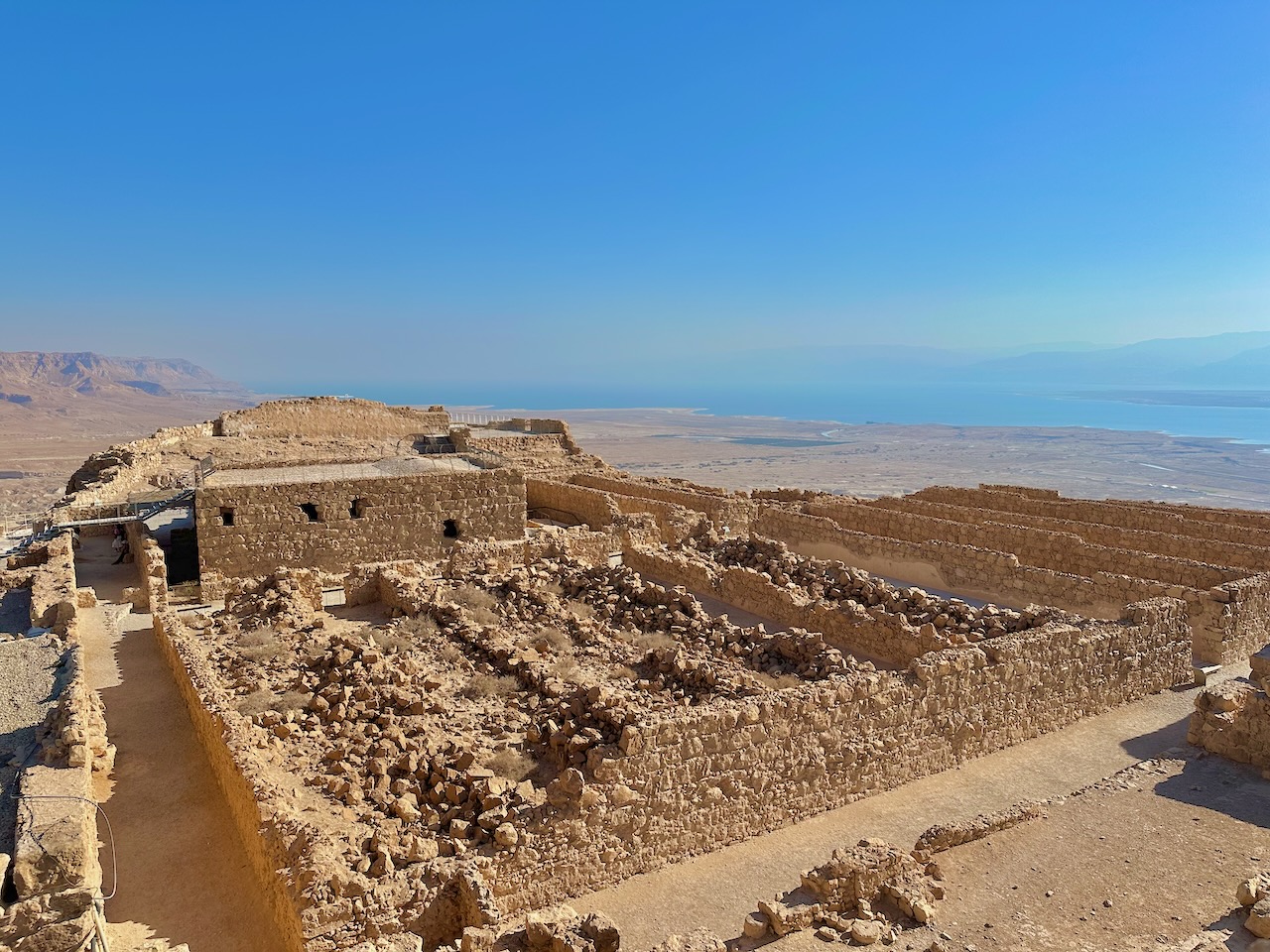
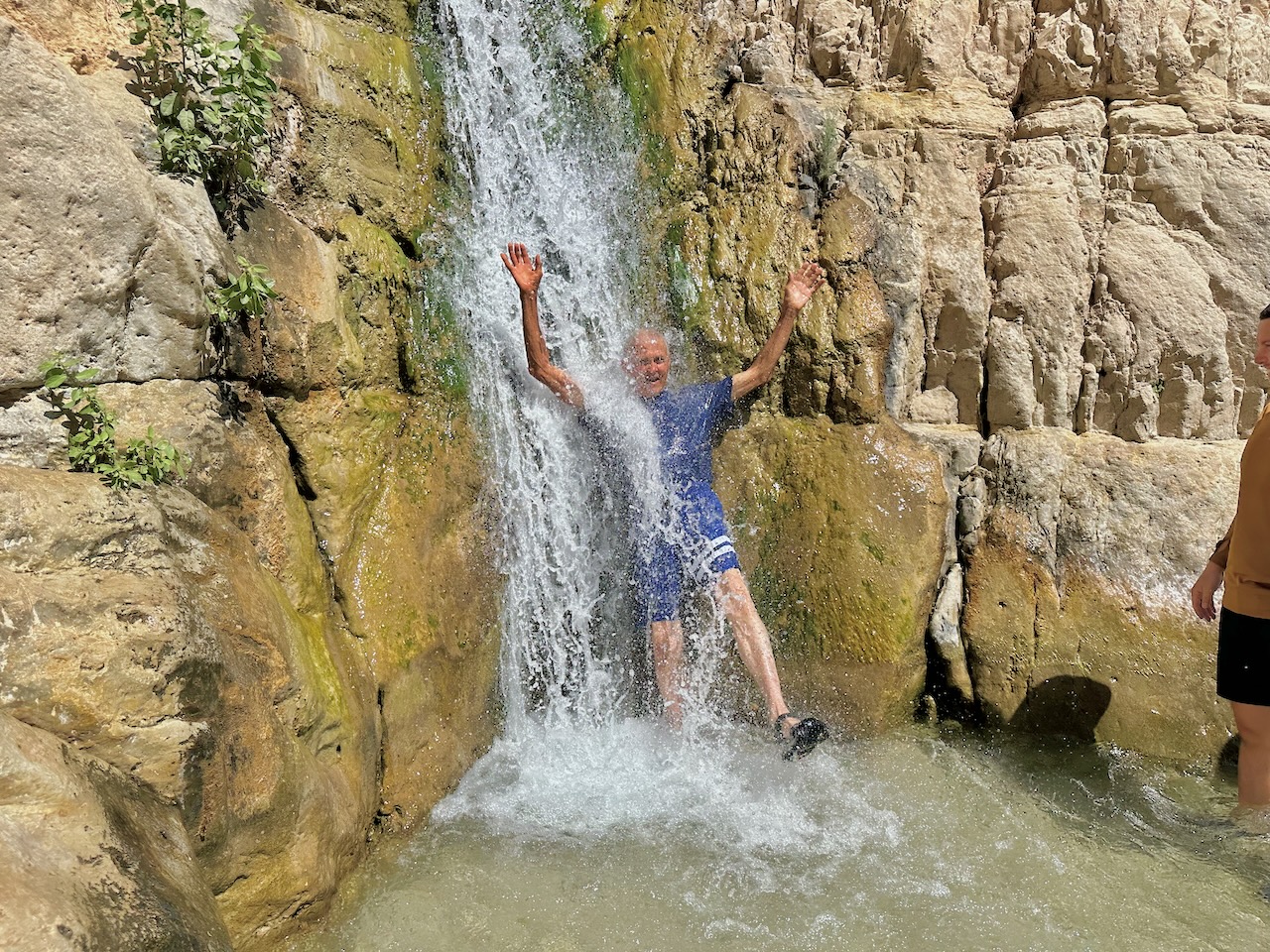
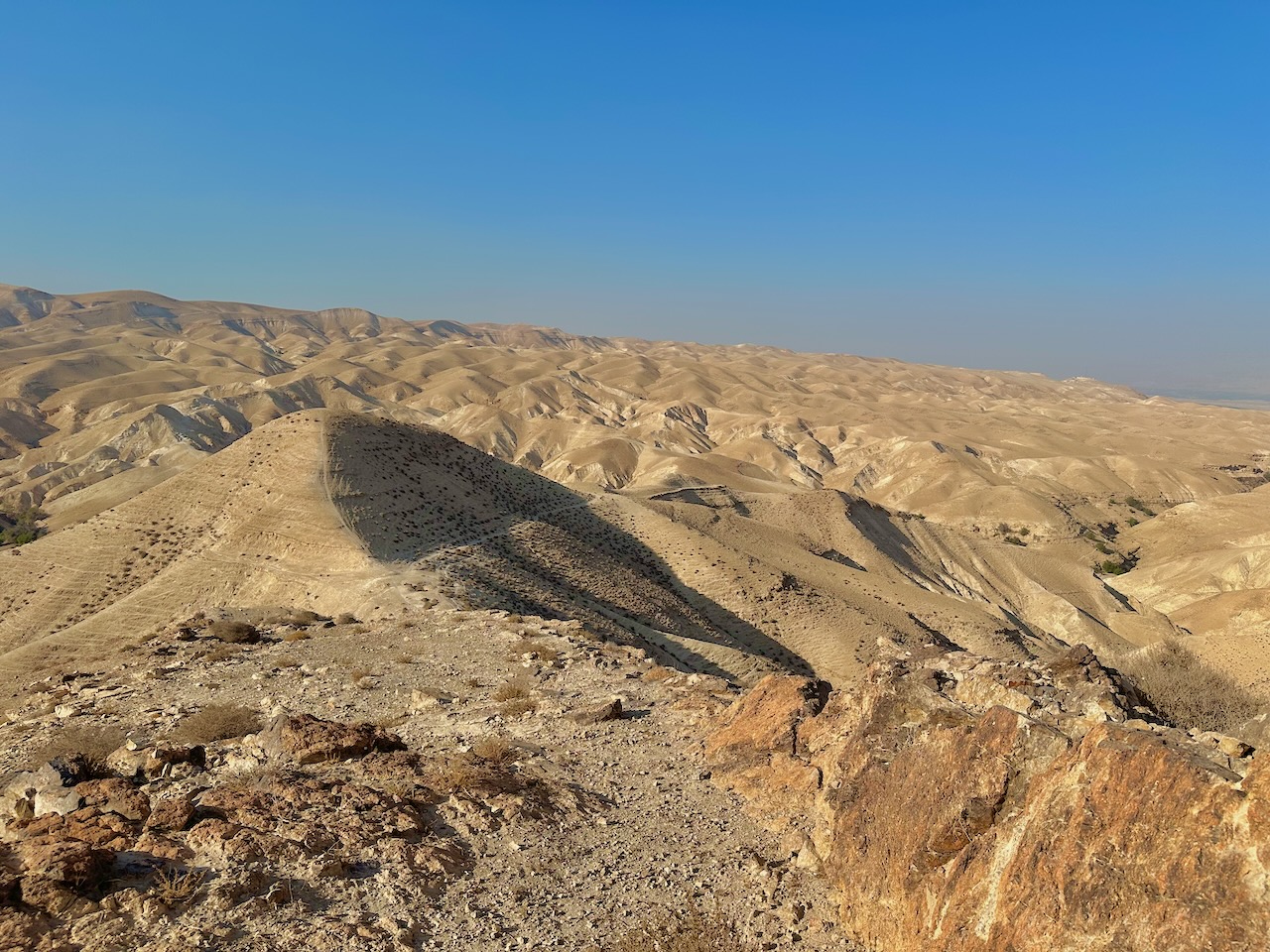


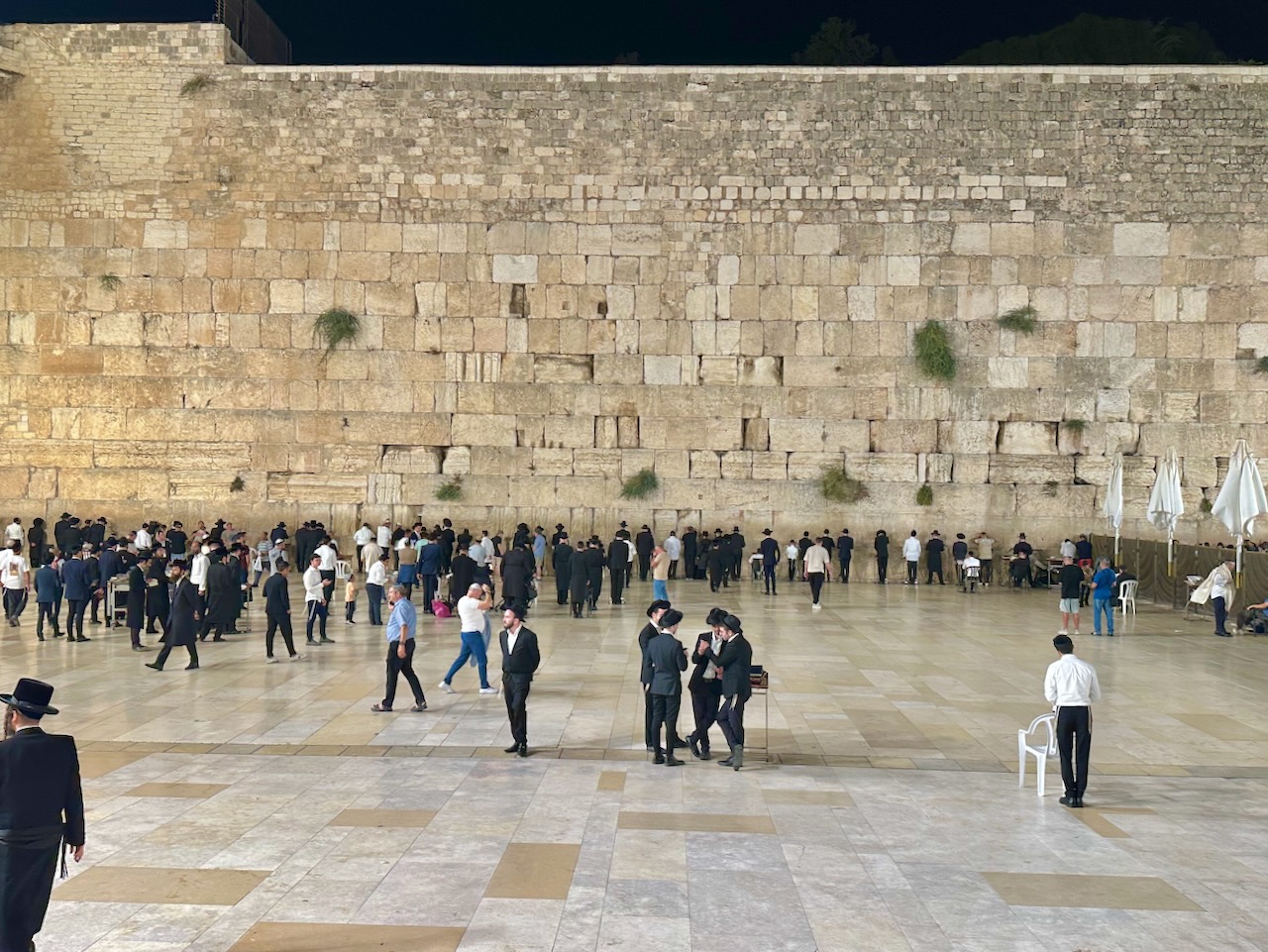
Day 10 – Friday, September 12: City of David, Hezekiah’s Tunnel, Siloam Pool, Southern Steps of Temple, Herodium, Bethlehem
Today was our first day here in Jerusalem. We enjoyed another sunny day, with a cooler day (highs in the low 80s). We visited the City of David first and ended the day in Bethlehem.
City of David/Hezekiah Tunnel
We started the day by driving to the City of David. After gathering on the observation tower and learning about the surrounding area, we walked down through the excavations (“Area G”). We saw David’s palace, city walls, and 7th-6th BC house structures (one of them was excavated/uncovered by Dr. John in June-July, 1982). We all continued through Warren’s Shaft (2 Samuel 5). The upper part of this discovery was probably used by David but not the vertical 52 foot shaft. Finally, we descended down to the Canaanite/Jebusite pool to the Gihon Spring. We then saw a newer movie about how Hezekiah’s Tunnel was chiseled out of stone before many in the group braved the waters of the 1,710 foot-long tunnel (2 Kings 19-20, 2 Chronicles 32). Others took the “dry” Jebusite tunnel built 100s of years earlier. Both groups met at the Pool of Siloam where we read John 9 in dramatic fashion. More of the pool (or reservoir pool) as been exposed, but without finding any more of the steps of the pool. It could be that the smaller pool outside the end of Hezekiah’s Tunnel may have been the ritual pool in the John 9 story (?). Time will tell.
Southern Steps
From the Pool of Siloam many in there group walked up the narrow Drainage Channel to the SW corner of the Temple (about 400 yards in distance) while others bussed up to the “Davidson Center.” Both groups converged under “Robinson’s Arch” where we walked on the Herodian pavement used no doubt by Jesus. The SW corner of the Temple may have been the pinnacle where Jesus was tempted (Mt. 4). We then walked over to the southern steps used by commoners. Jesus Himself (and His disciples, and Paul) would have used these steps to enter the Temple. We recalled the many mentioned in the NT who used these steps (Luke 2, 18; John 2; Mark 13; and Acts 2, etc…). Before leaving the steps, we considered how God wants us to be His spiritual temple (2 Corinthians 3).
Herodium
Shortly after noon, David picked us up outside the Dung Gate. We drove a south and then east to Herodium. This was a palace-fortress built by Herod the Great. He was also buried here in 4 BC. The site was incredible, with many renovations and new displays. Inside the well-preserved official’s chamber (i.e “Reception Room”) where we saw a wonderful presentation. We then walked up 170 steps through the royal arches to the top where we saw the bathhouse, synagogue, impressive frescoes, and a great view of of the surrounding area, including Jerusalem! The view of the Dead Sea (and Jordan beyond) was incredible! We left the site by carefully walking down through the cistern system.
Bethlehem
From Herodium we drove through Beit Sahour to Bethlehem. At Nissan Brothers we visited their olive wood factory and store. These olive wood products were impressive and so well crafted.
We drove back to Jerusalem. Back at the hotel, the very nice Shabbat dinner was incredible. A free evening followed, with some walking to check out the King David Hotel.
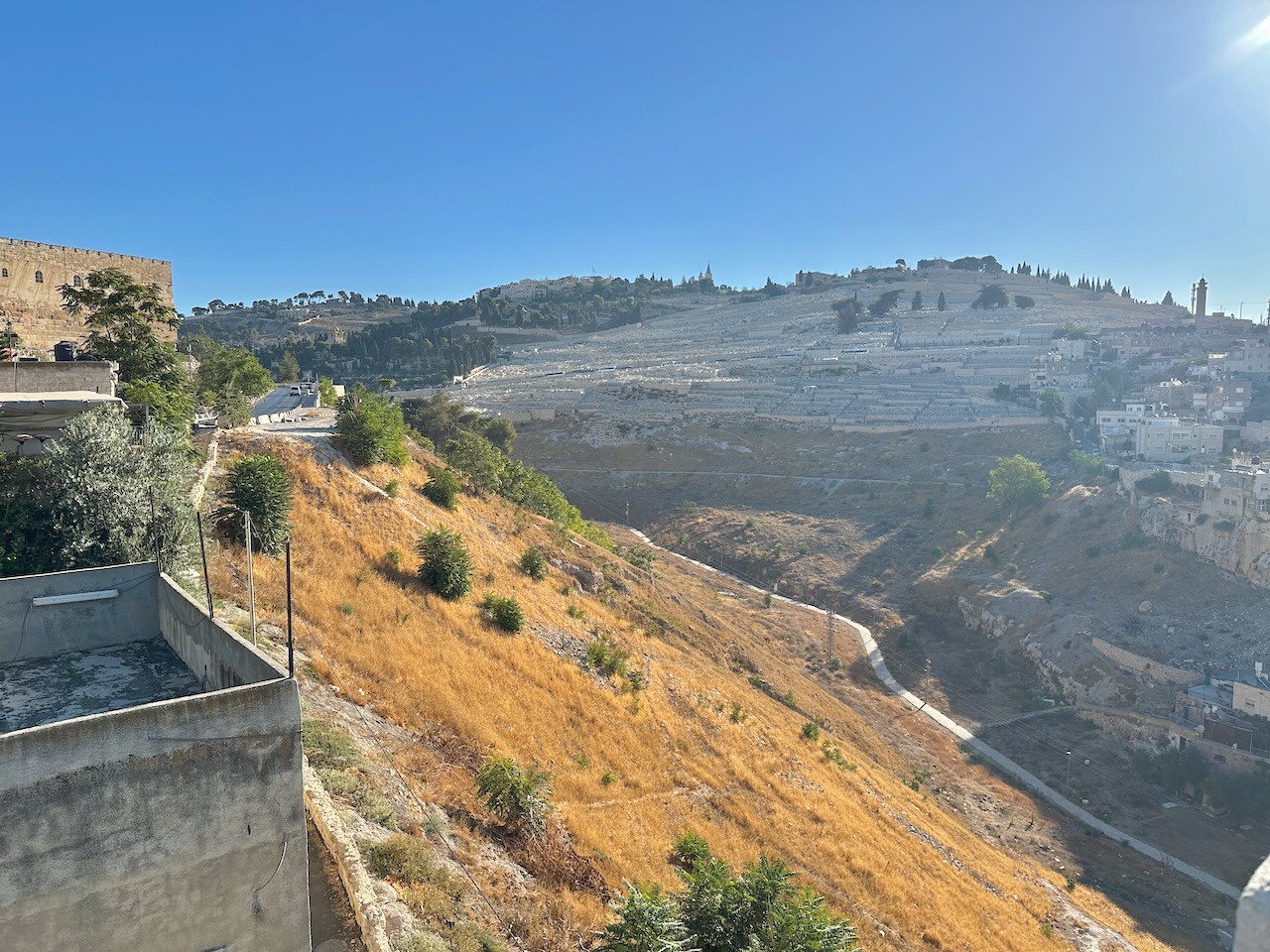
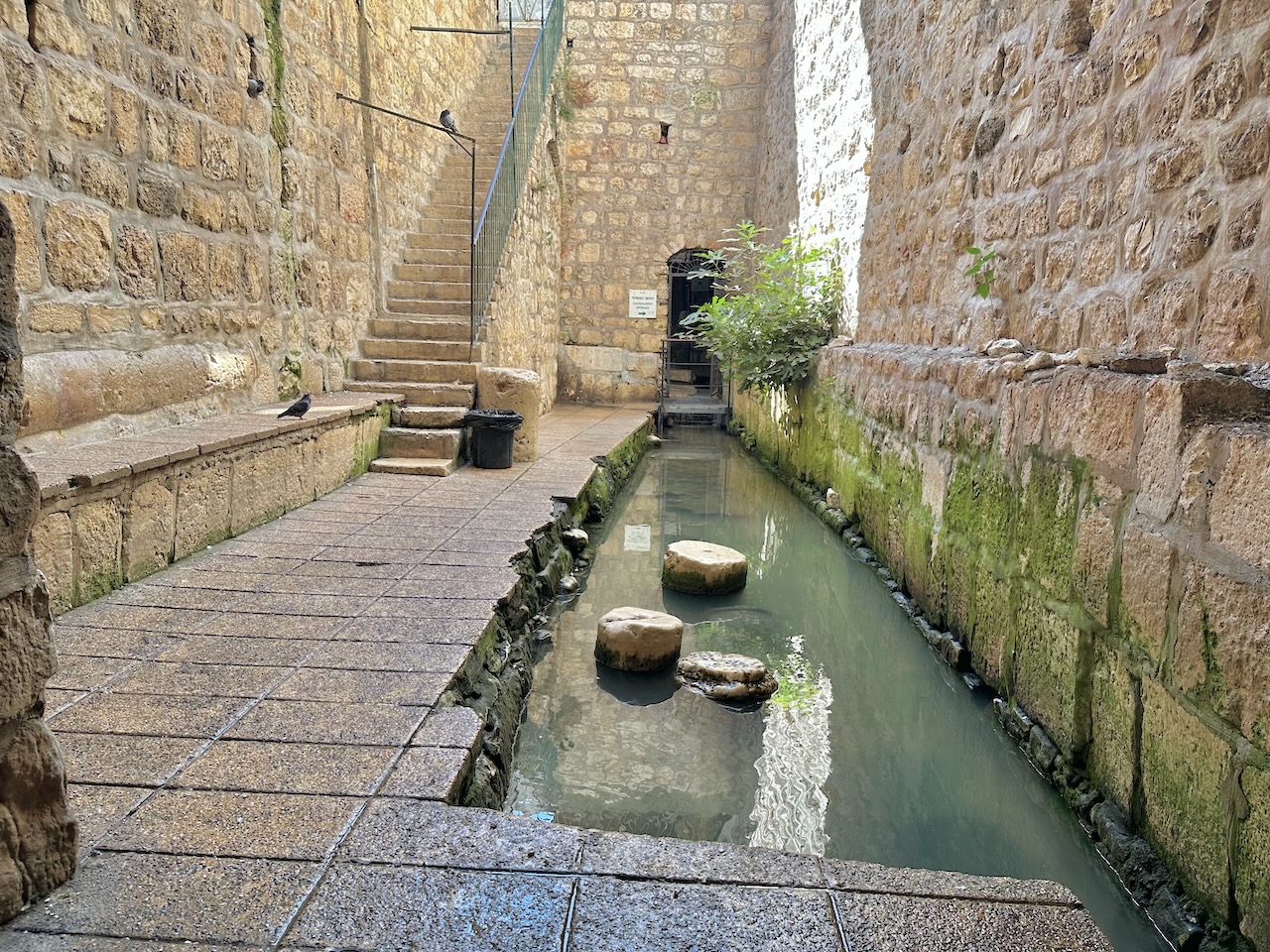
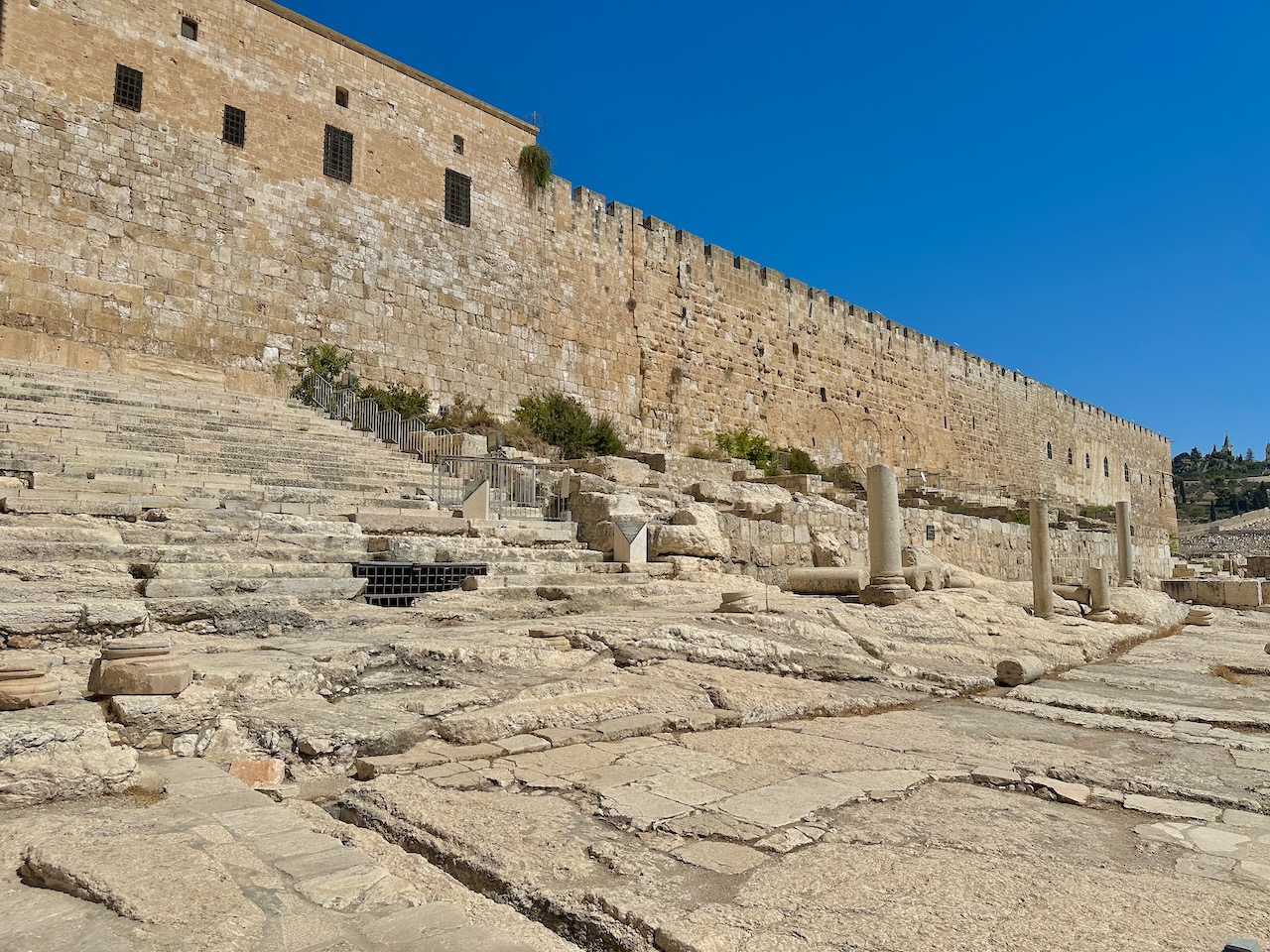

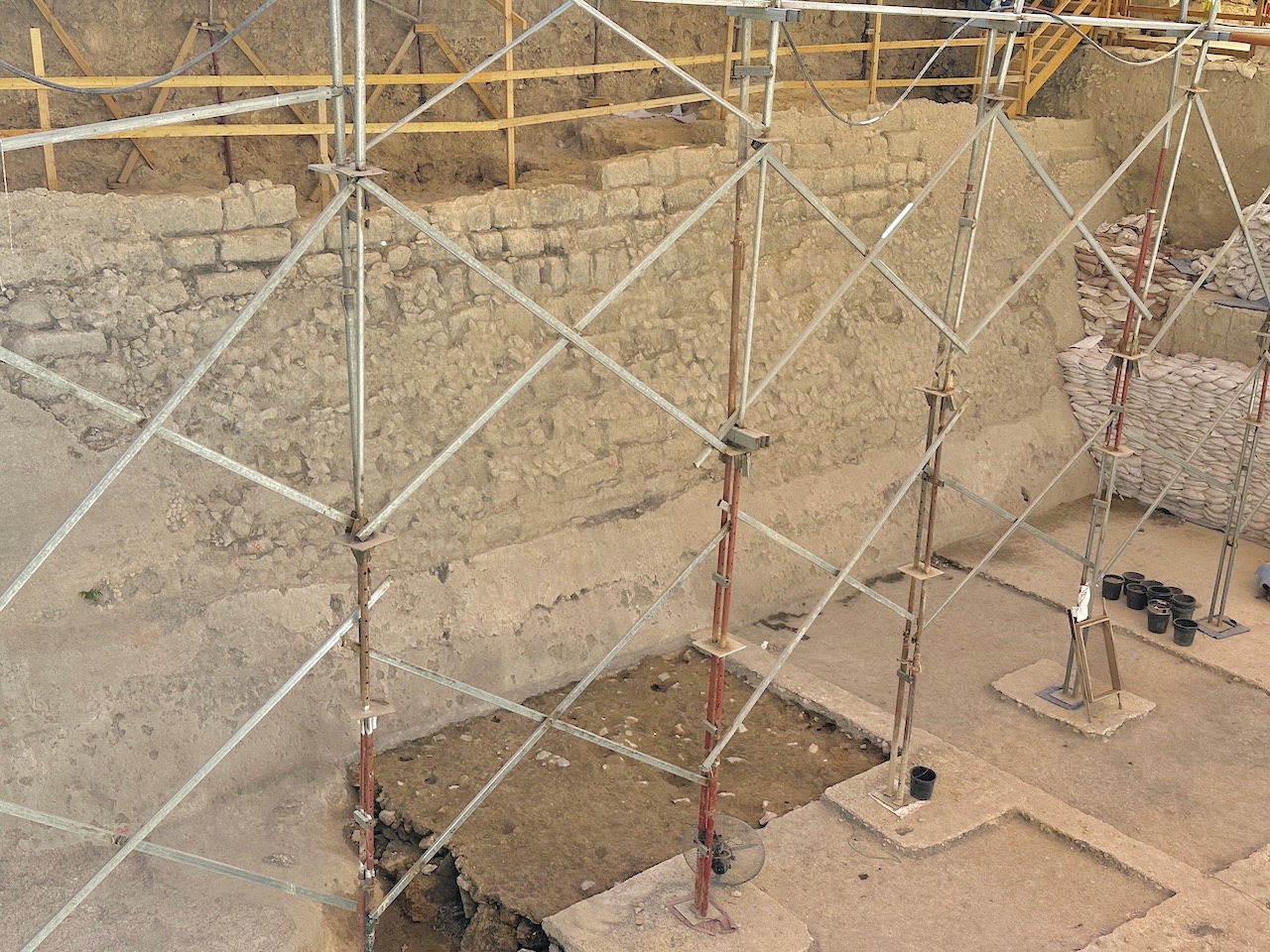
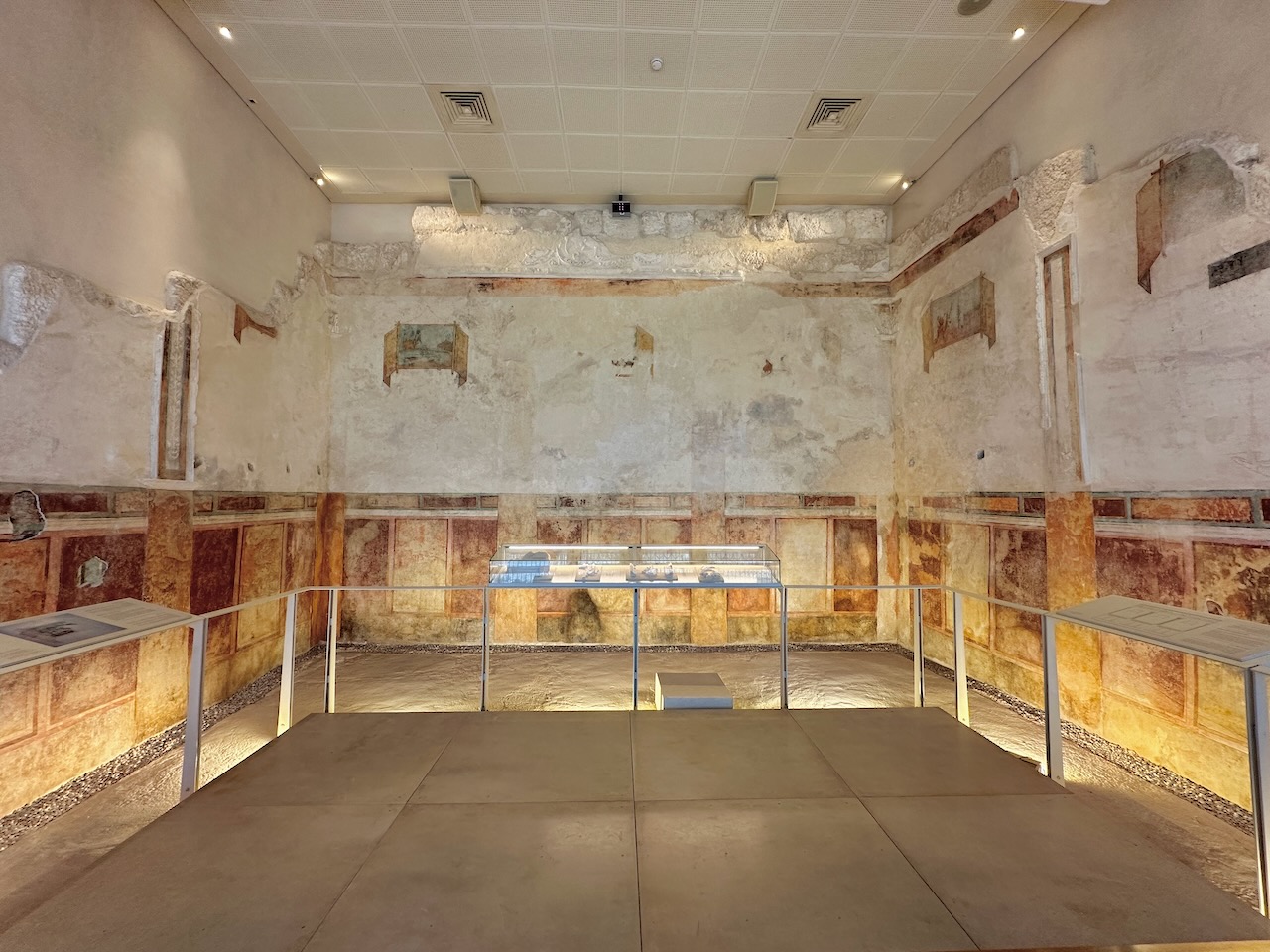
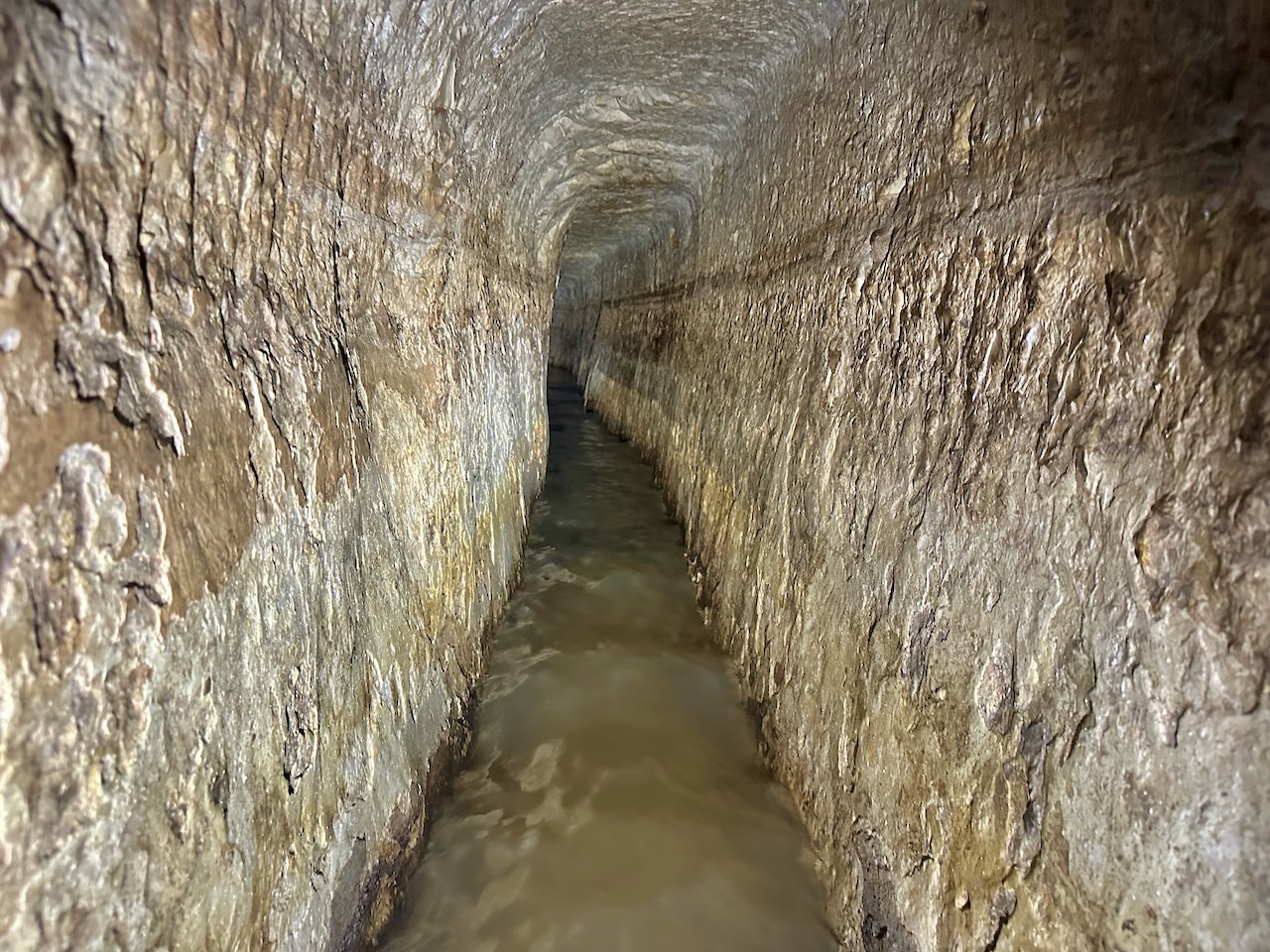
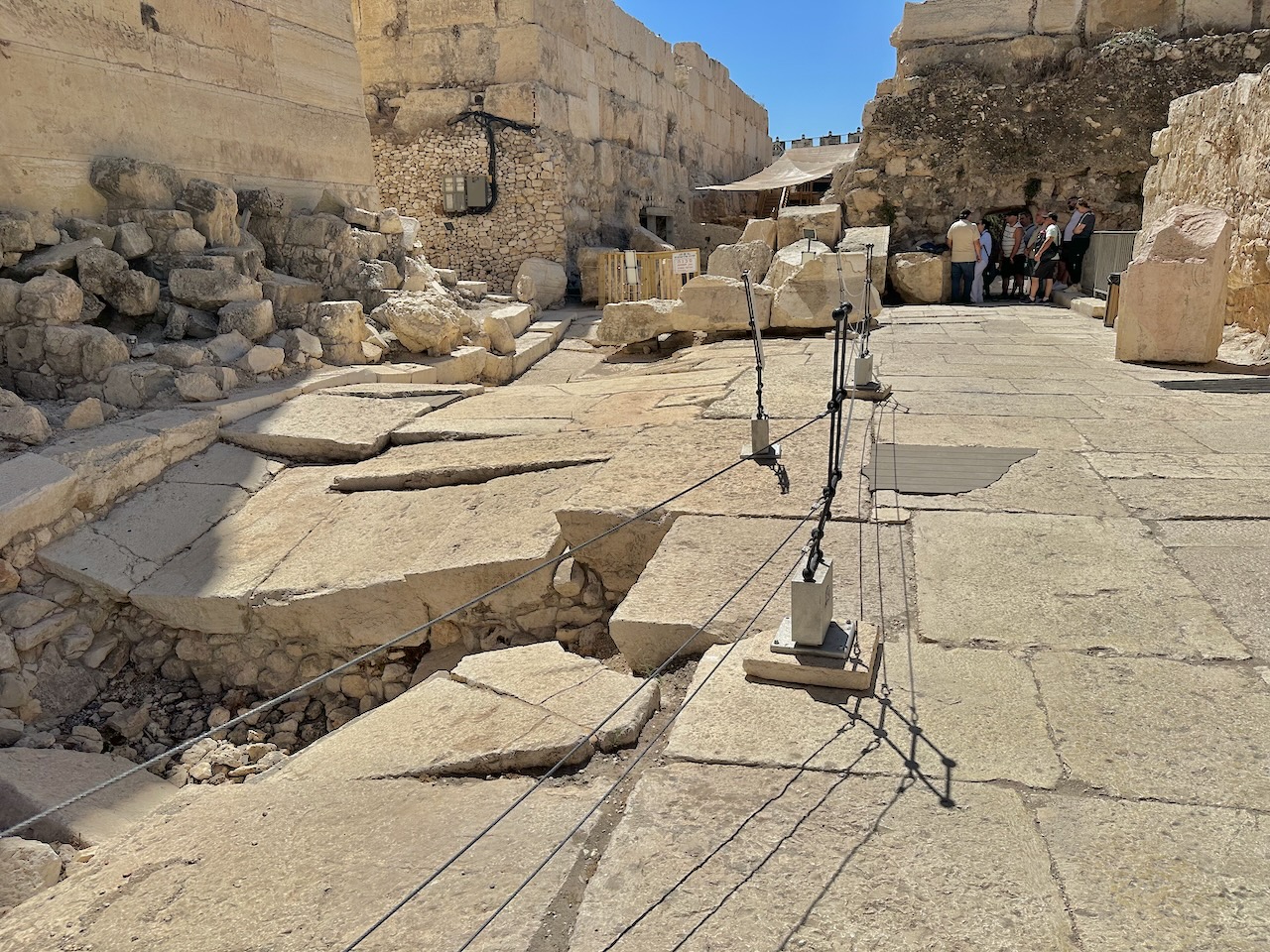
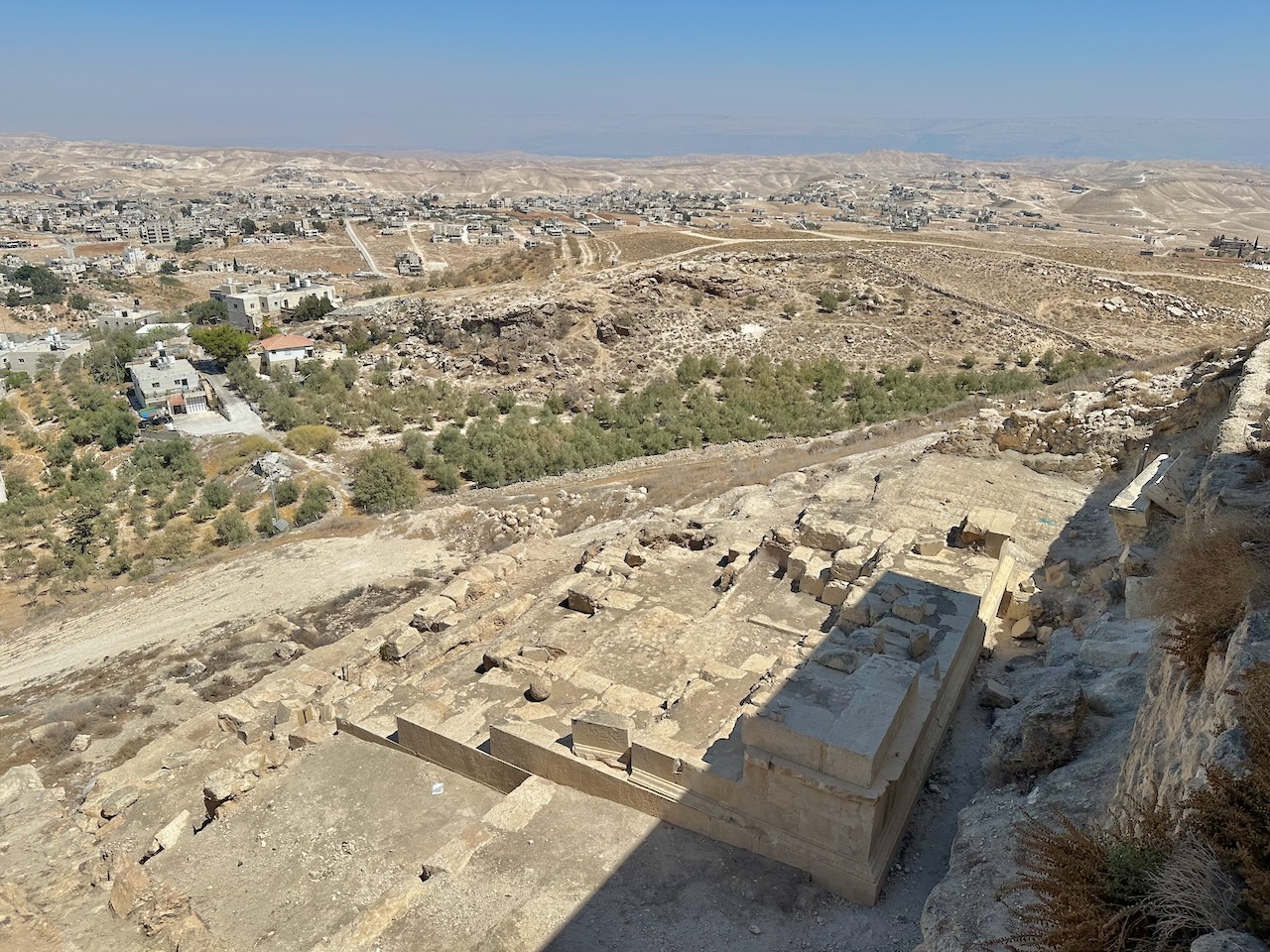
Day 11 – Saturday, September 13: Garden Tomb, Mt. of Olives, Israel Museum, Rampart Walk, Holy Sepulcher Church
Today was another great day here in Jerusalem. Starting at the Garden Tomb was a special way to begin the day. Once again, we had a variety of experiences today. The sun was bright, with temps again in the low 80s. Ideal! We left this morning at 8 a.m., reading portions of John 7 on the way.
Garden Tomb
The drive to the Garden Tomb was a short one. Located on the north side of the Old City, this is an alternative (“Protestant”) location for the crucifixion and burial site of Jesus. We saw the suggested rocky scarp (Golgotha) where Jesus was crucified, followed by the proposed tomb. A special time of worship and reflection. Pastor Daniel led us in Communion. We worship the Person, not the place. What a great place to consider the redemptive purpose of Jesus’ coming!
Mt. of Olives
Next, we drove east to the Mt. of Olives. Once we crested this mountain range, we enjoyed a spectacular panoramic of Jerusalem! We looked across the Kidron Valley to the Old City and Temple Mount. From here we walked down the slope to Dominus Flavet. Here, we read recalled the Palm Sunday story (Luke 19), the passion of Garden of Gethsemane (Luke 22), Christ’s ascension (Acts 1), and the return of Christ (Zechariah 14). Today’s Eastern Gate was also in full view (Ezekiel 44). Jesus probably walked in the original gate following the Palm Sunday event. Continuing down the steep slope we entered just the garden area of the Church of All Nations (the traditional Garden of Gethsemane) where we saw very old olive trees. David picked us up once we made our way down to the Kidron Valley.
Israel Museum
Just a short distance away (in west Jerusalem) is the Israel Museum. First, we saw 1:50 scale model of 2nd Temple Jerusalem. Next, we walked through the Shrine of the Book where some of the Dead Sea Scrolls are displayed. Finally, we walked to the archaeological wing of the museum to see some of the “highlight artifacts” related to the Bible. We saw such artifacts that connected us to the Bible! We saw a good example of the “horse and rider,” similar to the partial one Pastor John discovered in his dig before there trip. We also saw the silver amulet inscribed with the earliest name of “Yahweh, the Pilate Inscription, Herod’s coffin, and the famous 1900 year-old “pie plate.” “HA
Old City – Rampart Walk & Holy Sepulcher Church
We returned to the Old City in the afternoon. Sixteen of us walked around the “rampart walls” on top of the Turkish walls (1537-44 AD) of the Old City. We walked south first, and then east, overlooking the Armenian and Jewish Quarters. It gave us a unique perceptive.
From here we walked to intercept those who went with Shlomo. Near by is the Holy Sepulcher Church. Built in 325 AD, this is the traditional location for the death and burial place of Jesus. The archaeological and historical records favor this site. We saw the Edicule that has enclosed the suggested tomb of Christ for now nearly 1600 years. We waited only a short time before we entered into the suggested tomb of Jesus.
We walked out of Jaffa Gate together where we met David who drove us back to the hotel. Following dinner, some of us walked to Jaffa Road and Ben Yehuda Plaza to enjoy some “post-shabbat” window shopping and ice cream!
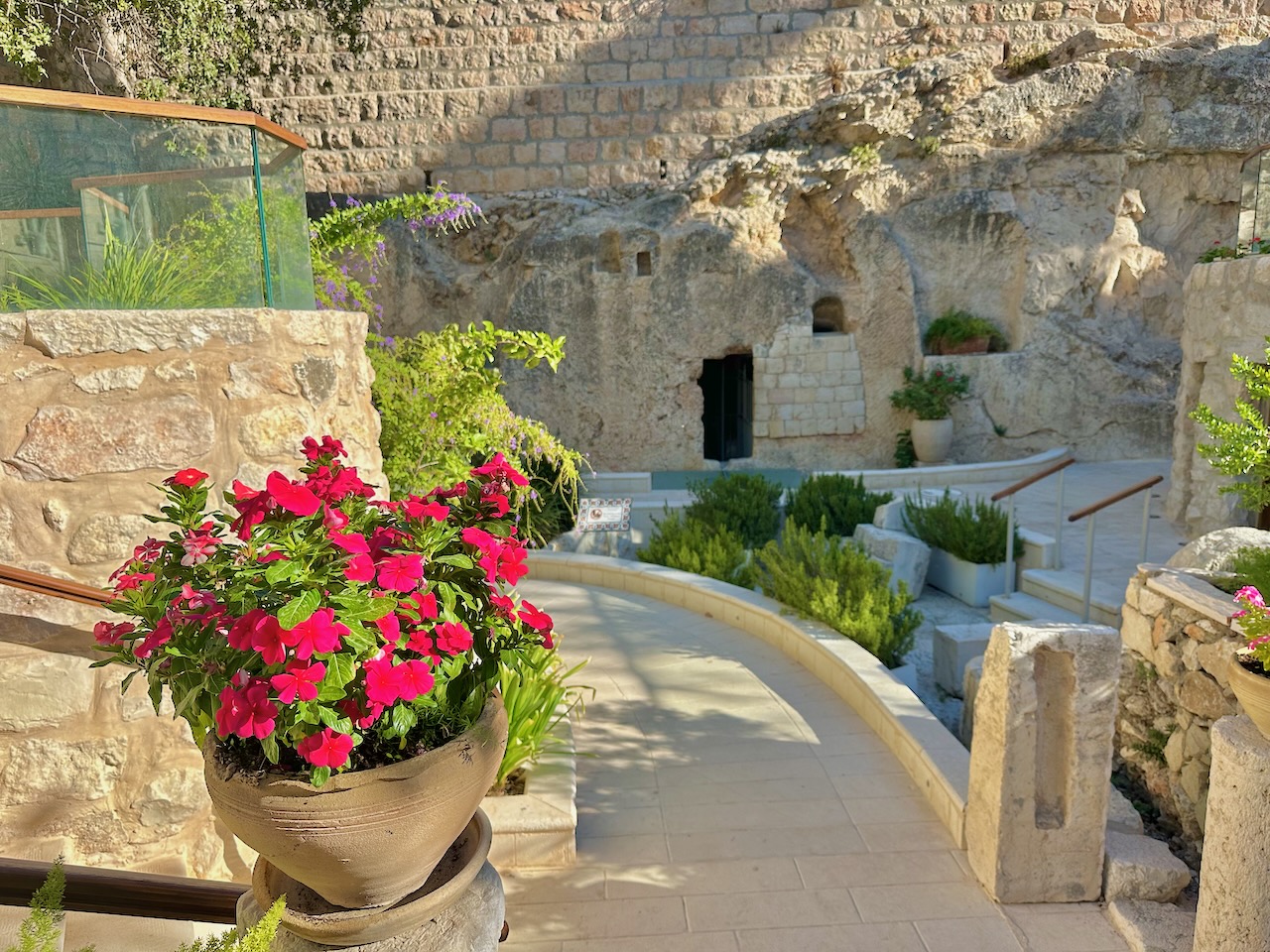



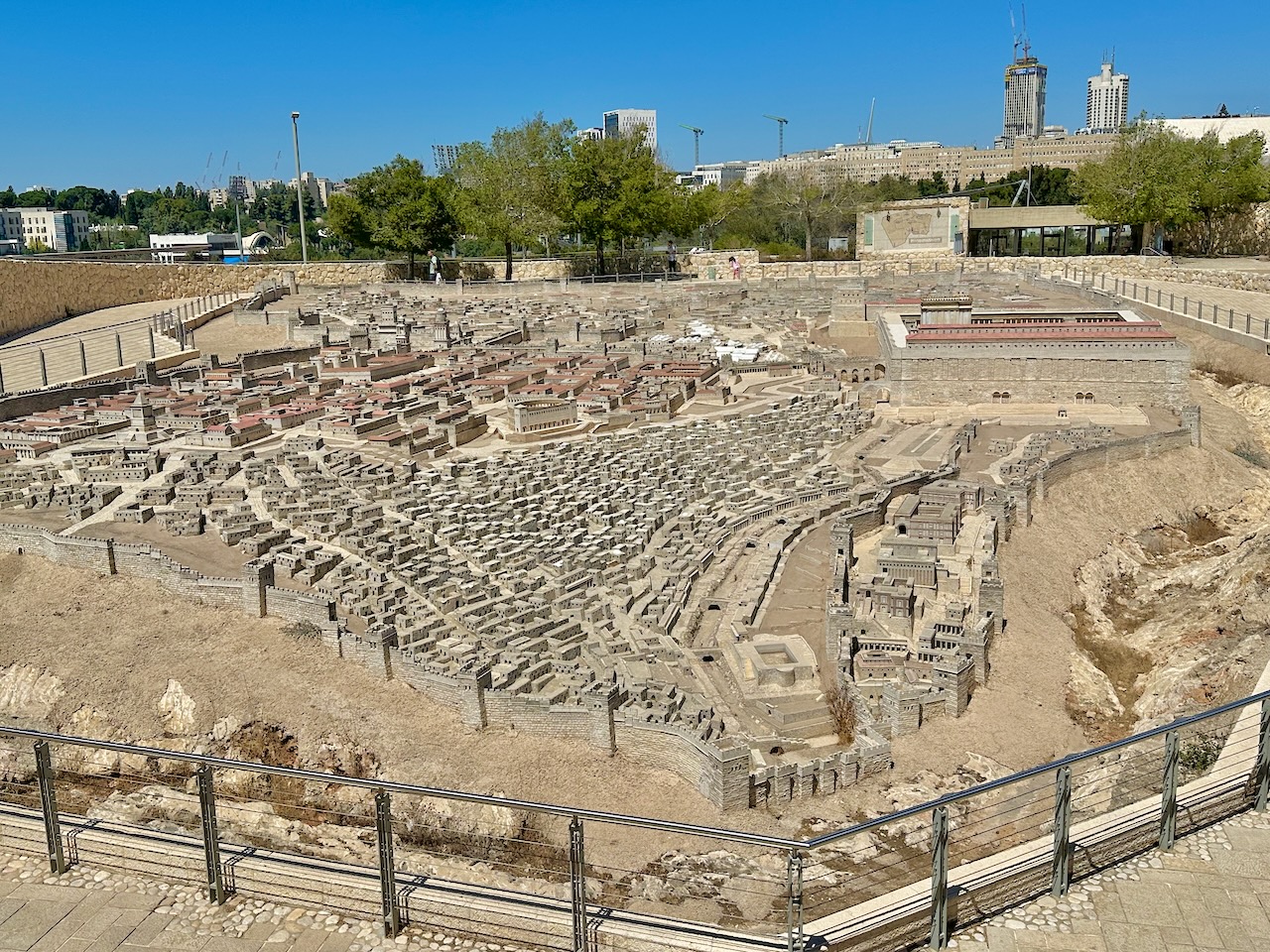
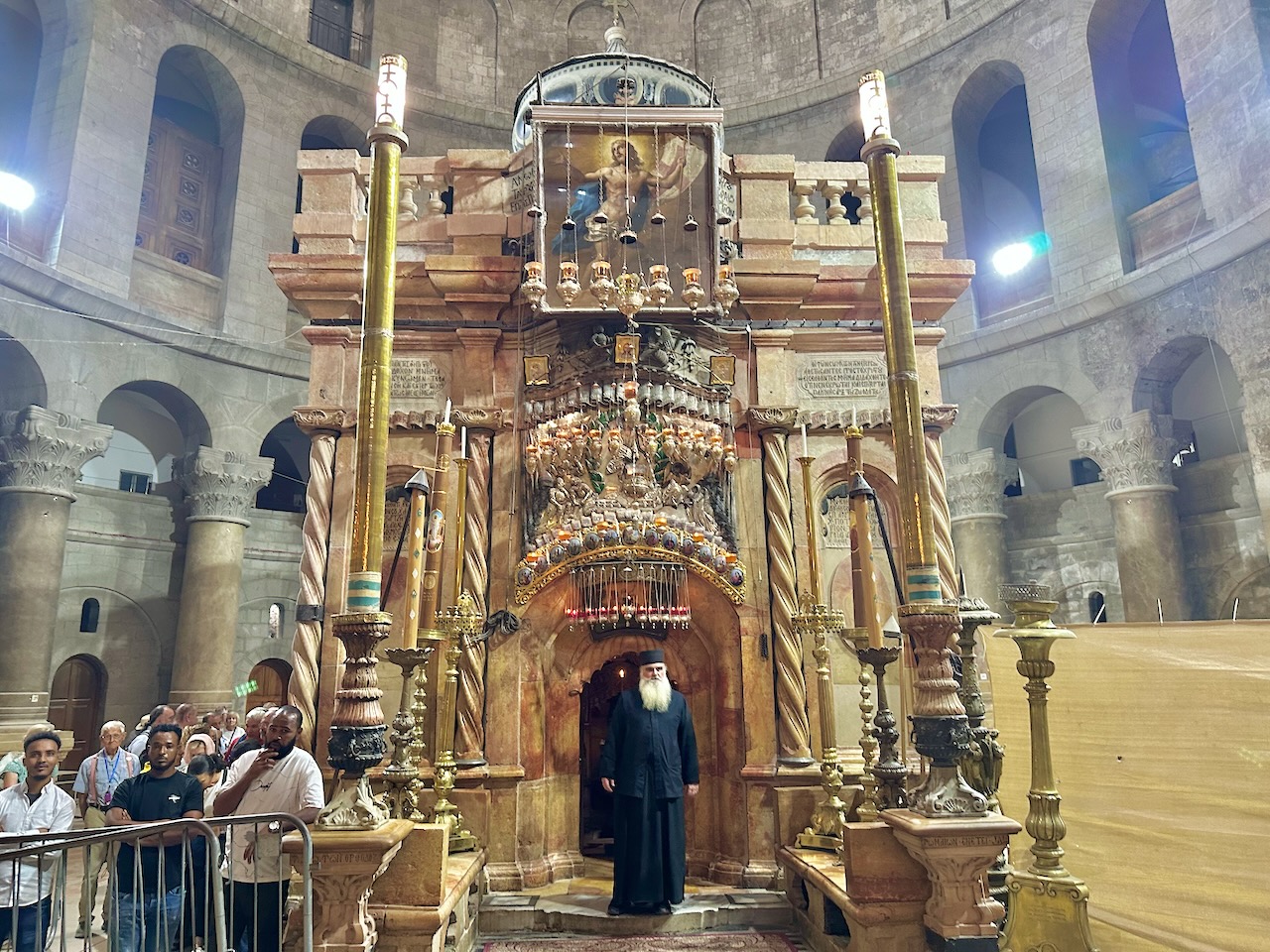

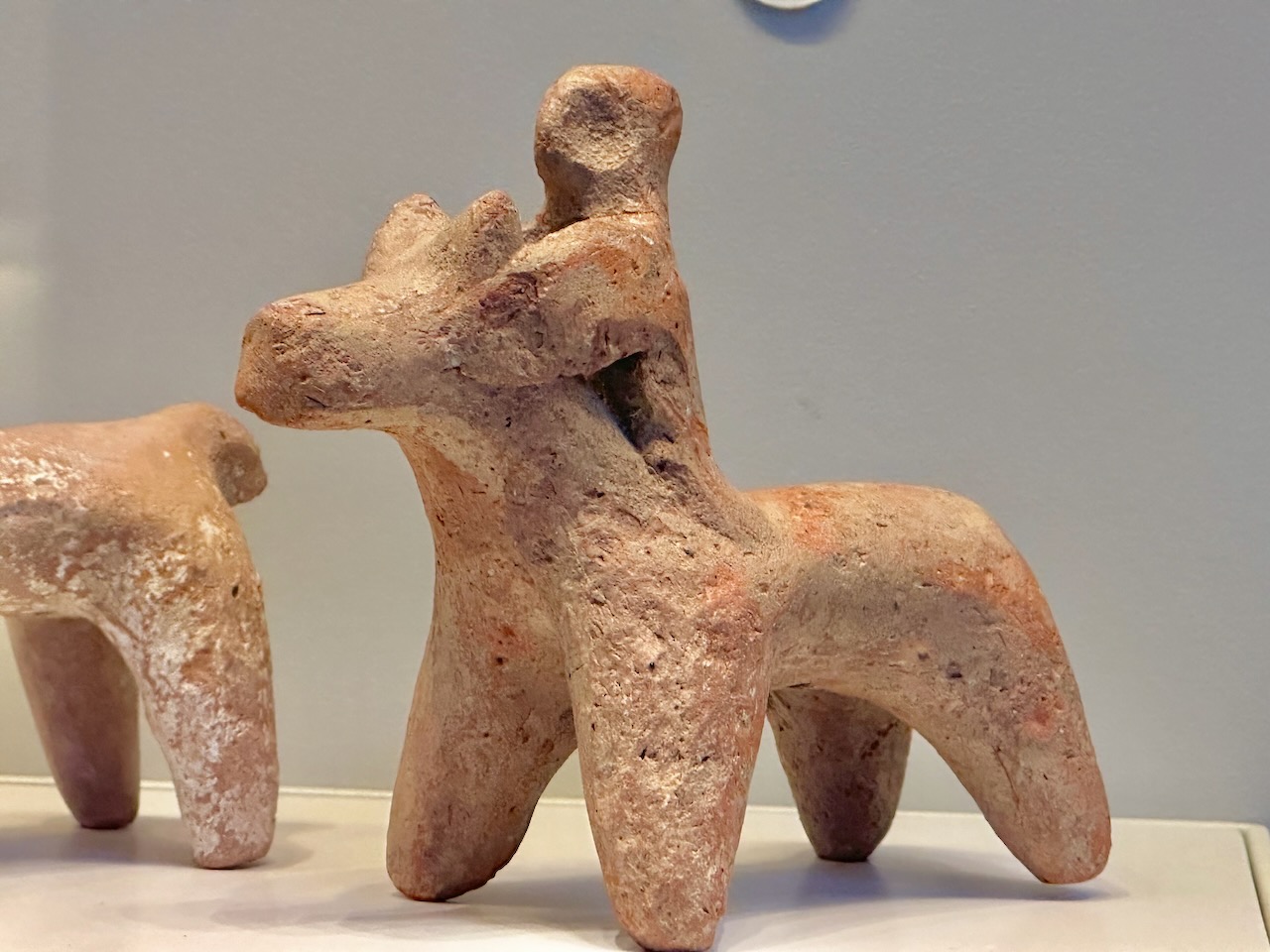
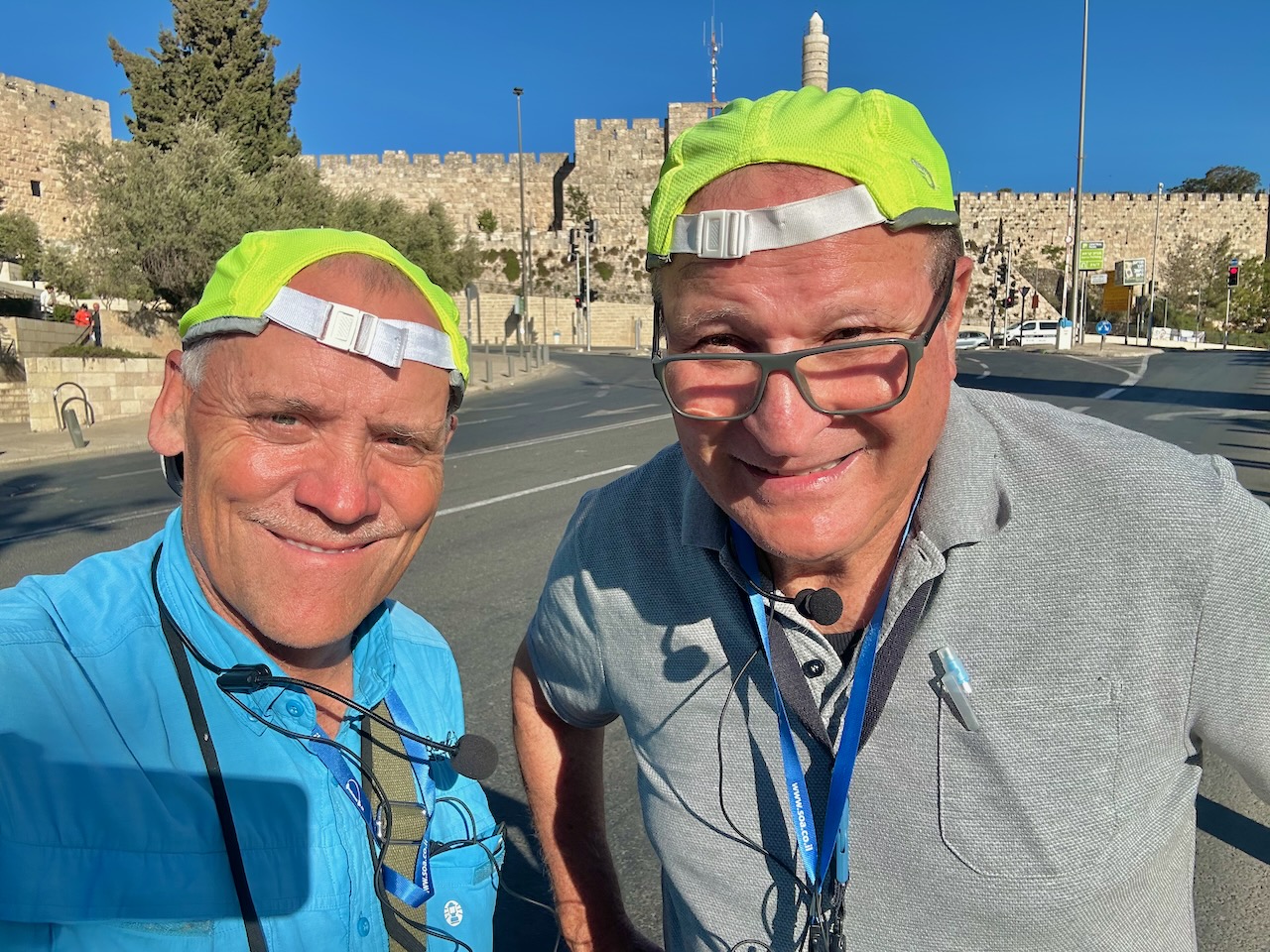
Day 12 – Sunday, September 14: Yad Vashem, Western Wall & Tunnels, Jewish Quarter, Herodian Mansion, Shorashim
Today was the second-last day of the trip and it was another sunny and bright day, with comfortable highs in the low 80s again. The day began in a solemn way with a visit to the Holocaust Museum. In the afternoon we returned to the Old City. We read from Psalm 137 as we left the hotel at 7:35.
Yad Vashem
Our first stop in the morning required us to drive to West Jerusalem. Here we visited the Israel’s Holocaust Museum & Memorial. It is called Yad Vashem, named after a verse in Isaiah 56:5 that mentions the “memorial and a name.” We first entered and walked through the start of the Avenue of the Righteous. Over 20,000 righteous Gentiles are recognized as saving the lives of Jews. We saw trees dedicated to Oscar Schindler and Corrie ten Boom. We also heard the personal story from Shlomo about his family during this tragic event. He lost 12 family members in Vilna, Poland (pictured). We then walked through the Children’s Memorial and the museum itself. On our own, we ended our visit by walking through the museum. It was a somber experience recalling the horrors of the Holocaust and the loss of six million Jews.
Western Wall & Tunnels
Following our time at Yad Vashem, we drove back to the Old City. First, we entered the Western Wall Tunnels. Here, we saw very interesting things, including the continuation of this western retaining wall to the north and its massive stones (the “Master Course” weights over 500 tons!), a small theater, and ritual bath (miqveh) and a fountain. Coming out of the tunnels, we planned to go to the Western Wall to pray, however because of Mark Rubio visiting this area, it was closed all afternoon. This also canceled our plans to visit the Temple Mount as well.
Jewish Quarter: Herodian Mansion, Shorashim
Because of the change of plans, from here we walked up into the heart of the Jewish Quarter where we first visited the Herodian Mansion. This was a very large house dwelling from the time of Jesus. Some suggest it may have been the house of the High Priest (i.e. Annas, Caiaphas). This newly-renovated site was outstanding!
Near the Hurva Synagogue we also enjoyed an interesting conversation with an Orthodox Jew named Moshe at Shorashim. Hearing about his Jewish faith was interesting. His store has many items with biblical connections.
We left the Old City by walking out of the Zion’s Gate where David picked us up to take us back to the hotel. Because of the back-up of traffic, we didn’t get back to the hotel until around 6 pm. A great dinner awaited us at 6:30 once again. It was another great day here in Jerusalem!
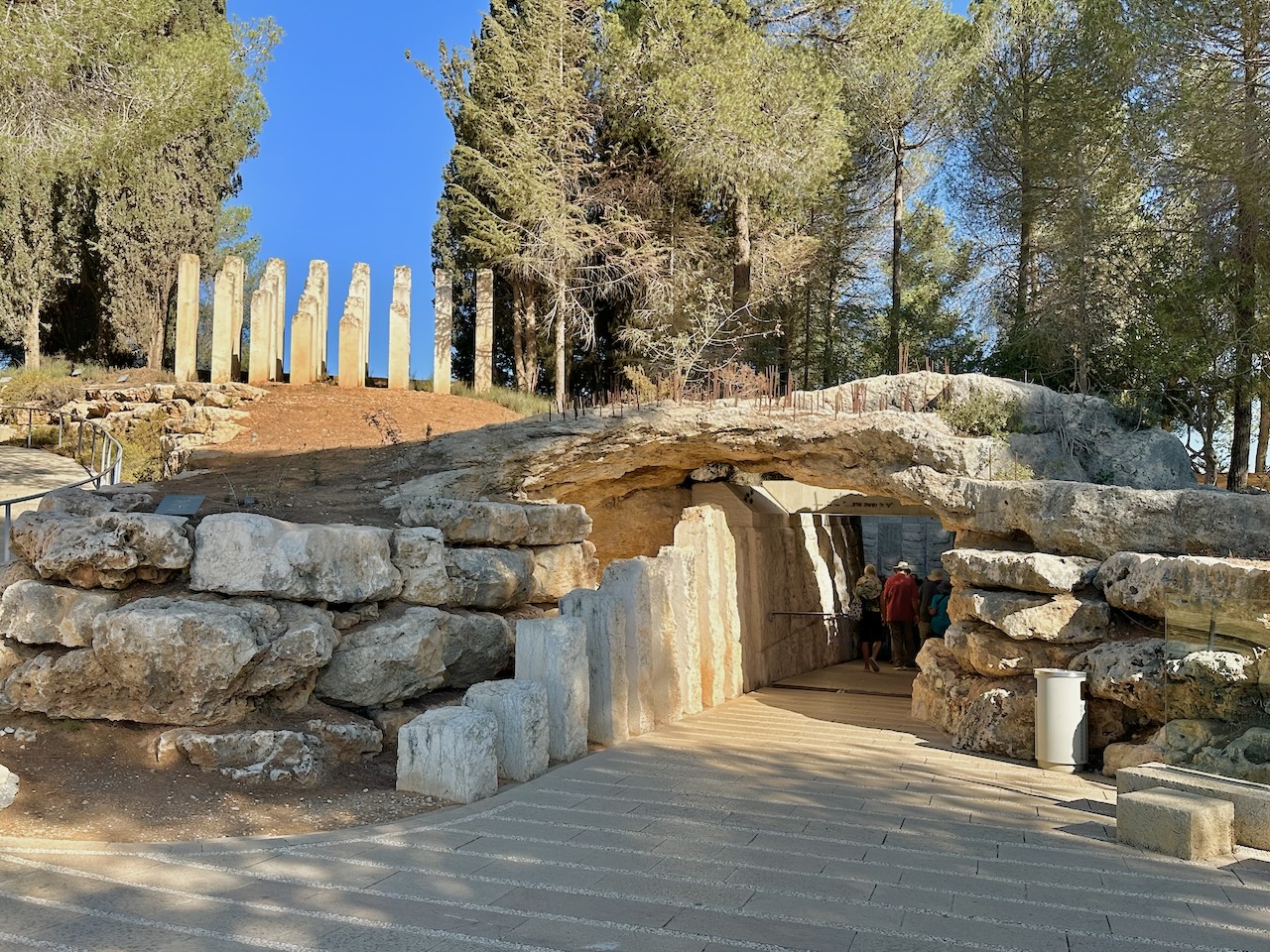



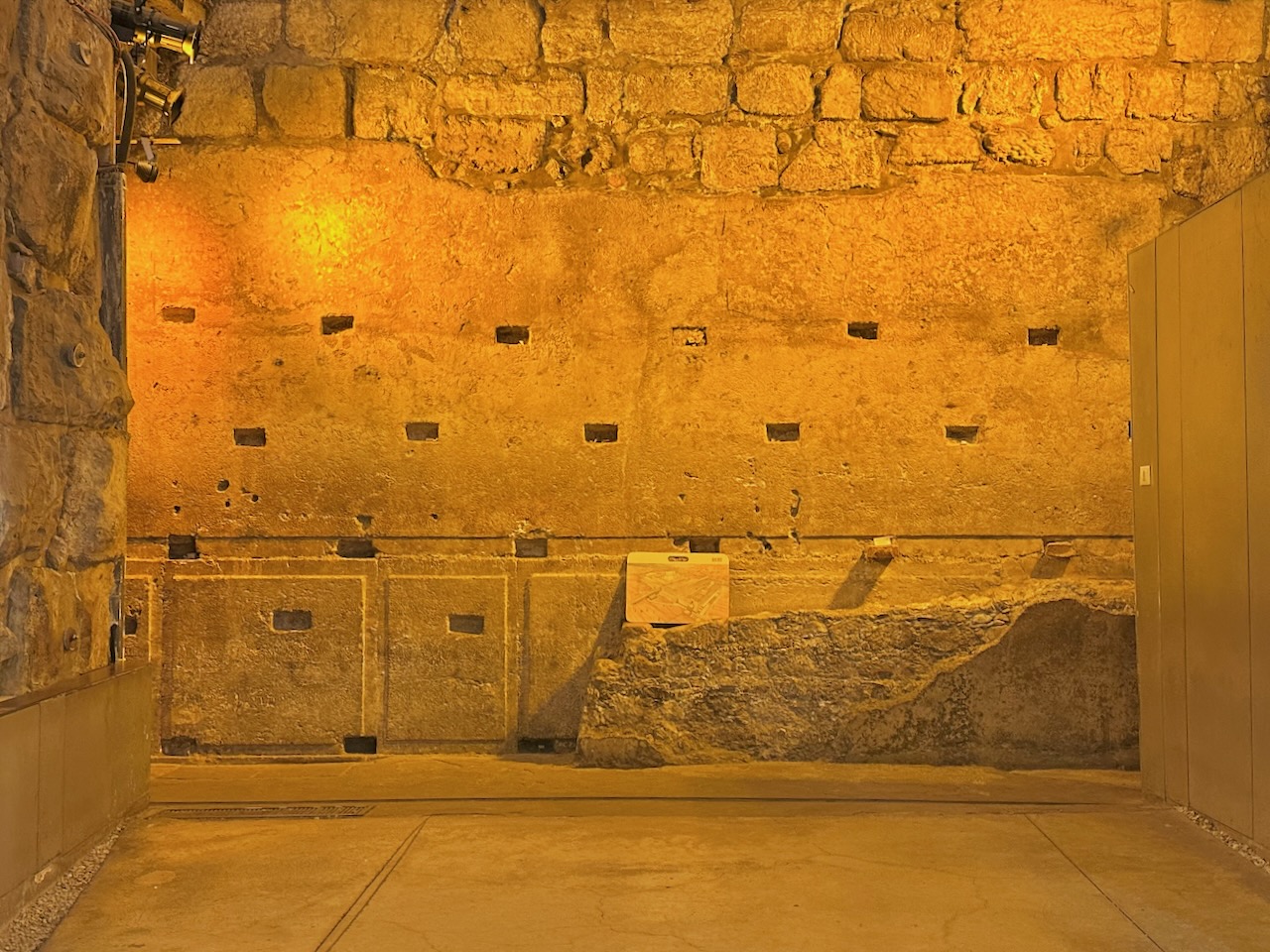
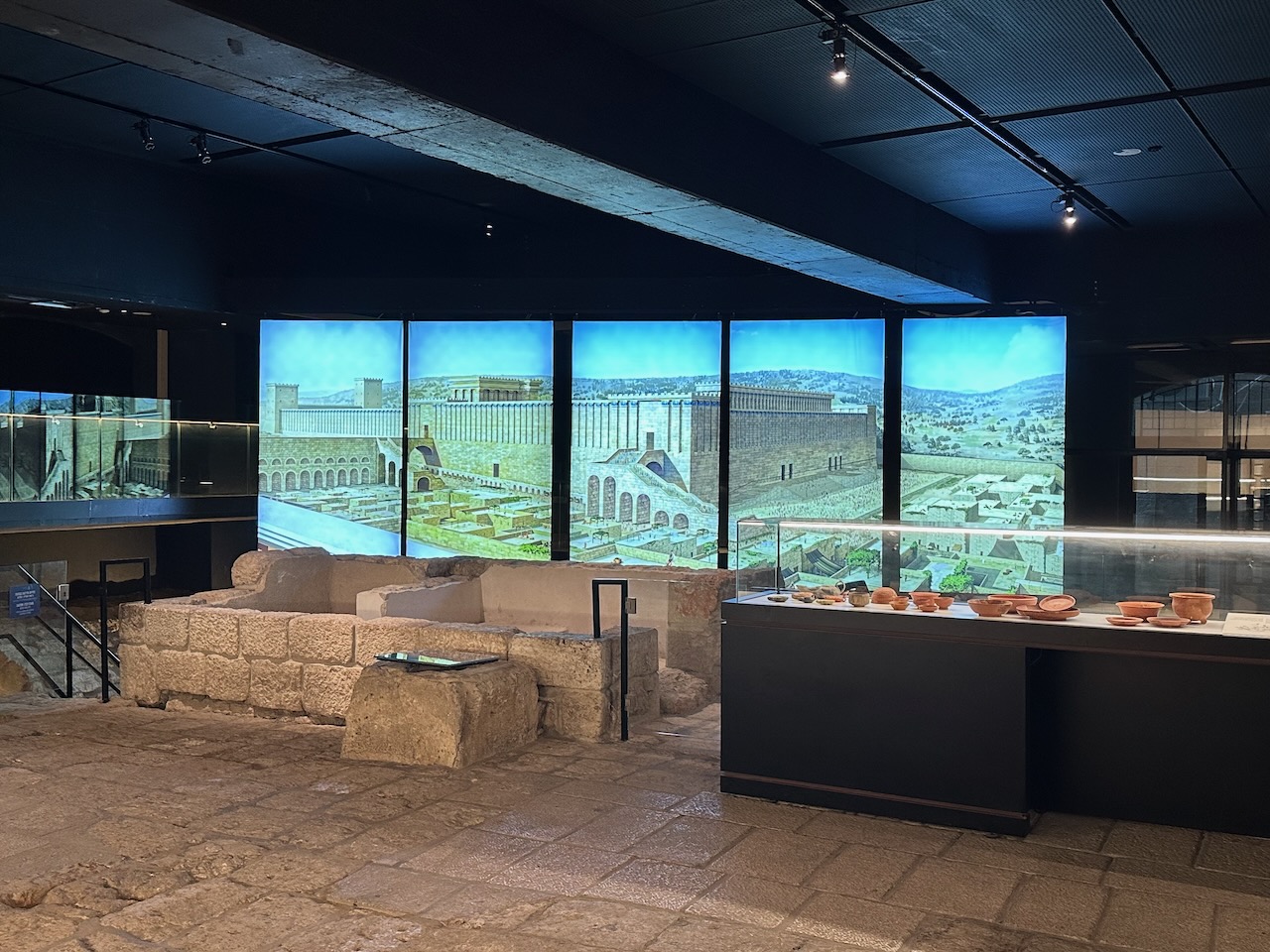
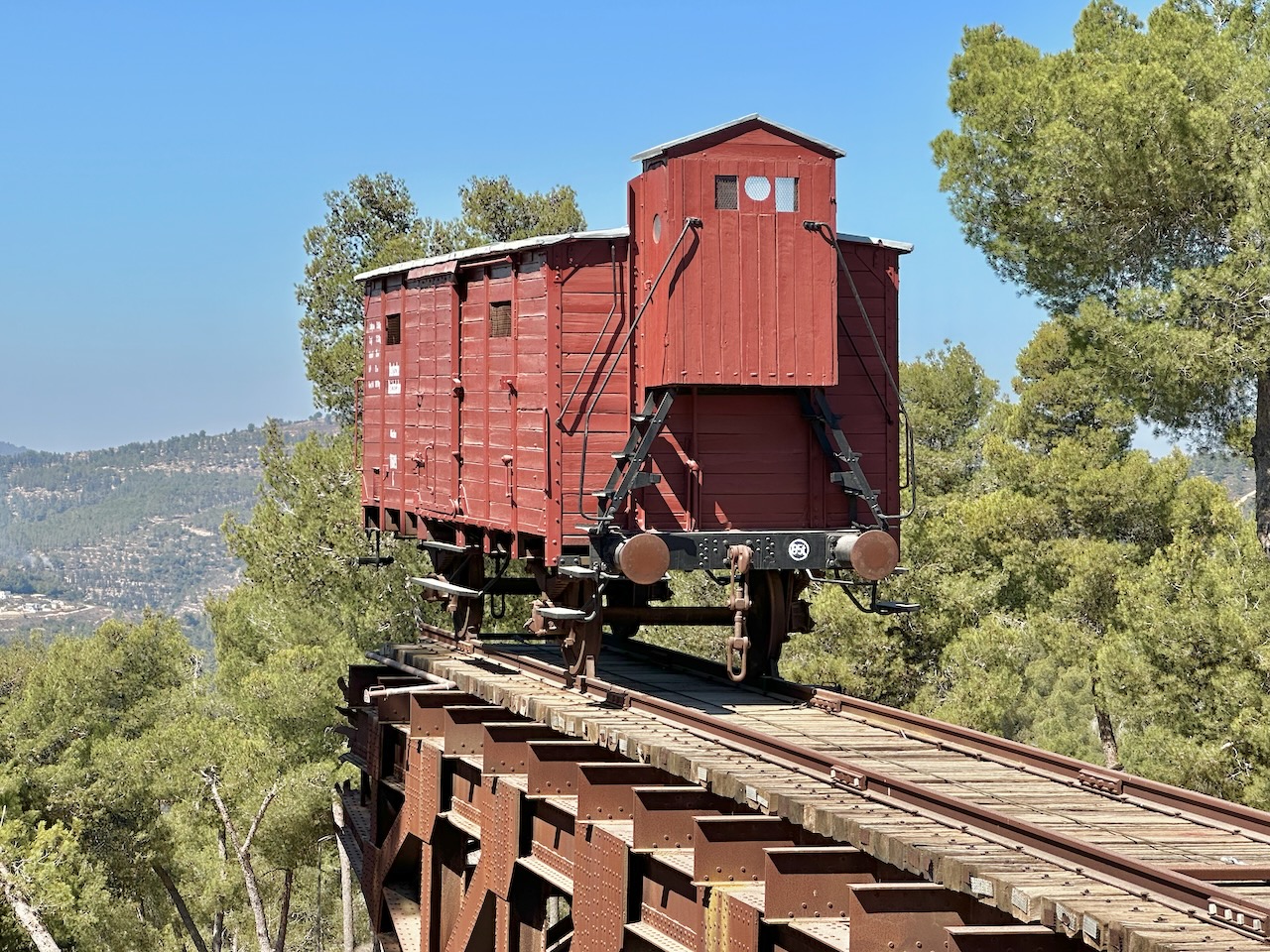
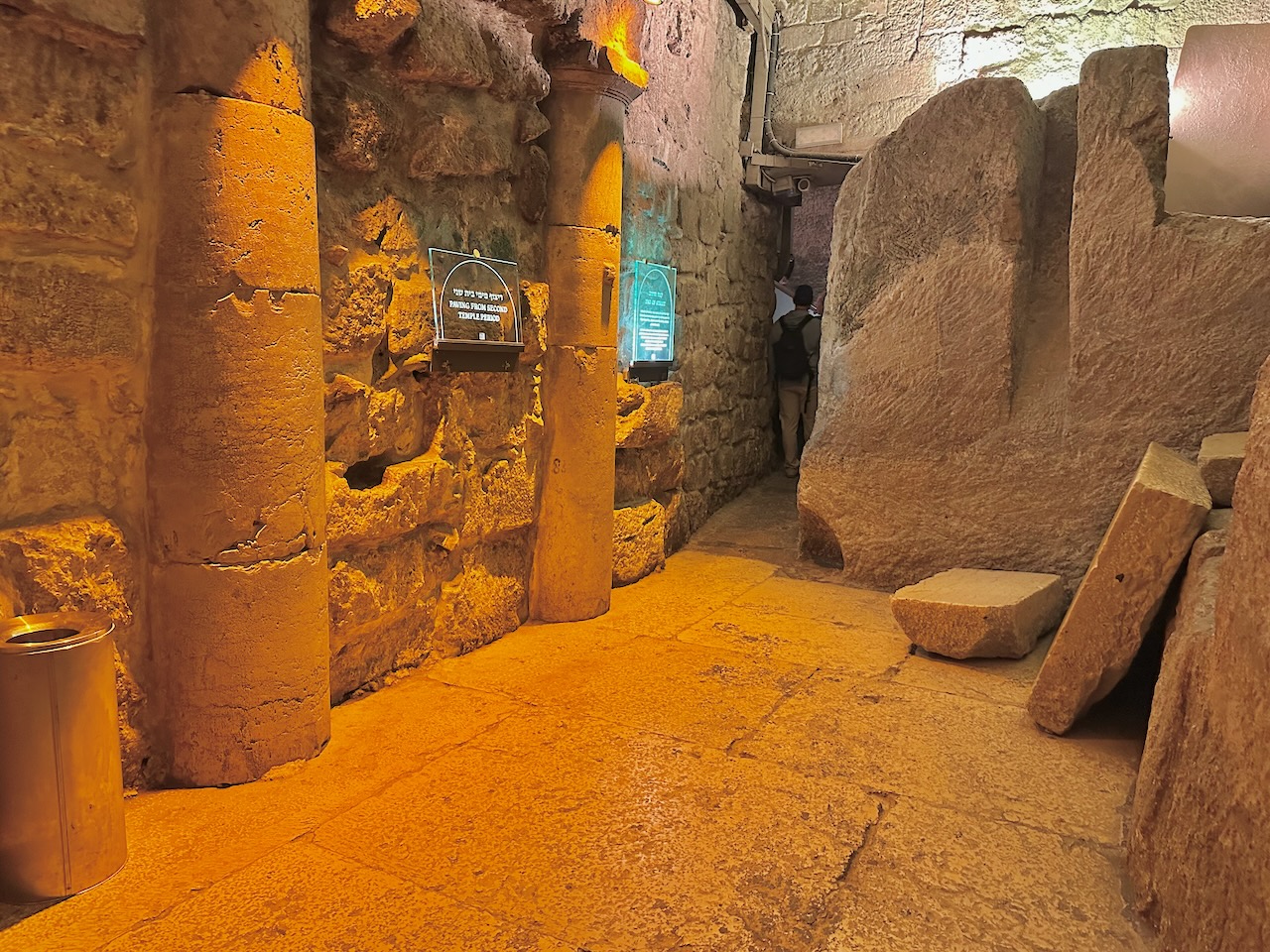
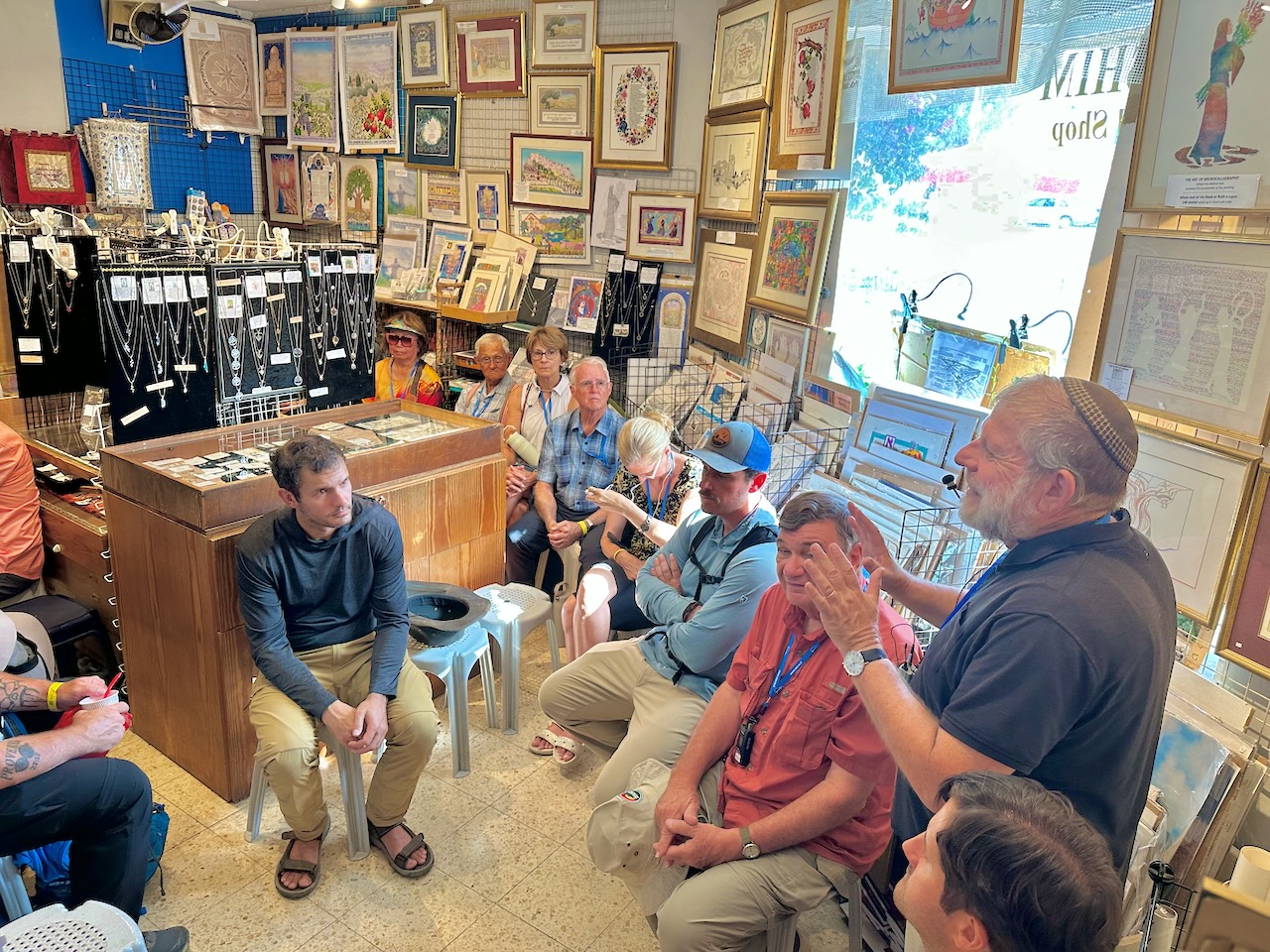
Day 13 – Monday, September 15: Eastern Gate, St. Anne’s Church, Pools of Bethesda, Shiloh, the “Shephelah” (Lowlands) of Judah: Gezer, Beth Shemesh, Socoh
Today was our last full day here in Israel, and it was a good one! We began in the Old City before driving to Shiloh and than to the Lowlands (Shephelah). The weather was perfect again, with full sun and highs in the 80s. We read from John 5 was we left the hotel at 7:30.
Eastern Gate, St. Anne’s Church, Pools of Bethesda
We drove to the NE corner of the Old City and walked to the Eastern Gate. This gate has been closed since 810 AD, with it open only a short time during the Crusader Period. It is also referred to as the Golden Gate. Its other name was the Shushan Gate (out of which the Escape Goat was taken to the Judean Desert). In 1969 an arch was found below the gate on the south side. This was probably a supporting arch for a staircase leading into the gate.
We then entered the Old City of Jerusalem through the St. Stephen’s Gate (also called the Lion’s and Jericho Gate) and went to the St. Anne’s Church. This is a Crusader Church that is known for it’s 7-8 second echo. We had the entire church to ourselves where we enjoyed singing a number of songs together. How incredible our worship was! On the same grounds is the Pool of Bethesda. We recalled the miracle recorded in John 5 while overlooking the steps of this double-pool. Following this visit, we walked back out of the Old City where David picked us up.
Shiloh
Next, we drove into the Hill Country of Ephraim to Shiloh. On the way, we drove throw the Hill Country of Samaria. When we arrived, we made our way up this ancient site where the Tabernacle once stood here for over 300 years. It was destroyed by the Philistines (1 Samuel 4). We watched a short movie about the events that took place here. We also read from 1 Samuel 3 (the call of Samuel) and Jeremiah 7. Among the ruins we saw a massive Middle Bronze wall that was incorporated into the Israelite site. Other structures, including perhaps the Holy of Holies area (as proposed by archaeologist Dr. Scott Stripling) could also be seen. It was young Samuel who said, “Hineni” (“Here I am!”) when God called Him into service.
Gezer
In the early afternoon, we descended west to the Shephelah (lowlands) of Judah. On our way we stopped at a gas-station restaurant honoring Elvis Presley (HA)! It was a fun and unique place with wonderful hamburgers and fries!
Continuing from here, our first stop was Tel Gezer. Located on the Aijalon Valley, this was both a Canaanite and Israelite city, full of walls, towers, and gates. We saw the replica of the “Gezer Calendar.” We also recalled Ecclesiastes 3 about the “seasons of life.” From the observation mound we saw the Aijalon Valley mentioned in Joshua 10 (i.e. the sun standing still over the Valley of Aijalon….) Among the Middle Bronze ruins many of us used the new steel stairway down to the bottom of the water system (175 steps down). This water system was originally used by Canaanites. We then left these Canaanite ruins and continued to the Israelite (Iron Age) area to see ancient house structures and a chambered gate dating to Solomon (1 Kings 9). Walking back to the bus we saw the Canaanite high place and standing stones.
Beth Shemesh
From here we continued south to visit the site of Beth Shemesh. Located along the Sorek Valley, Beth Shemesh was a prominent Israelite town known for their many water cisterns. Across the valley is Zorah, the hometown of Samson (Judges 13-16). Further west down the valley was the Philistine city of Timnah where Samson’s first wife was from (only 3.5 miles away). We also read the narrative of 1 Samuel 6 about the Ark of the Covenant being returned to Israel by the Philistines living in Ekron. We could see the story unfold right before our very eyes! The battle between Amaziah and Joash also took place here (2 Chronicles 25).
Socoh
Our last site on our way back to Jerusalem was Tel Socoh. We climbed some of the slope of this ancient city that is located along the heart of the Elah Valley. Socoh is mentioned in the story of 1 Samuel 17 (the Philistines camped on the ride between Azekah and Socoh). King Saul and the Israelites camped on the small ridge on the north side of the valley. It was in this narrow part (in Hebrew, gai) of the valley where David battled Goliath. David faced the battle with this giant in the confidence of the Lord! We can face our battles with the same confidence!
We returned back to the Hill Country of Judah by taking a unique two-land road back to Jerusalem and our hotel. At 6:30 we enjoyed our “farewell dinner.” Rick Ricart, owner of iTT and two representatives from Amiel Tours (our Israel agency) joined us. At 8:30, the North Carolina group bussed to the airport for their 12:45 a.m. site. Nine of us will fly home on a 11 a.m. flight tomorrow morning.
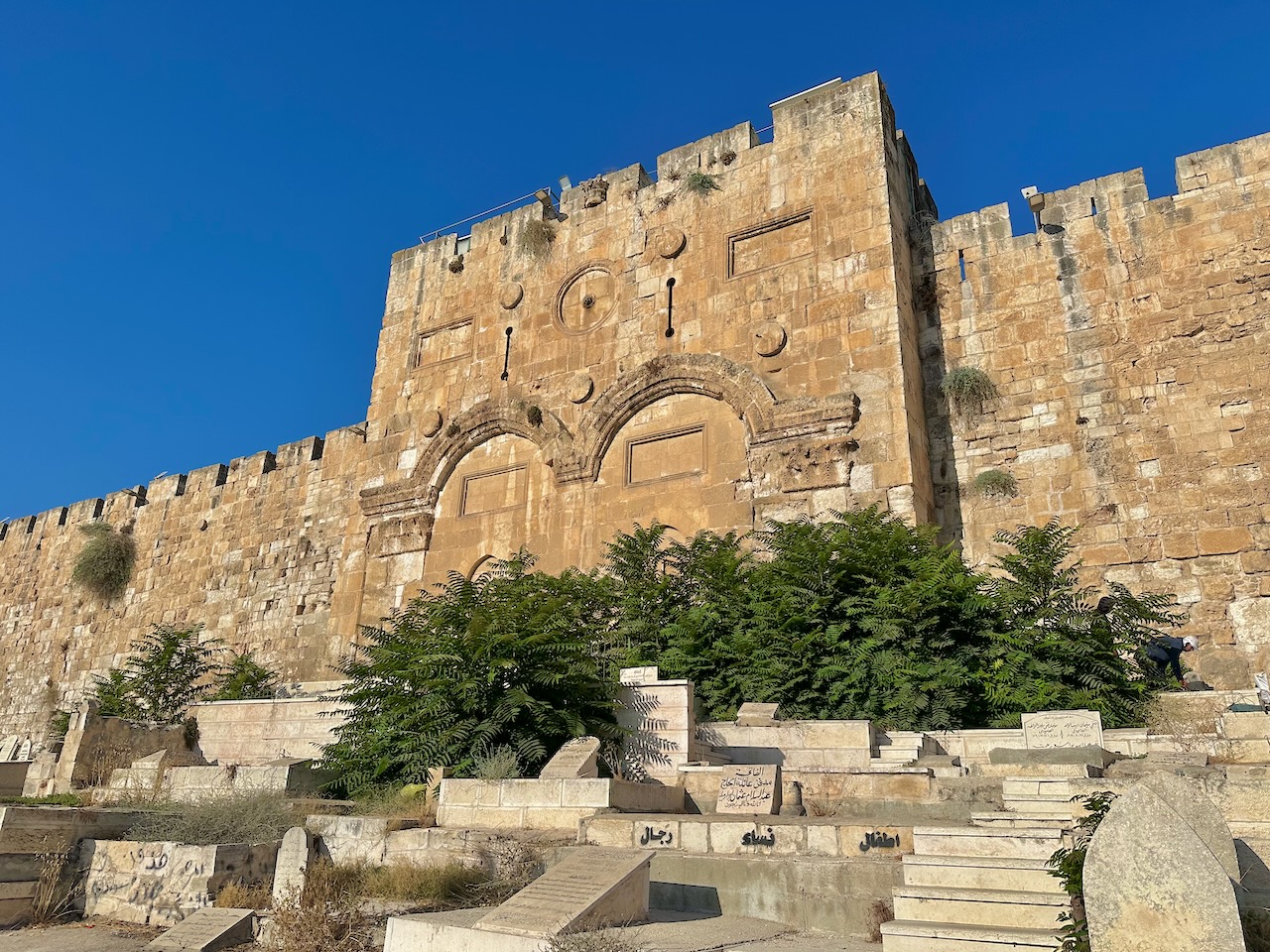
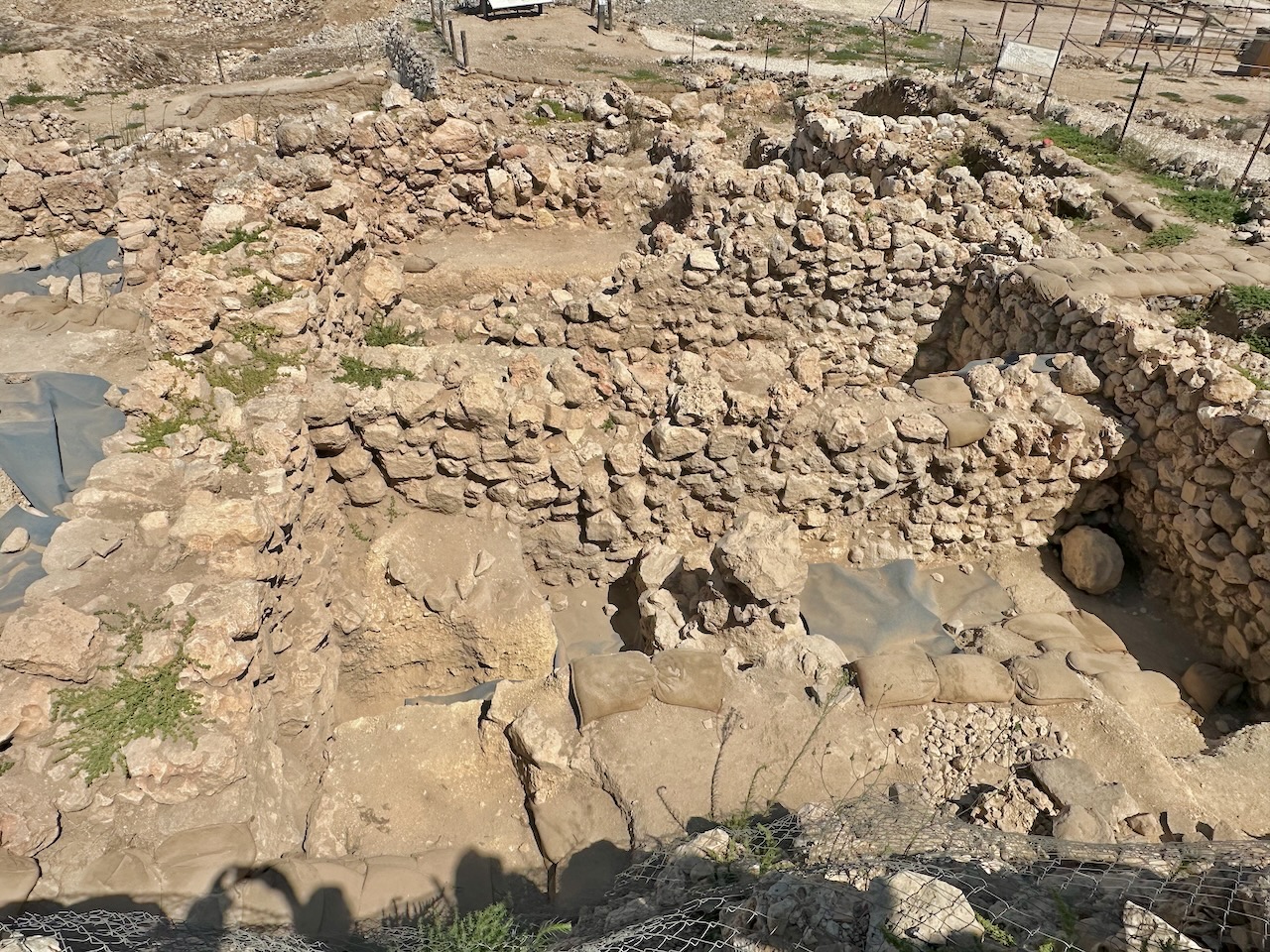
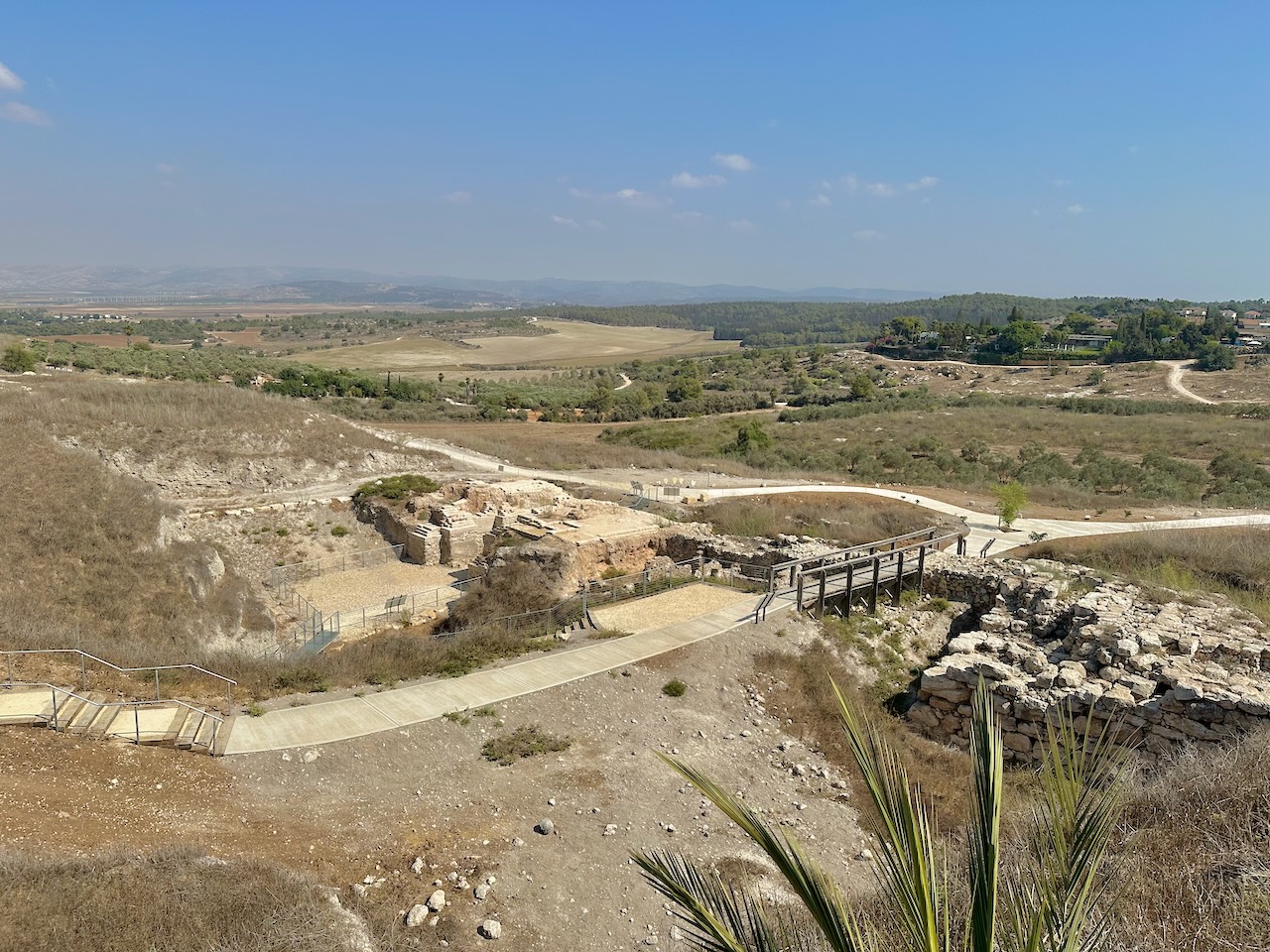
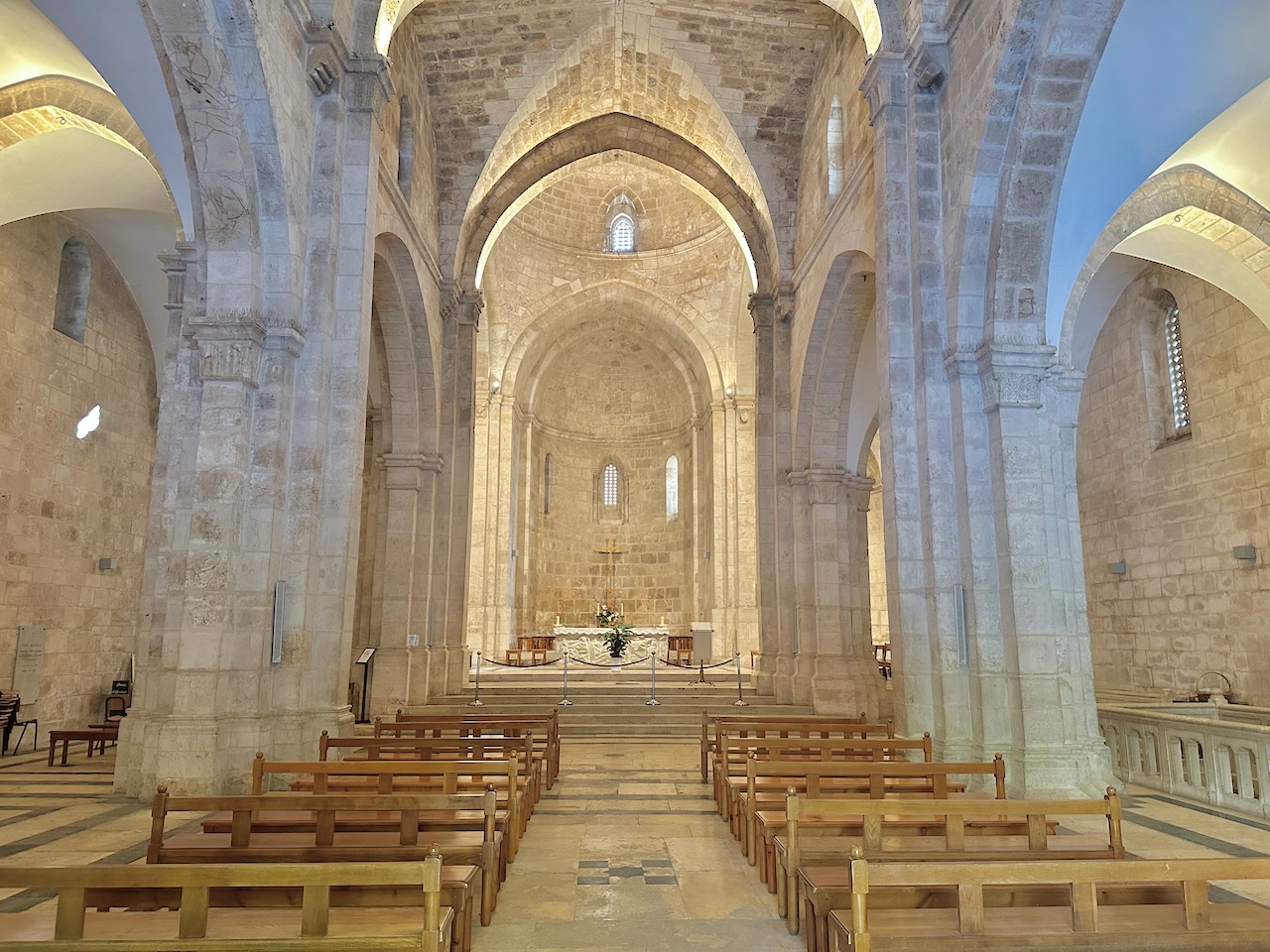
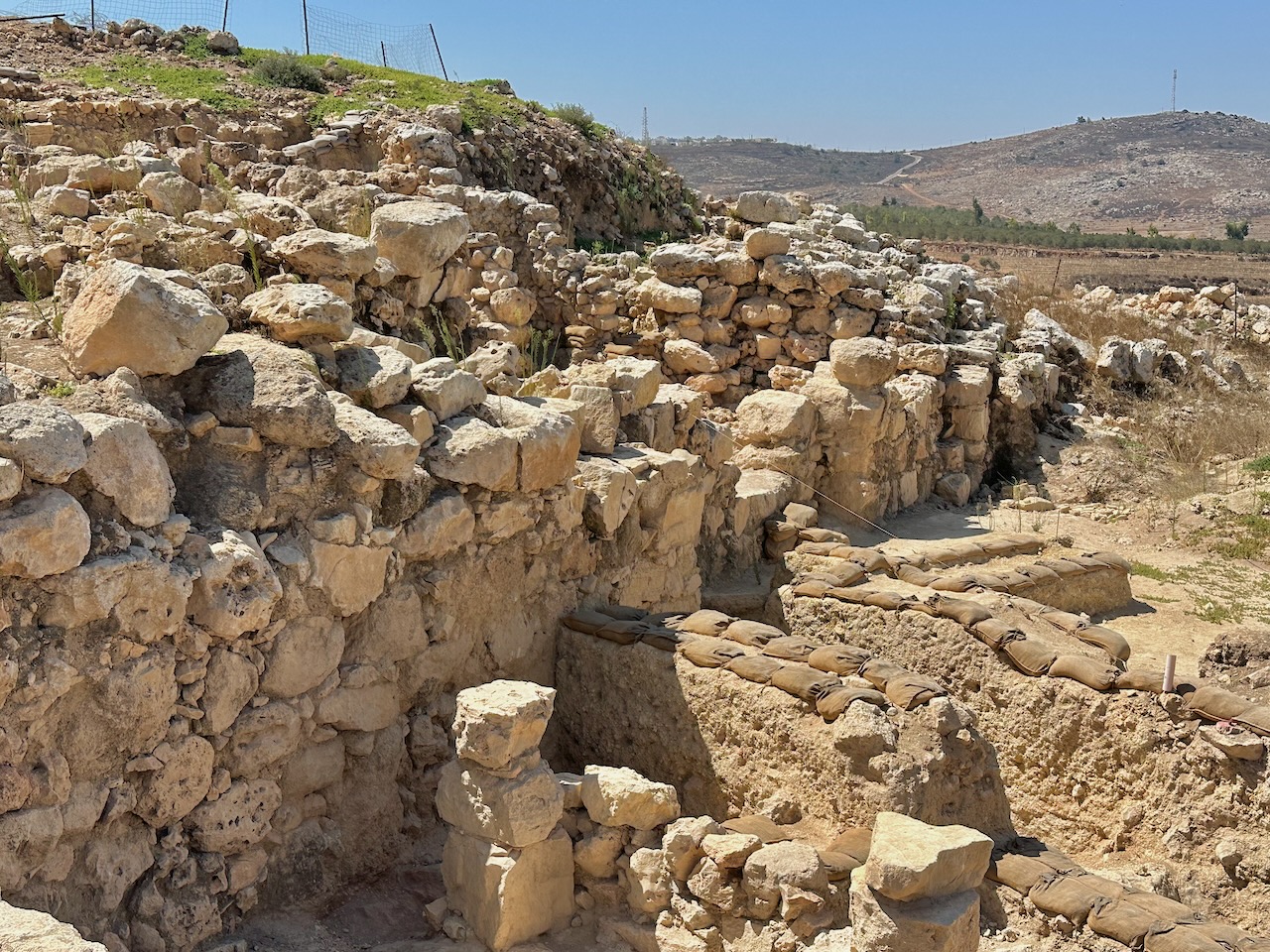
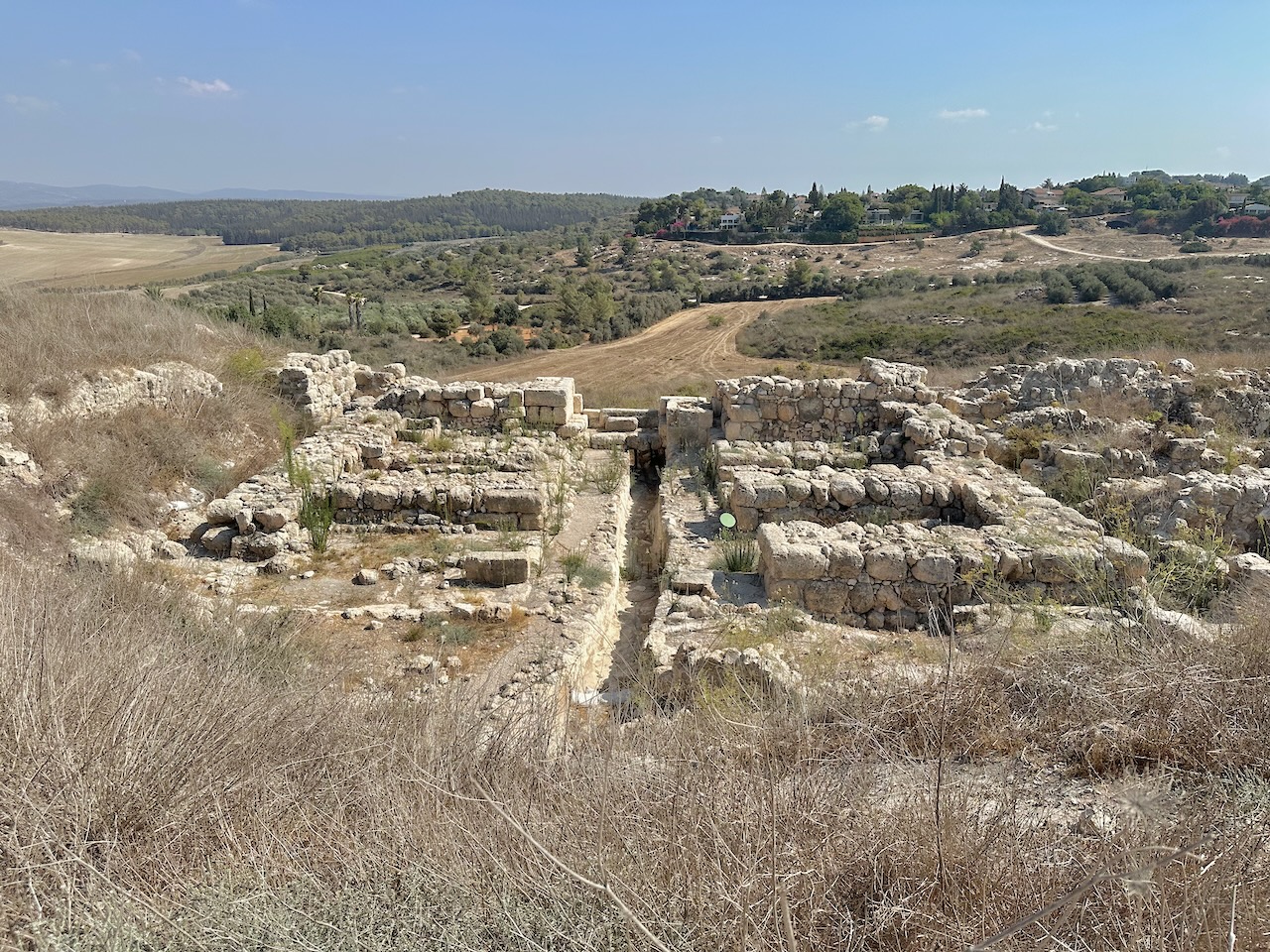
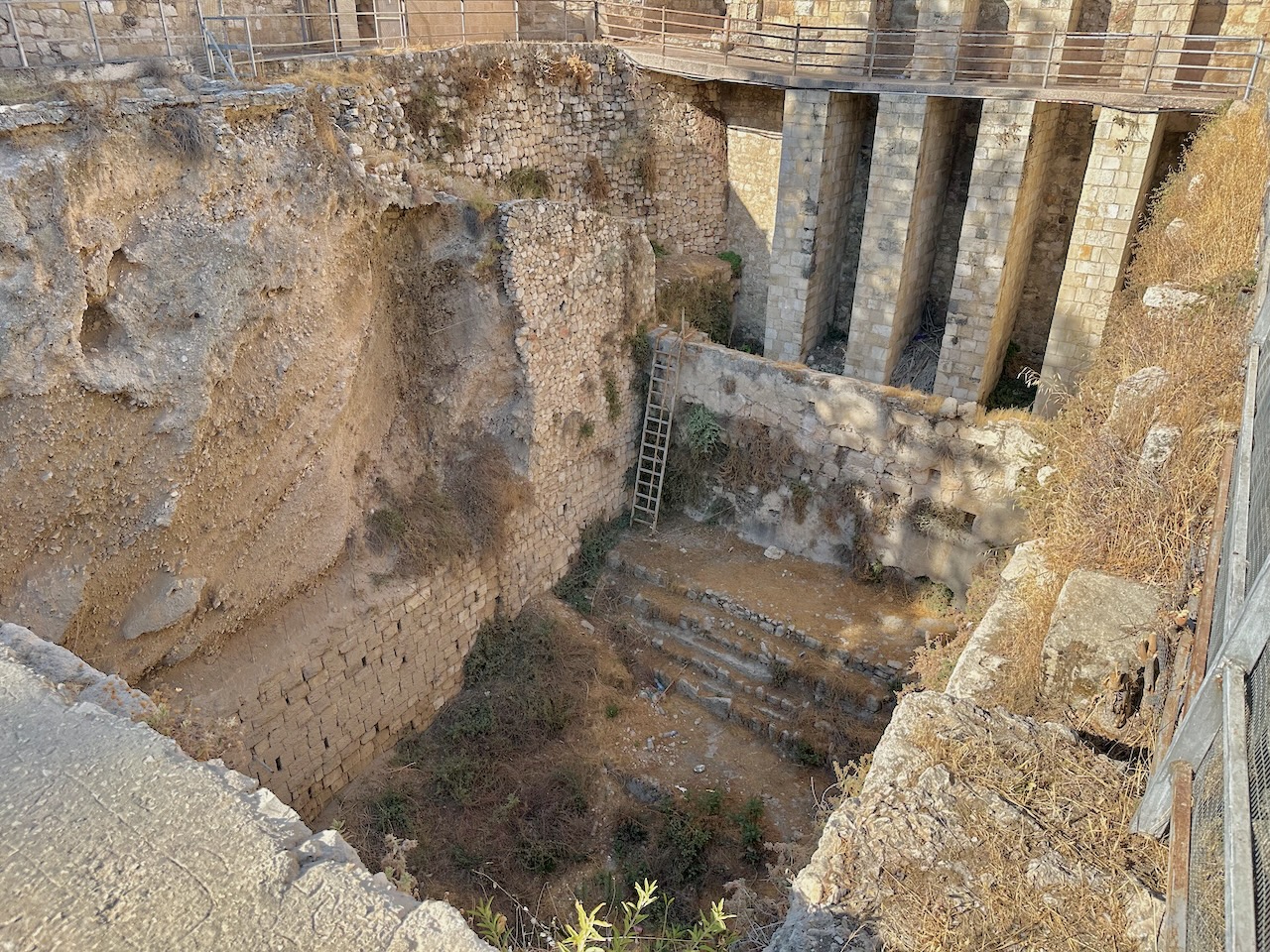
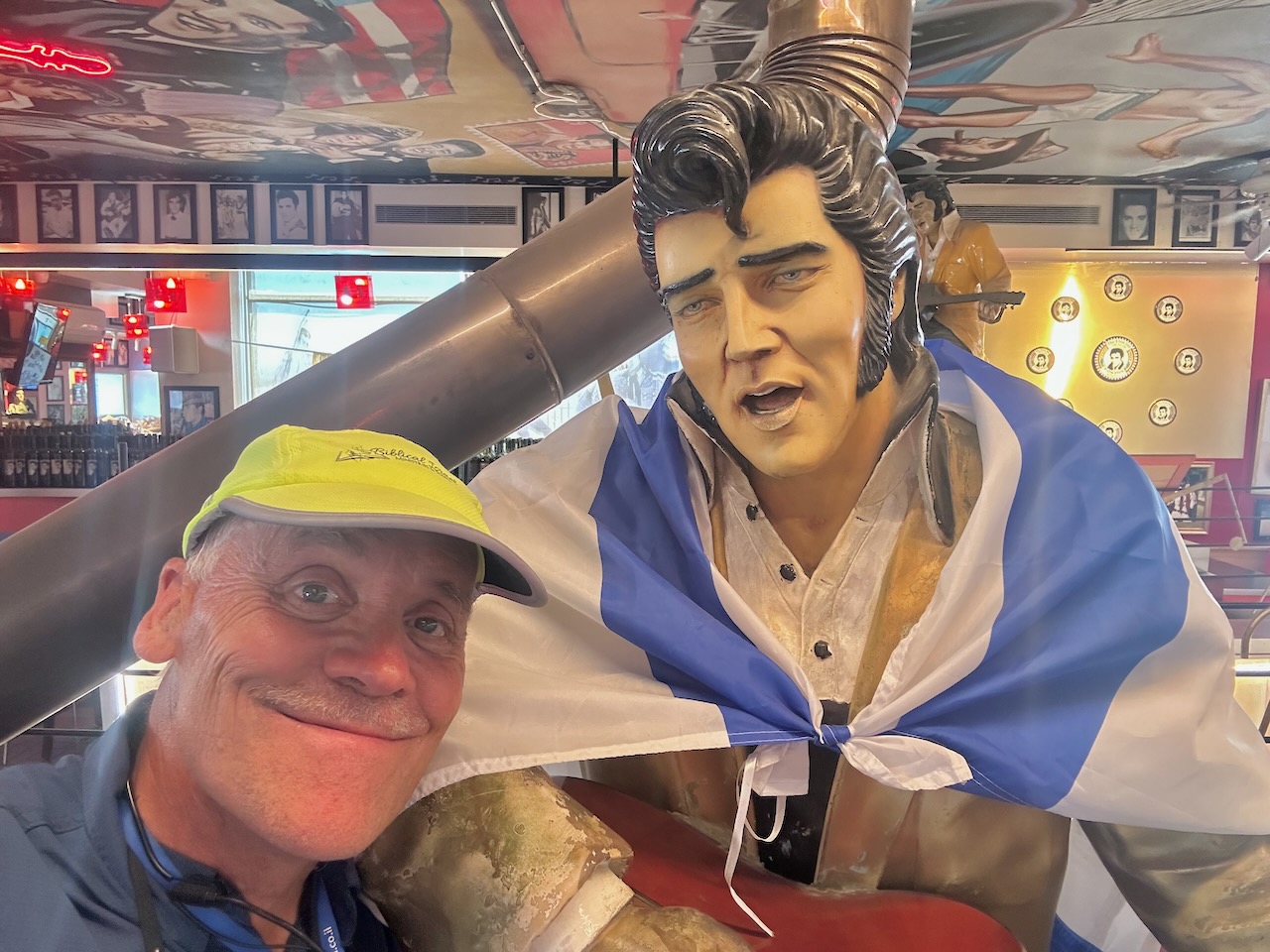
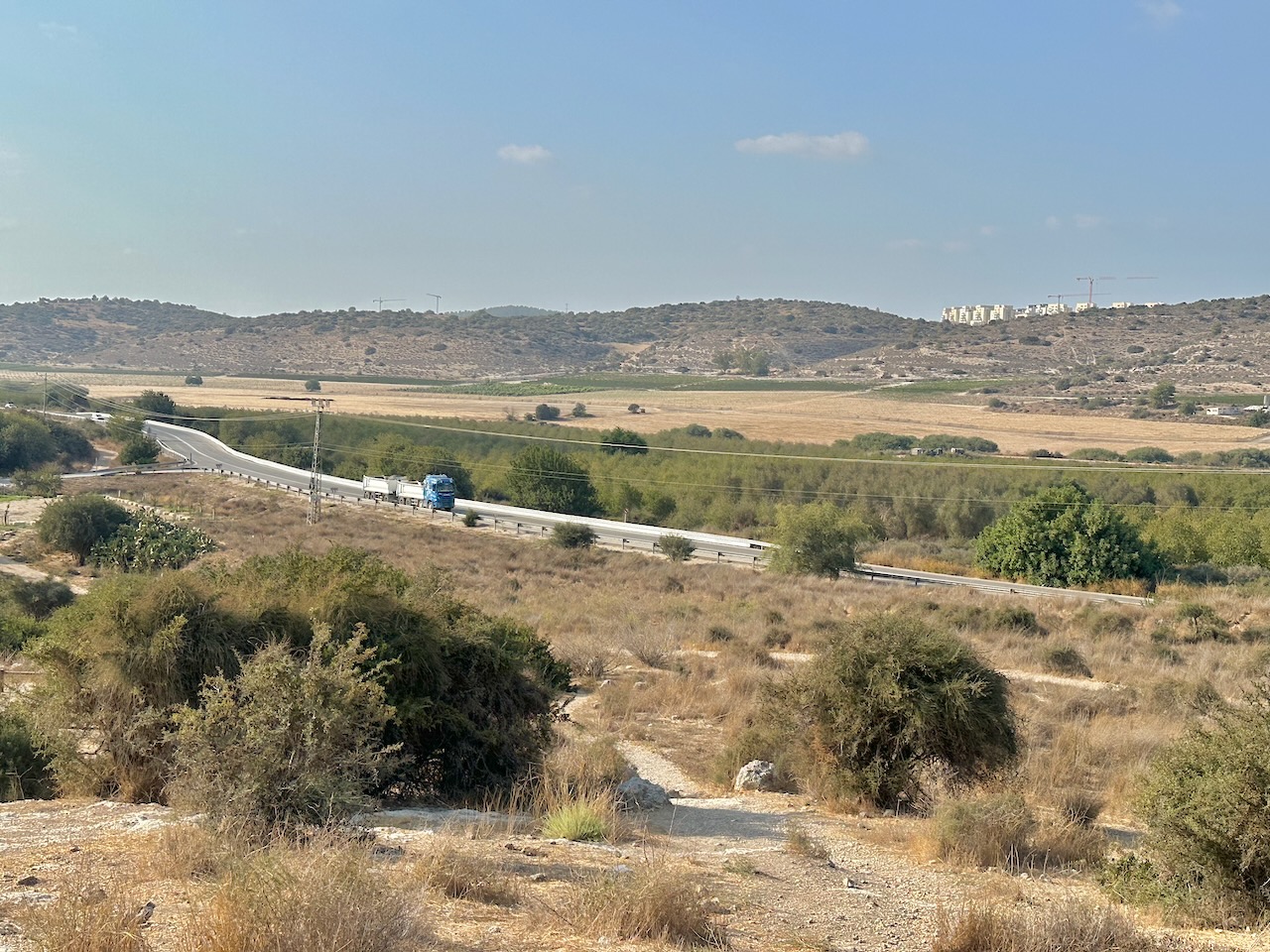
Day 14 – Tuesday, September 16: Arrive Home
We used two different flights to get home. The first flight was re-scheduled for five hours early, and the latter flight was three hours late in take-off. Despite this, we all got home safely!
It was a great trip with. great group of people! Praise be to God!
The Zin Desert
To hike in the Zin Desert is a spectacular experience! Located in the Negev, the 12 Israelites spies came up through this area (Numbers 13). Also, this is where Moses struck the rock (Numbers 20). Within the canyon itself, water still flow all year around here. The high canyon walls and the gentle streams of water provide the perfect setting.
On this June 2020 tour, the Zin is included in the optional extension.
